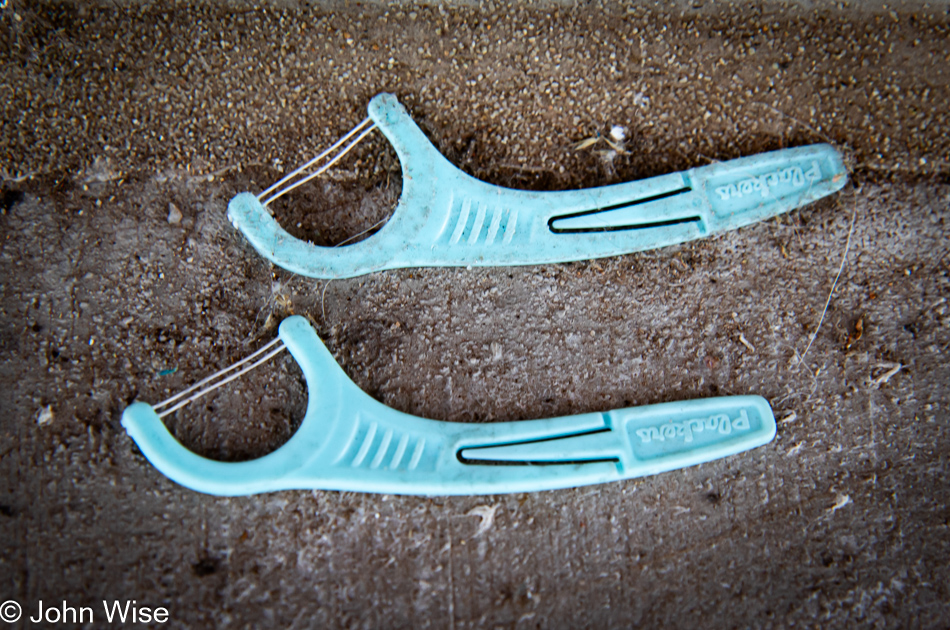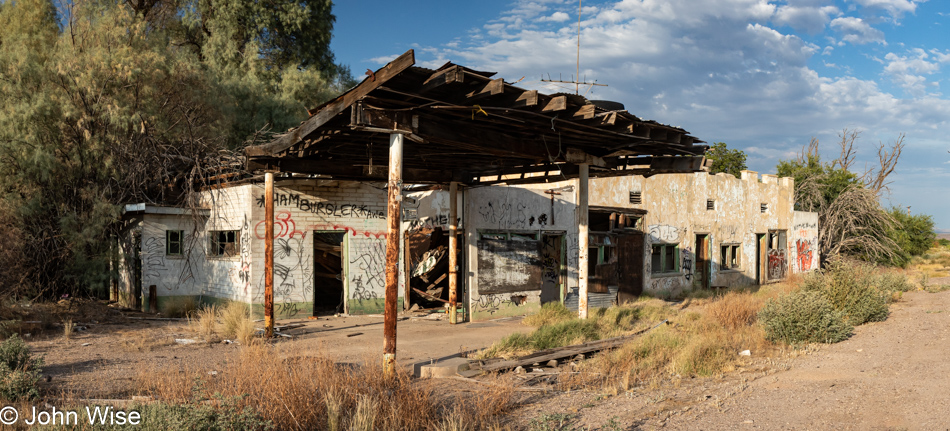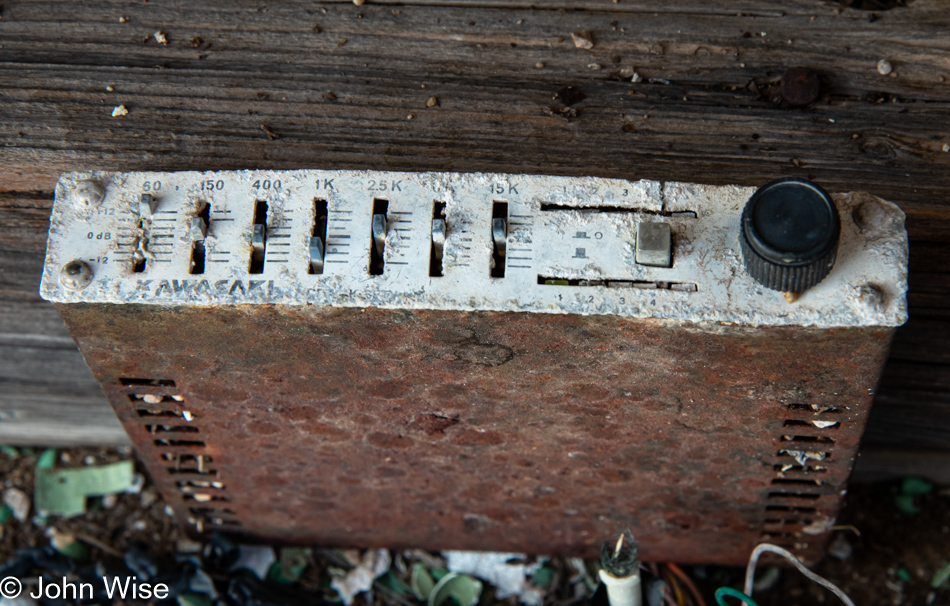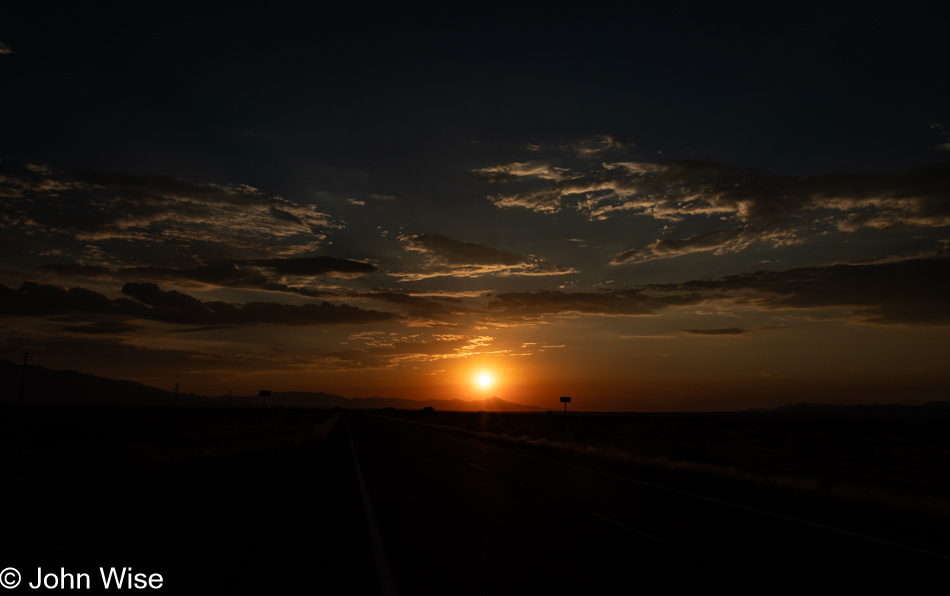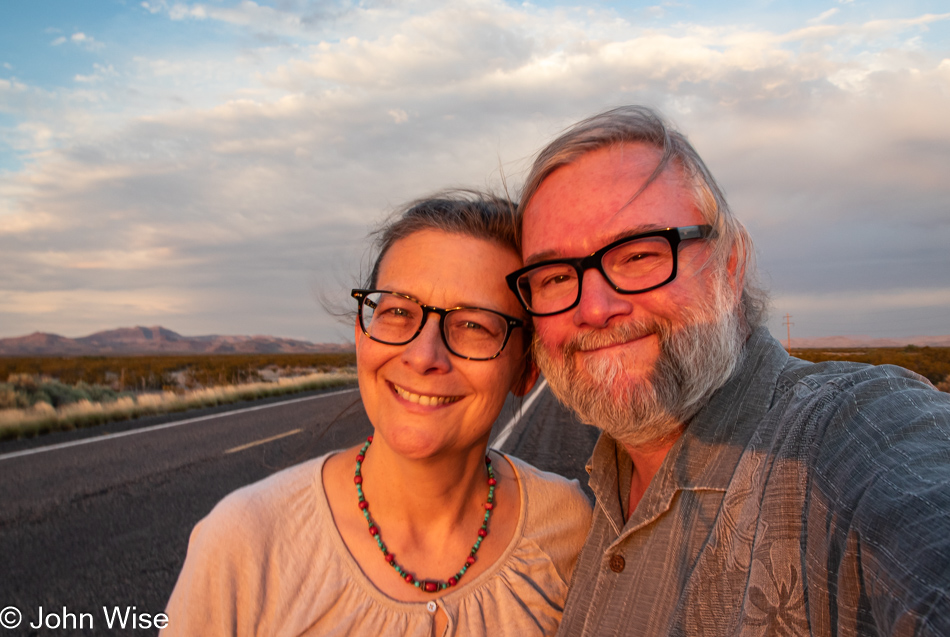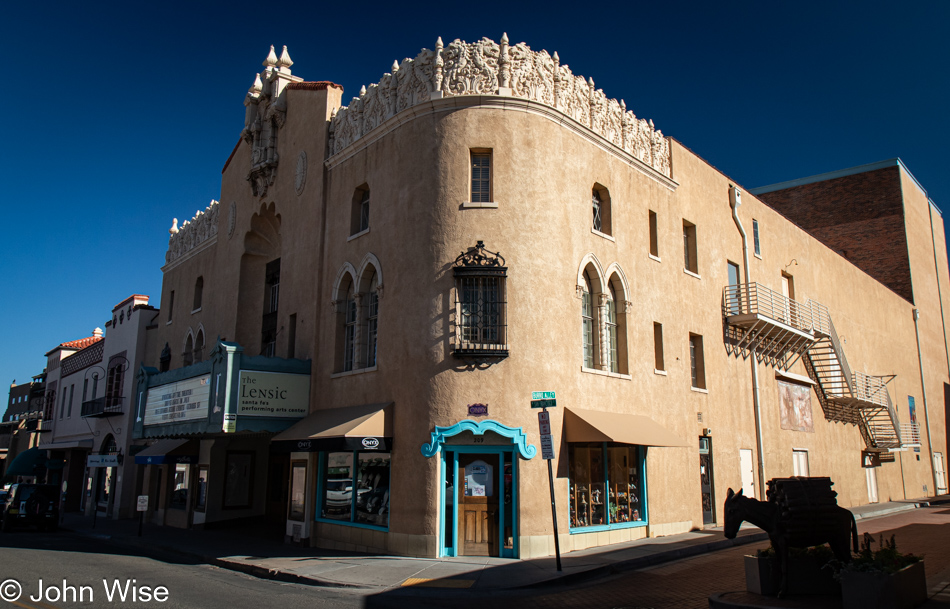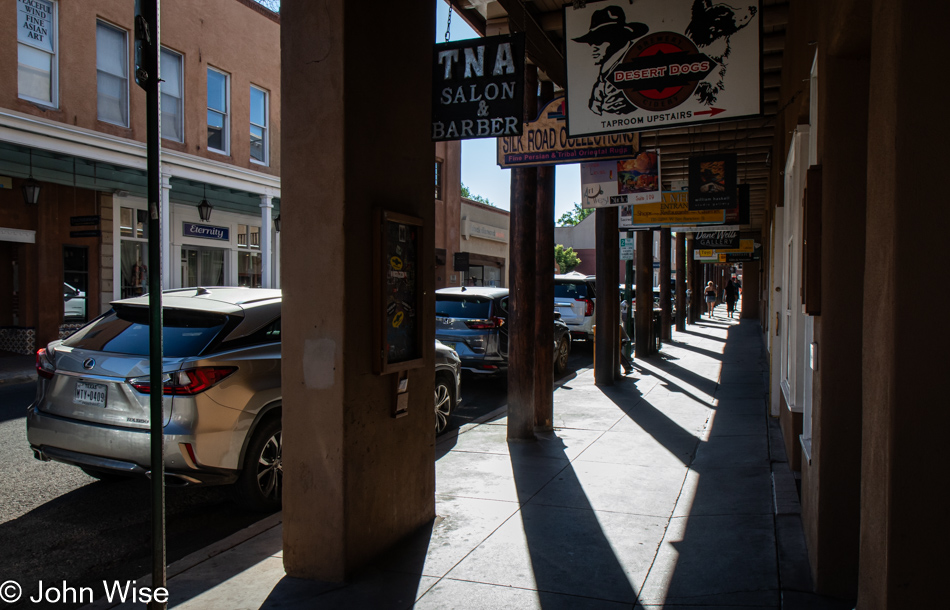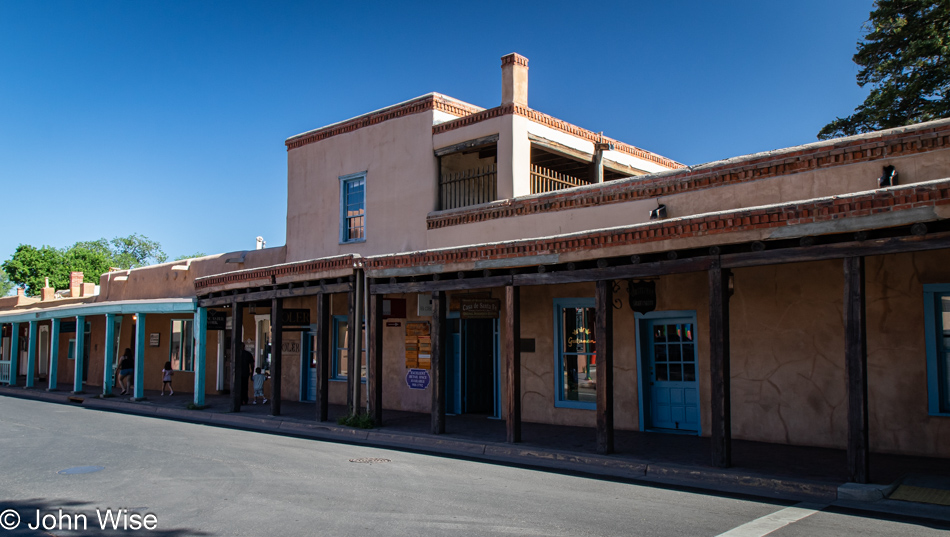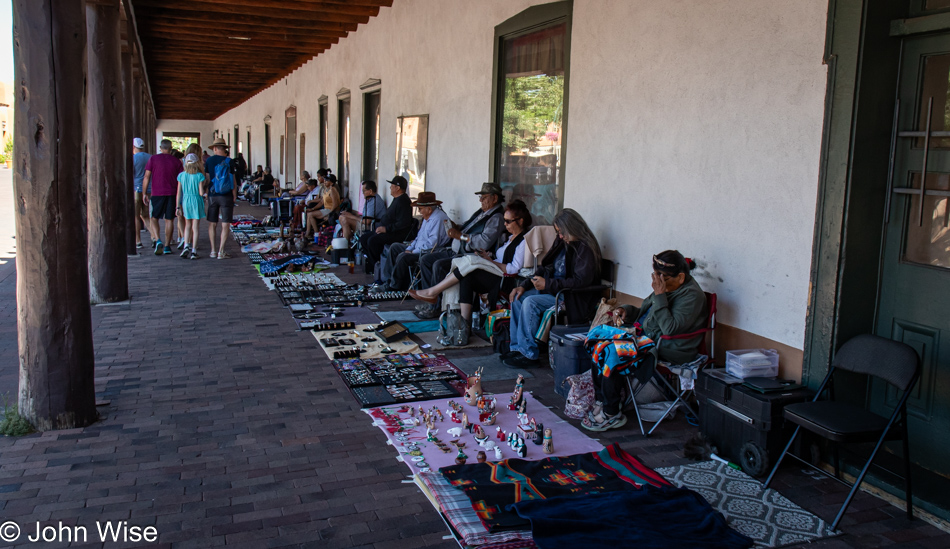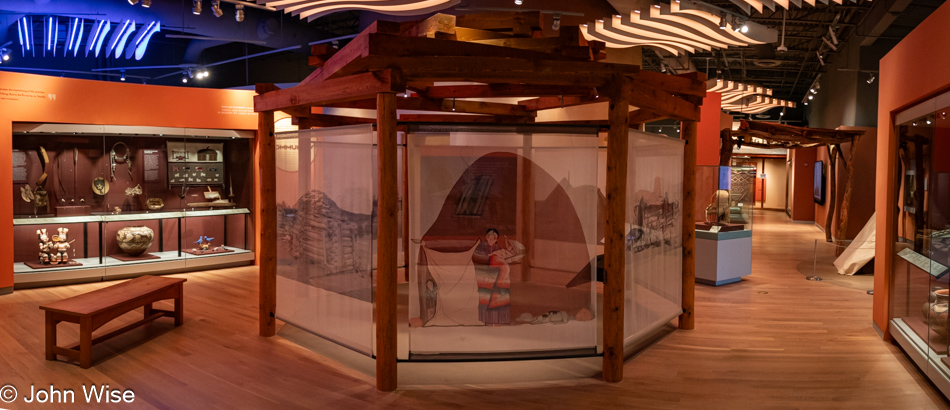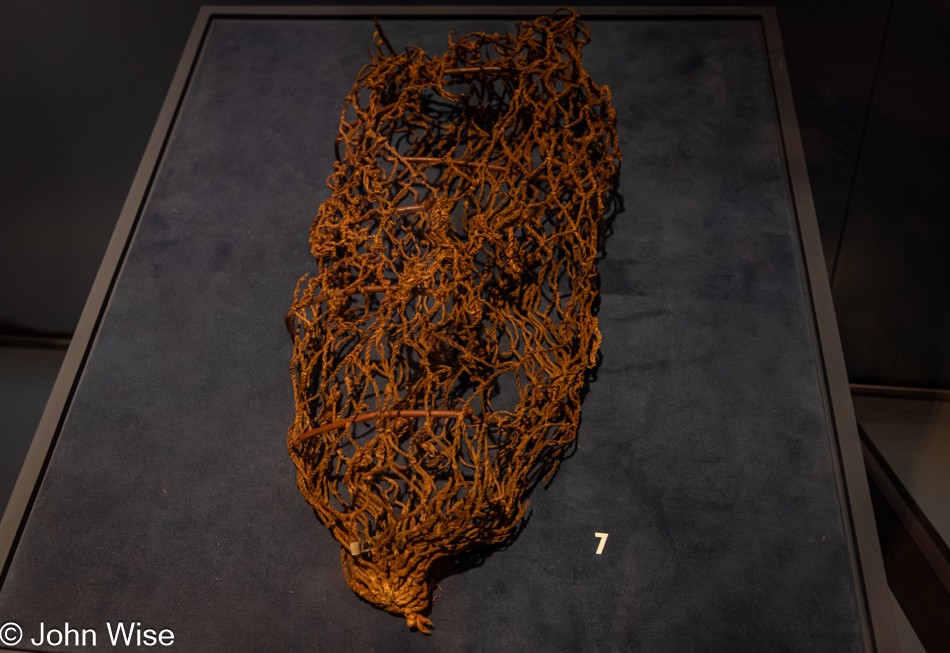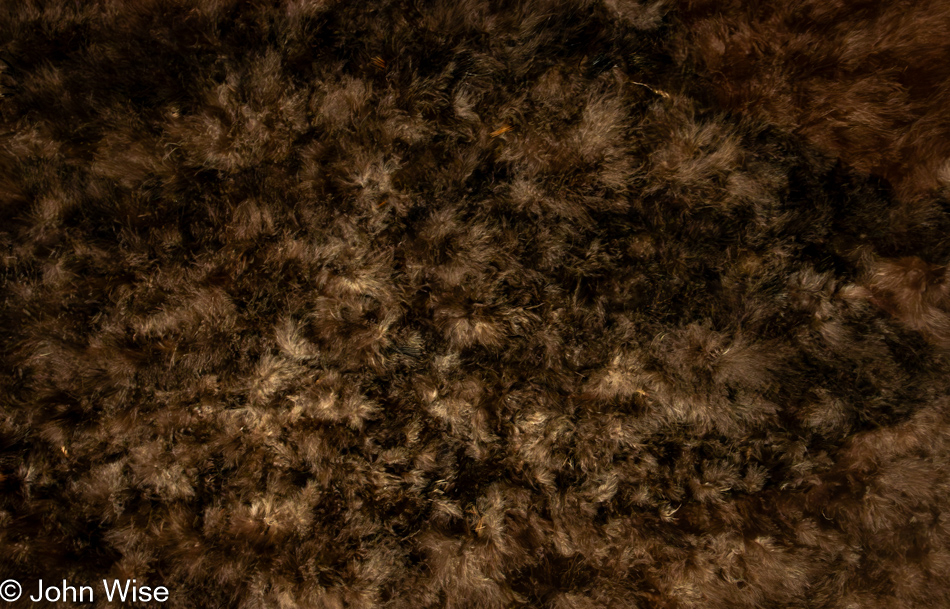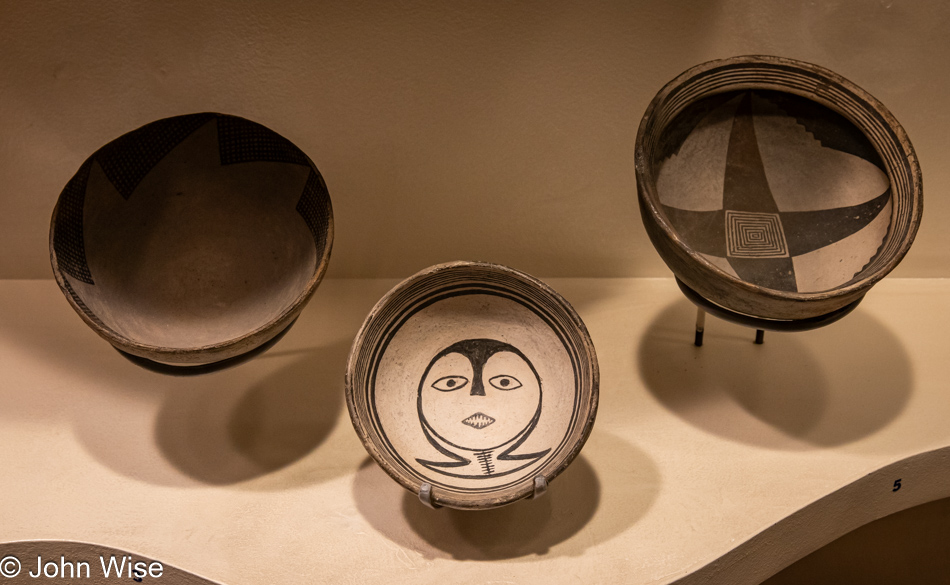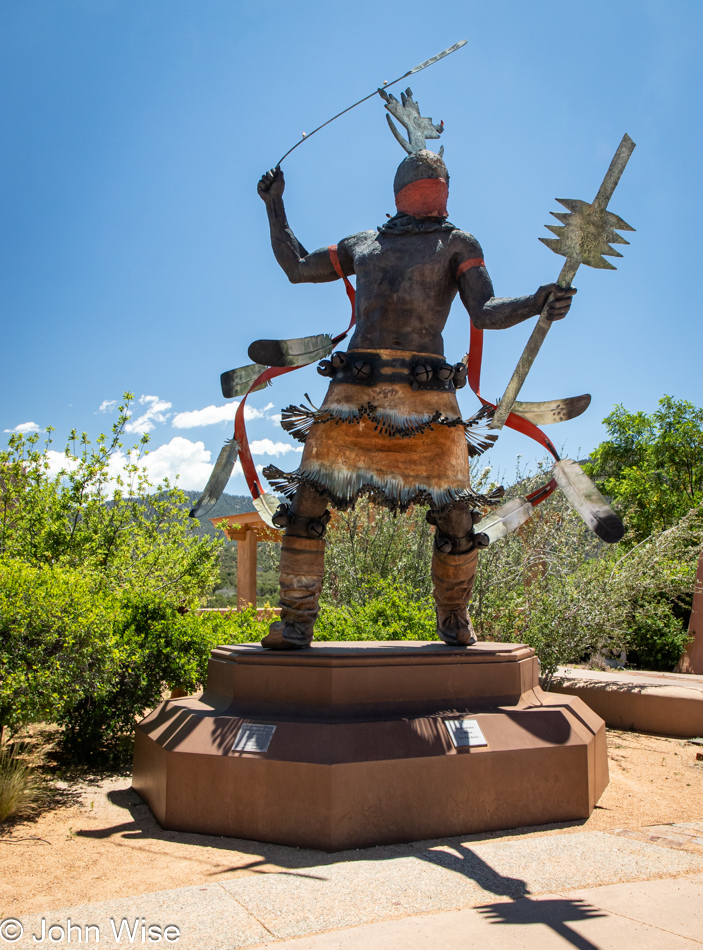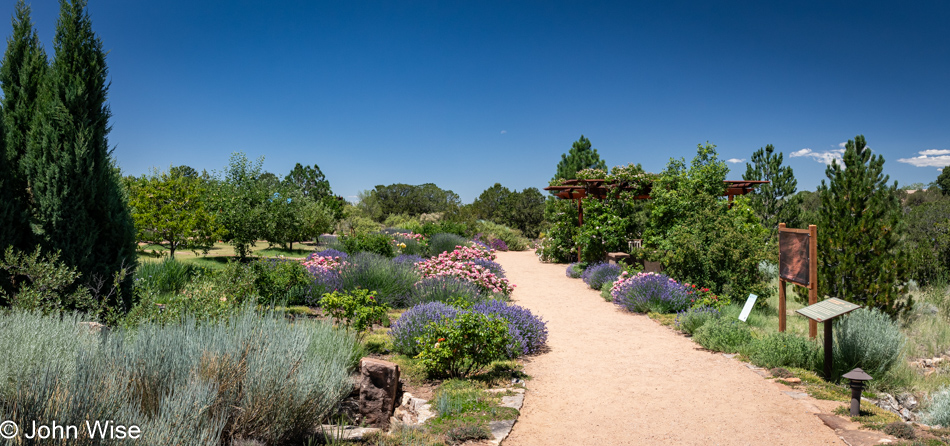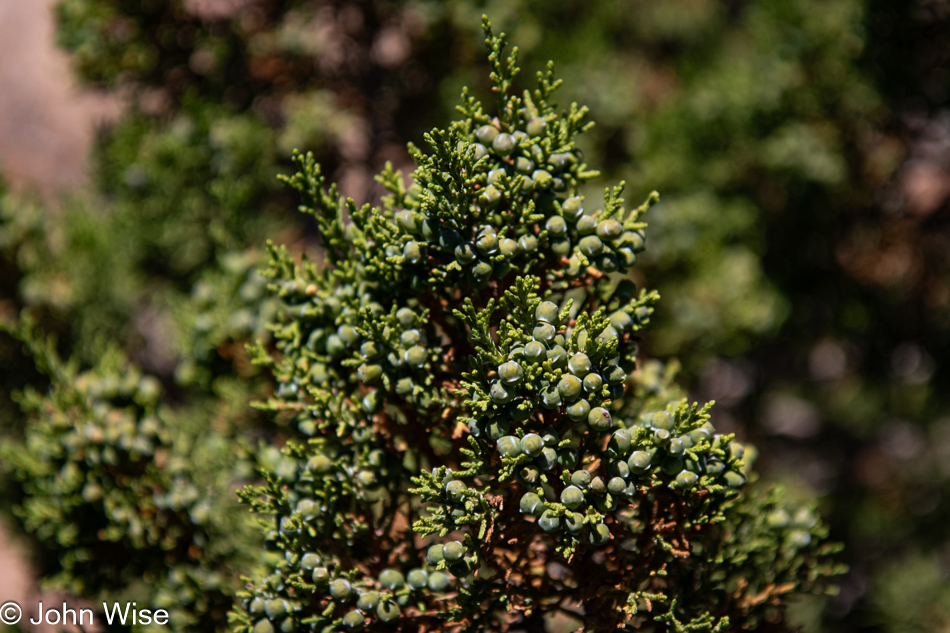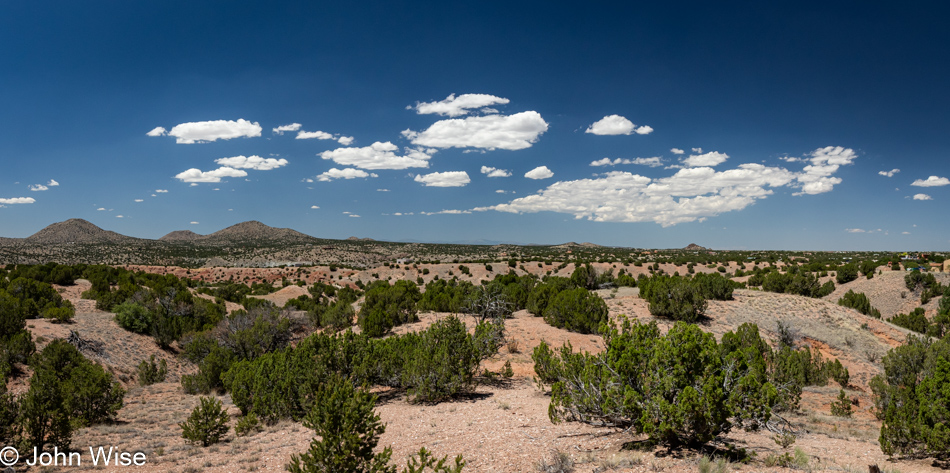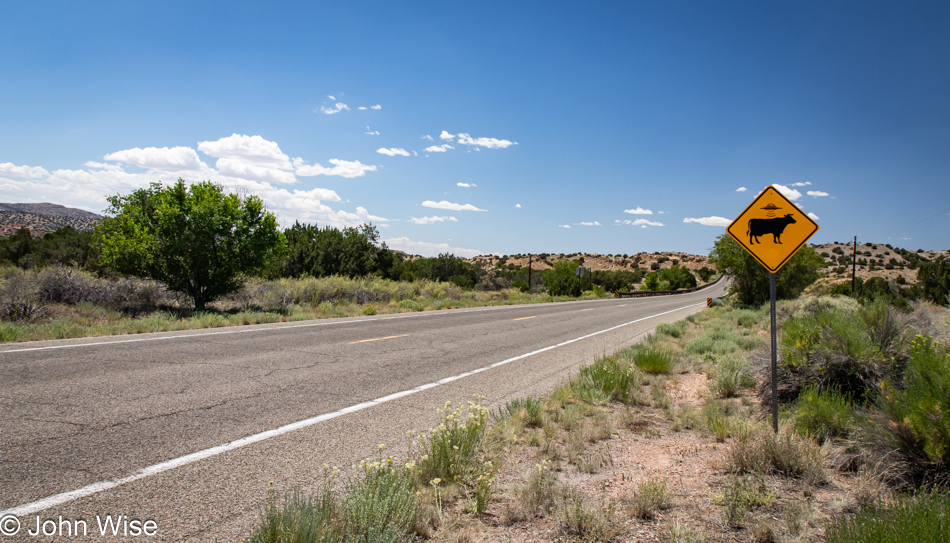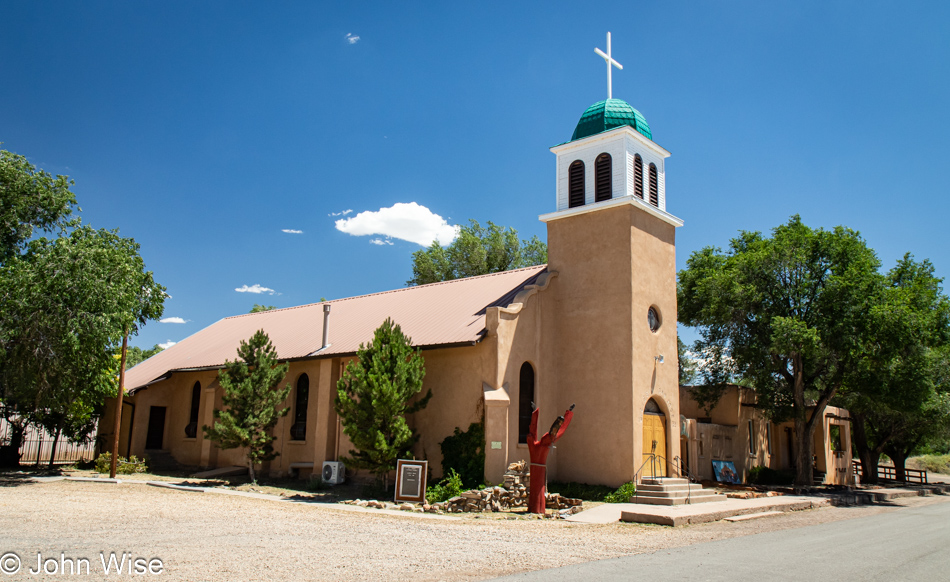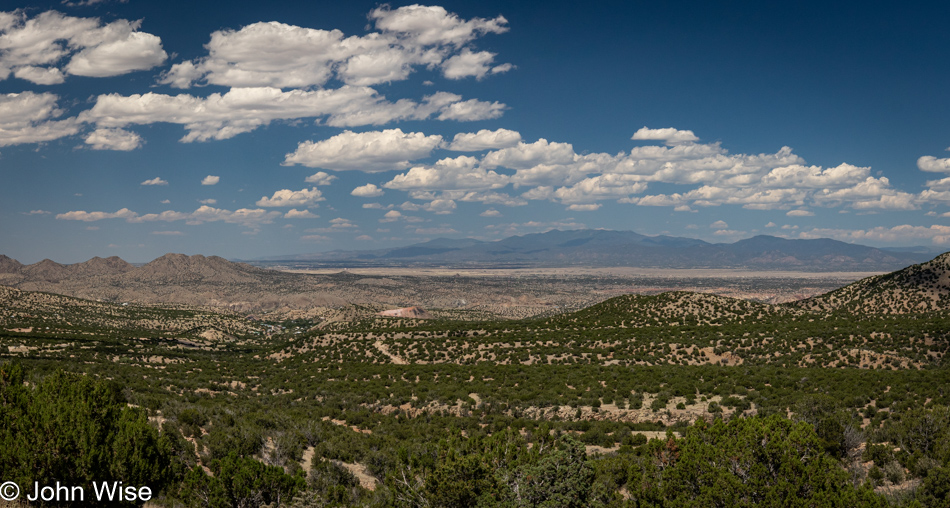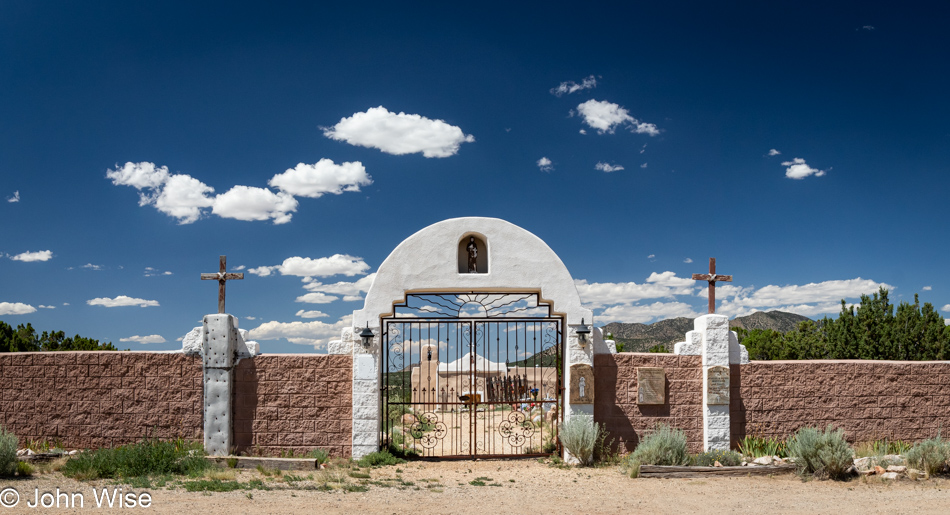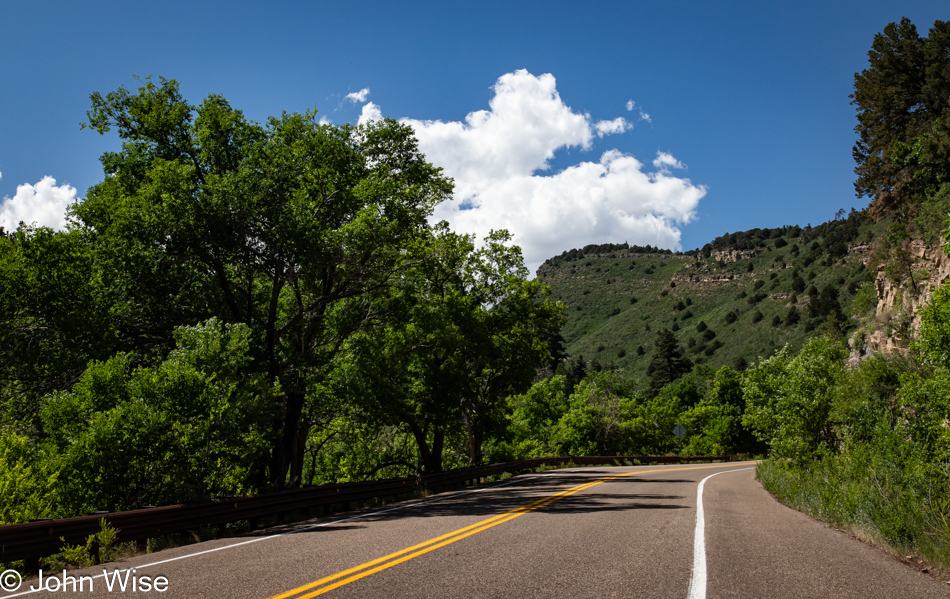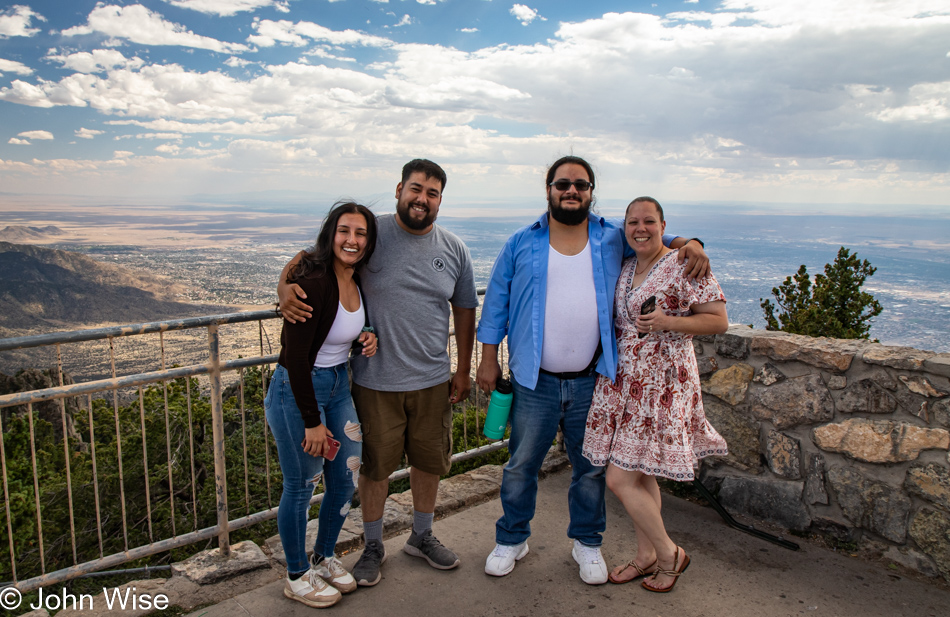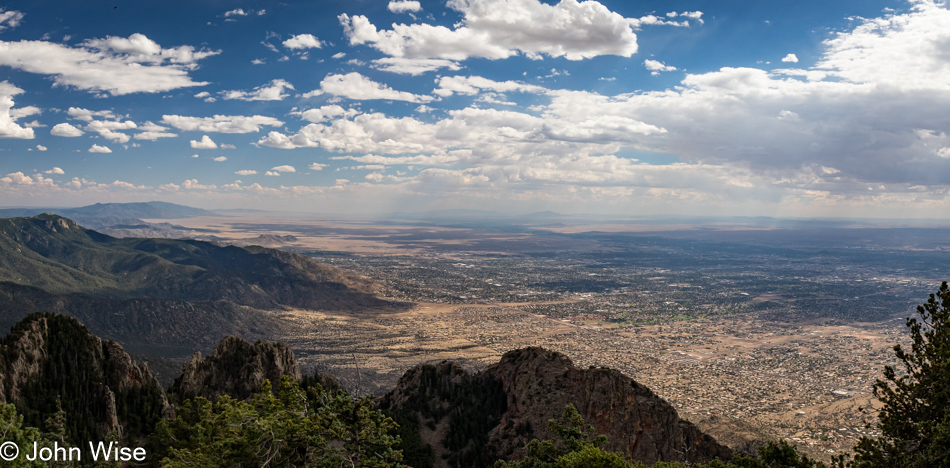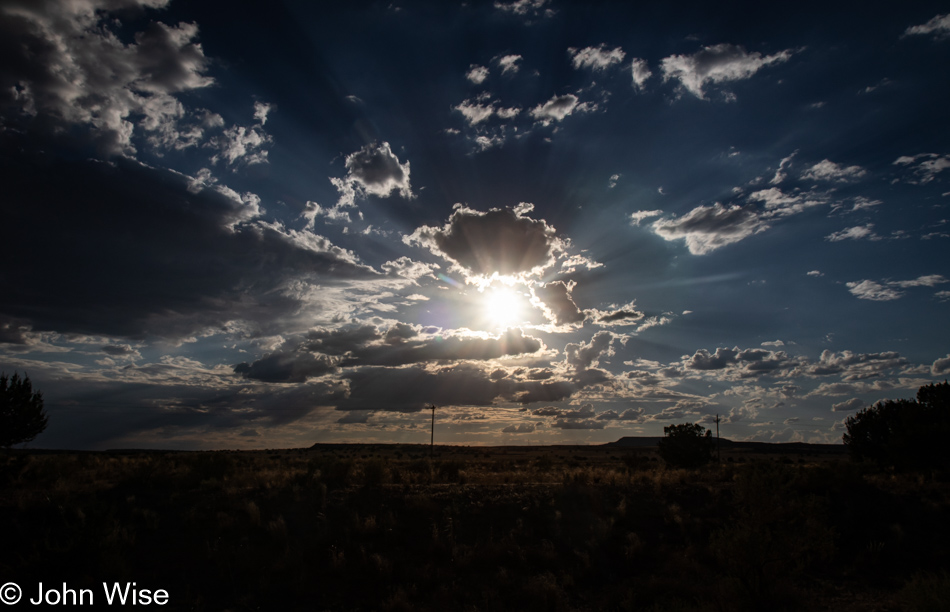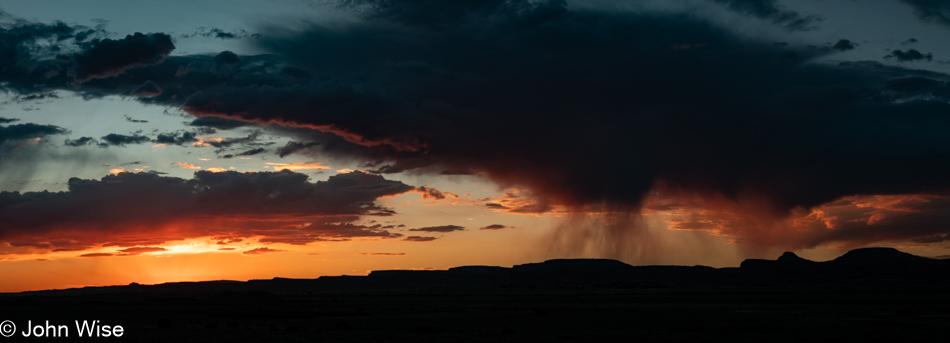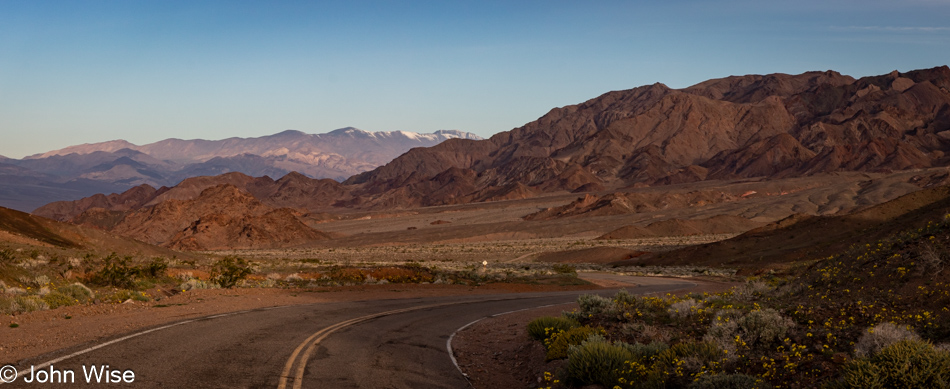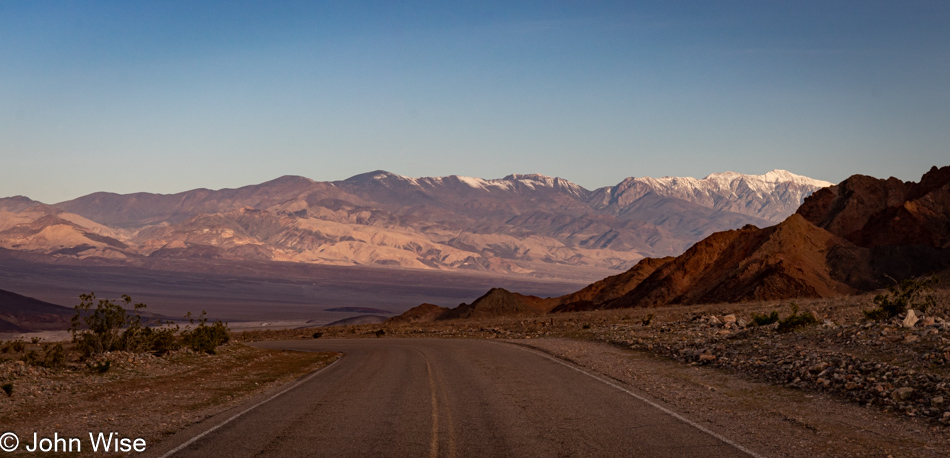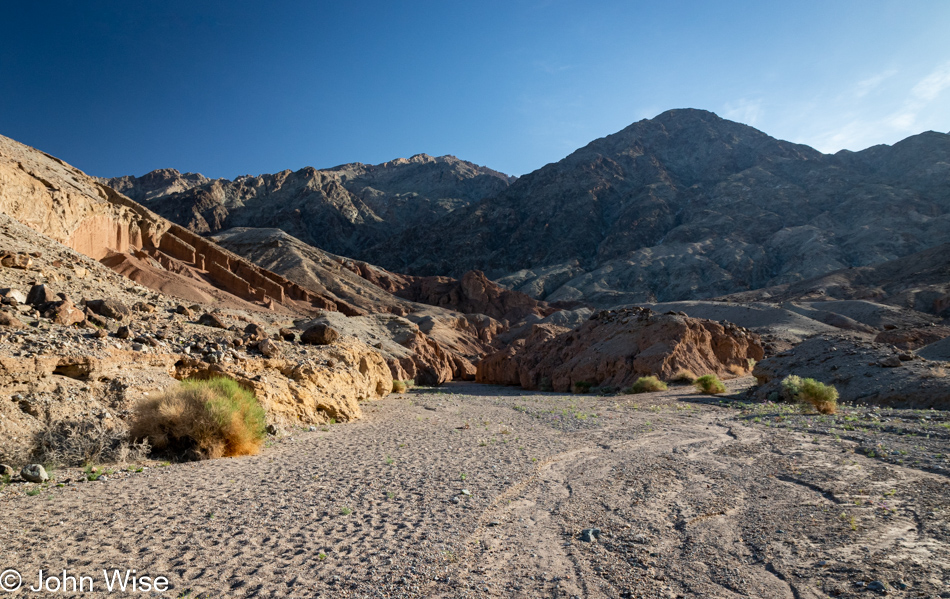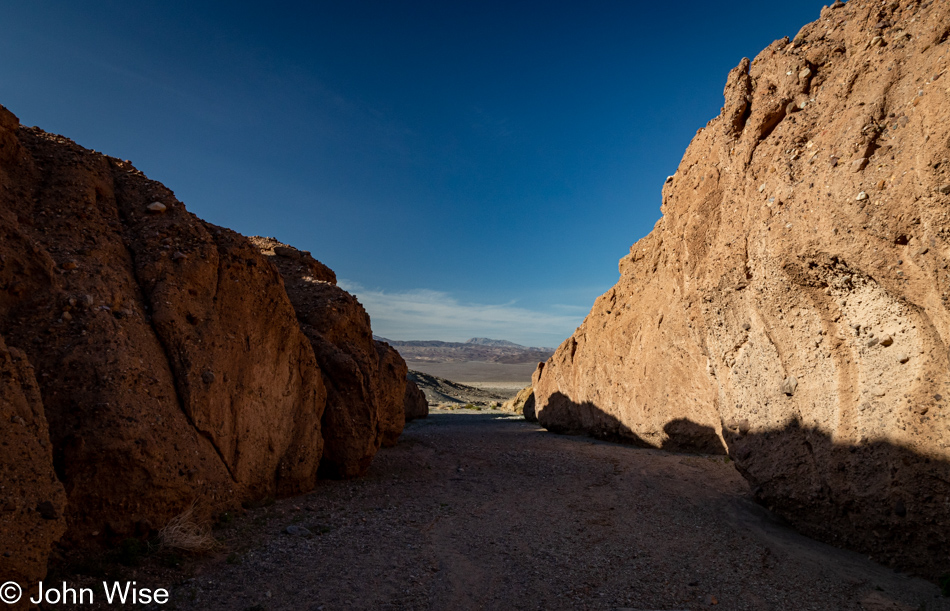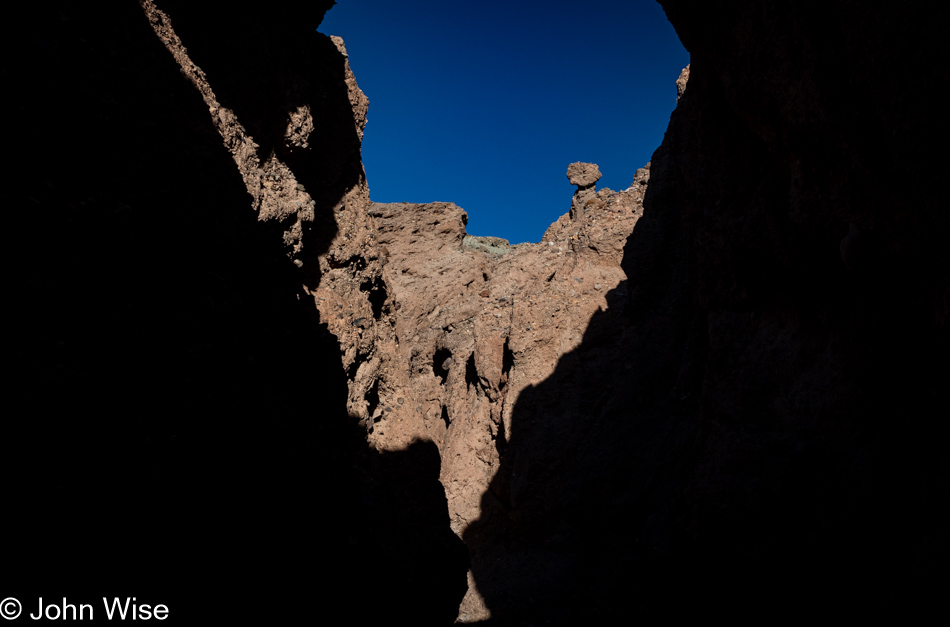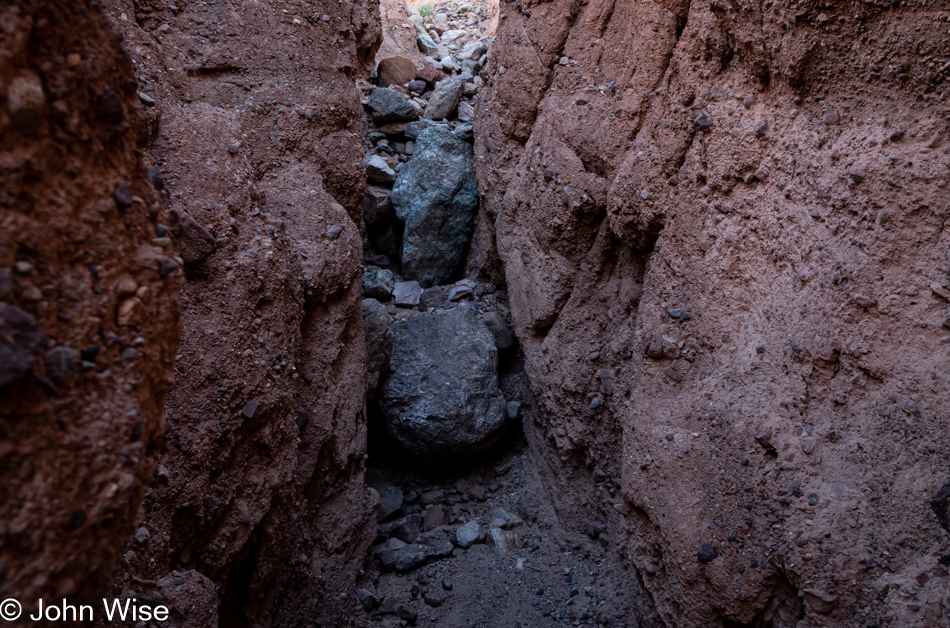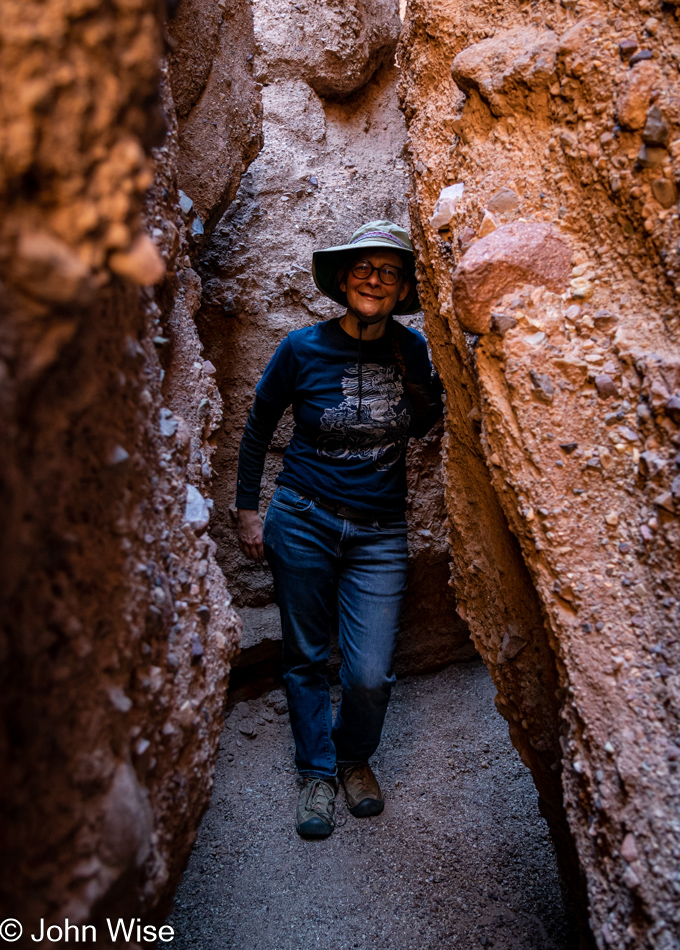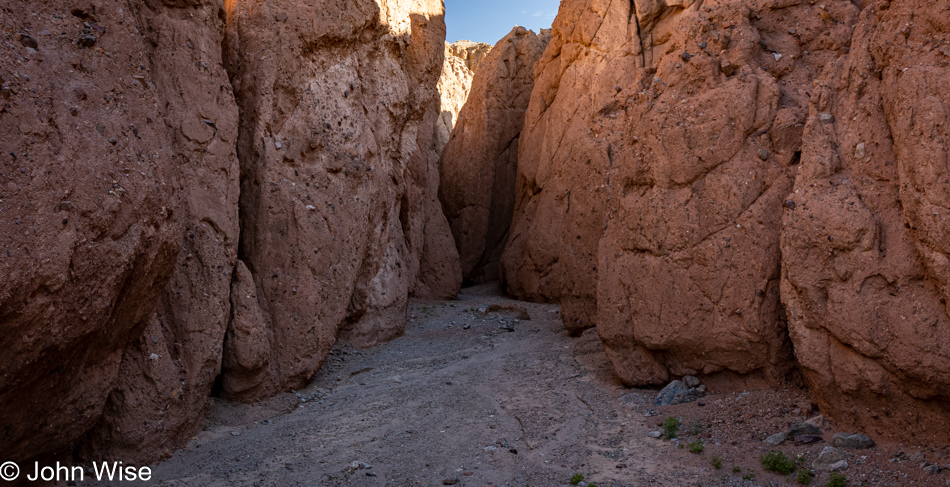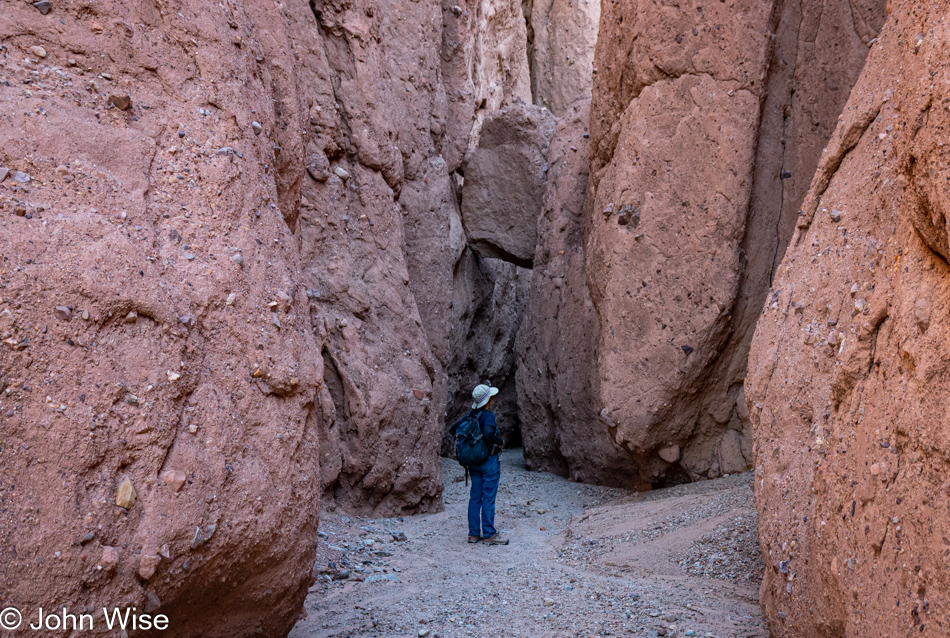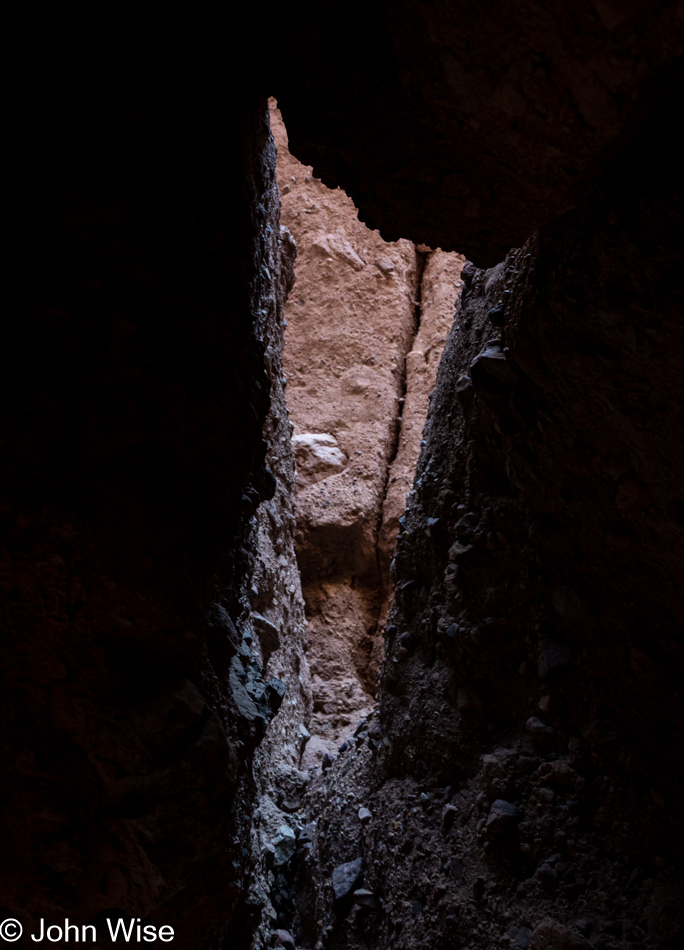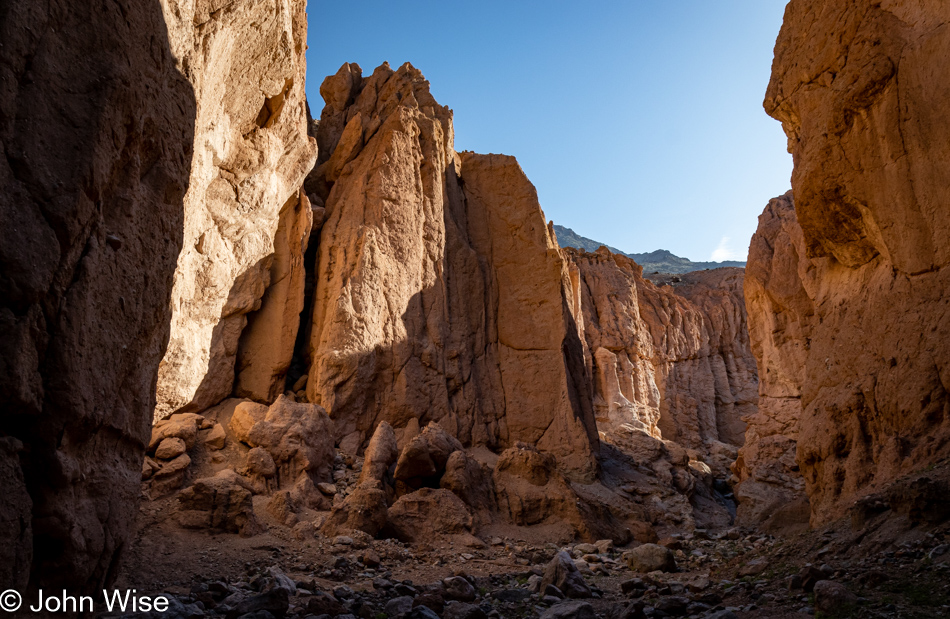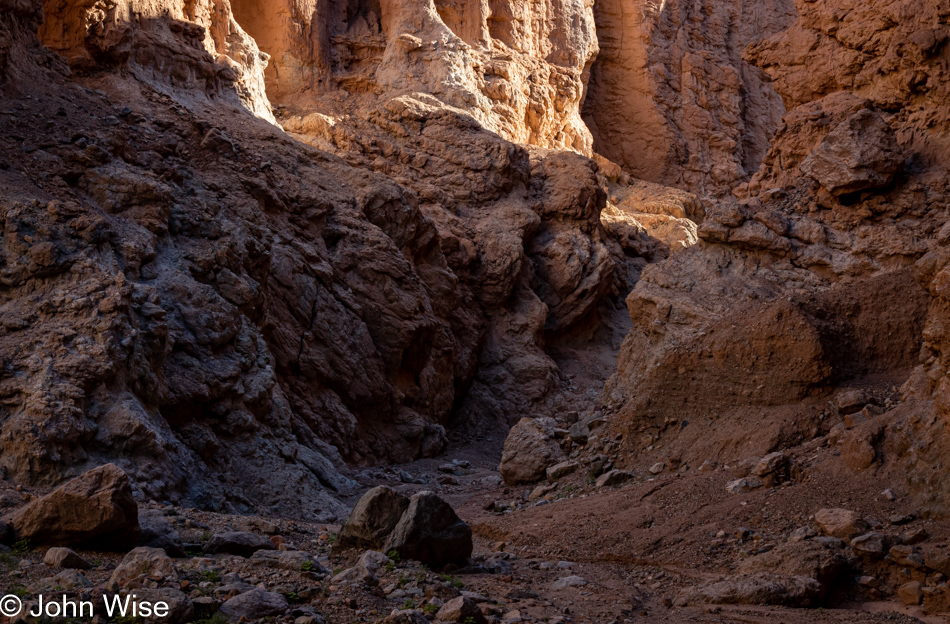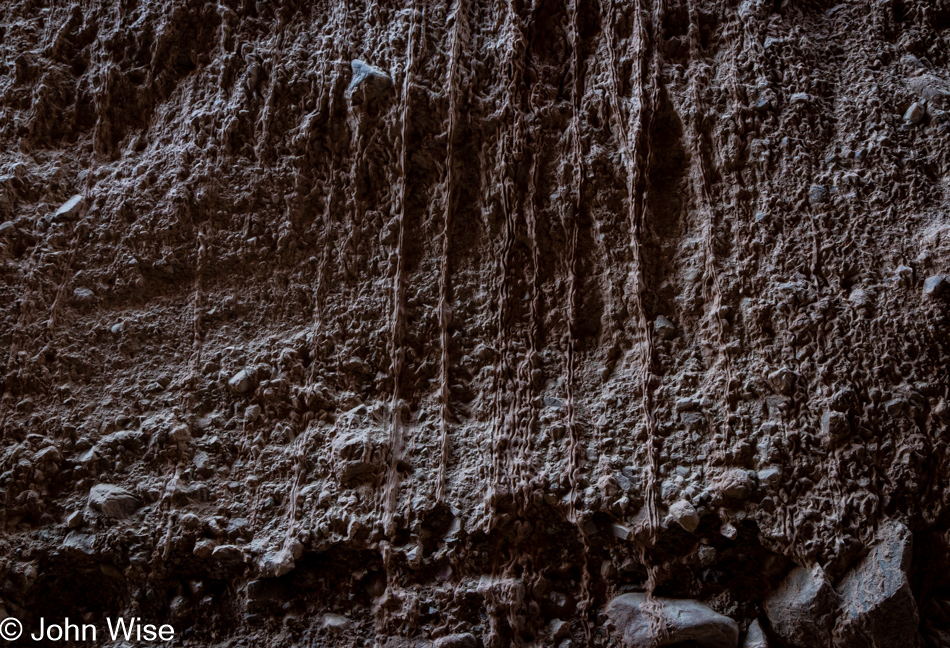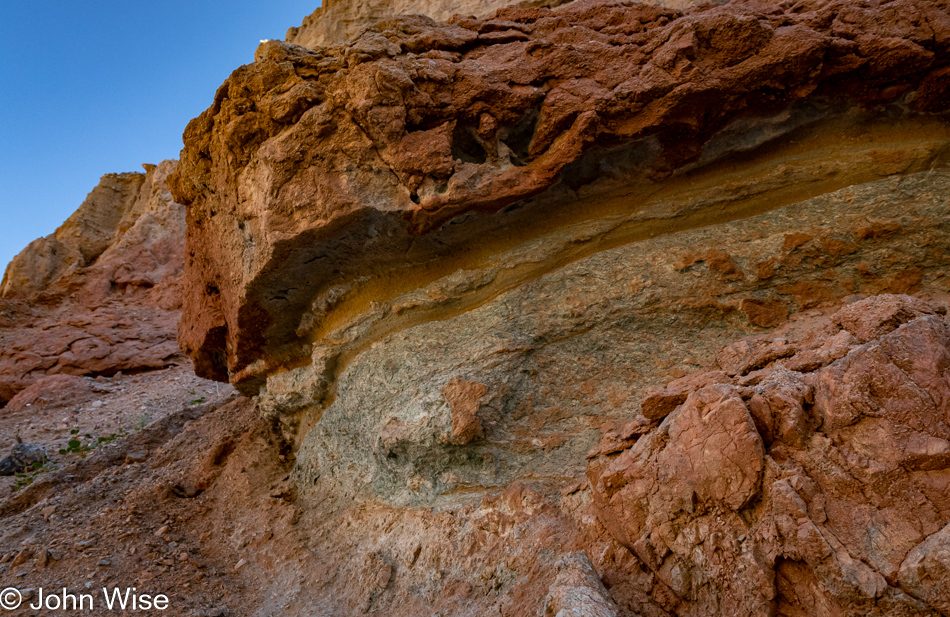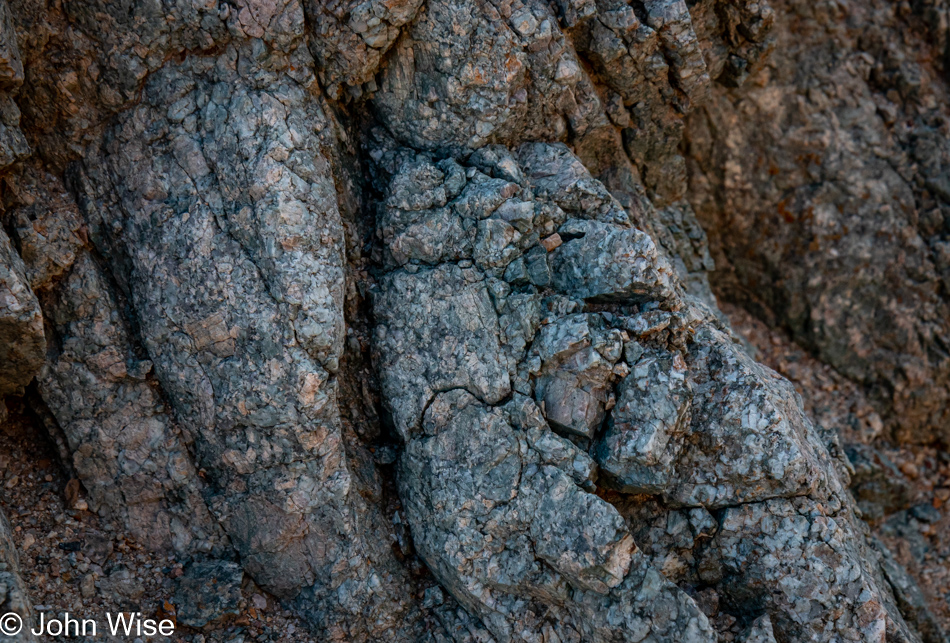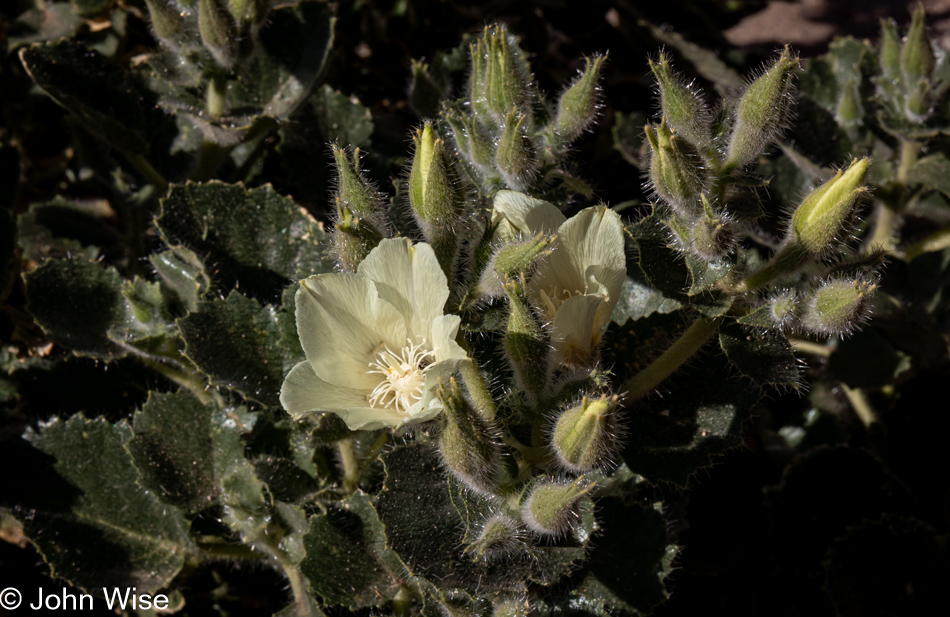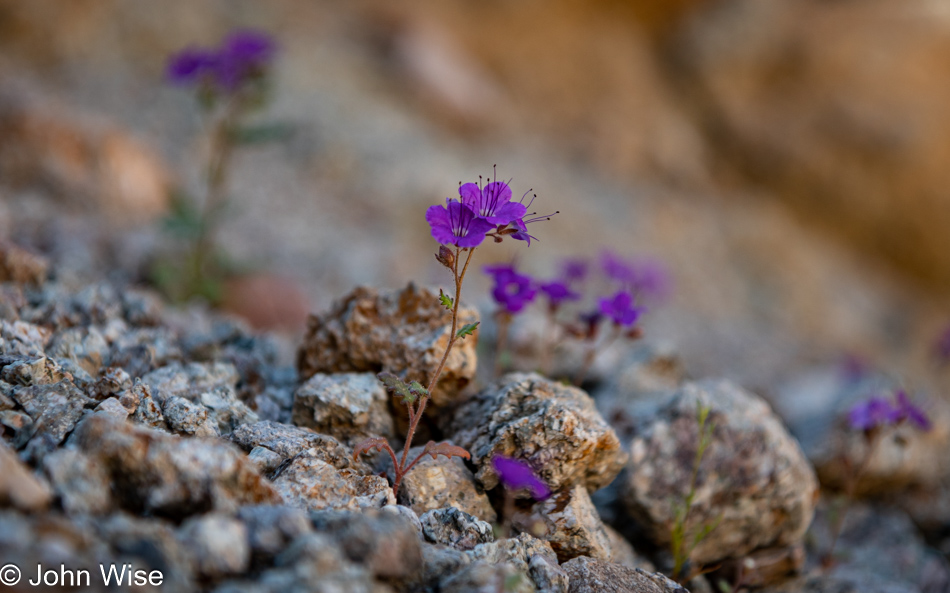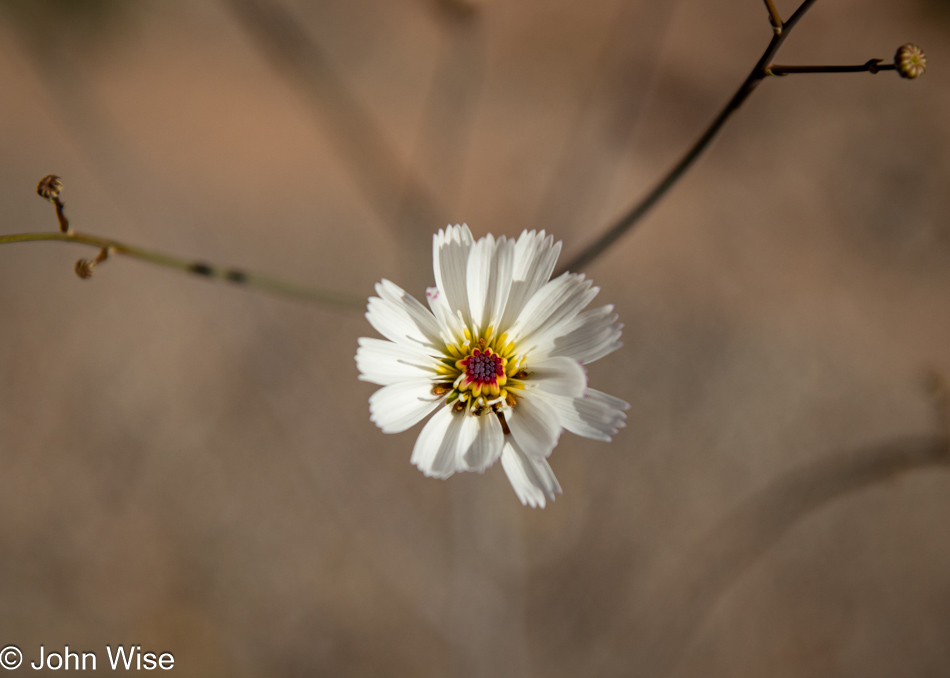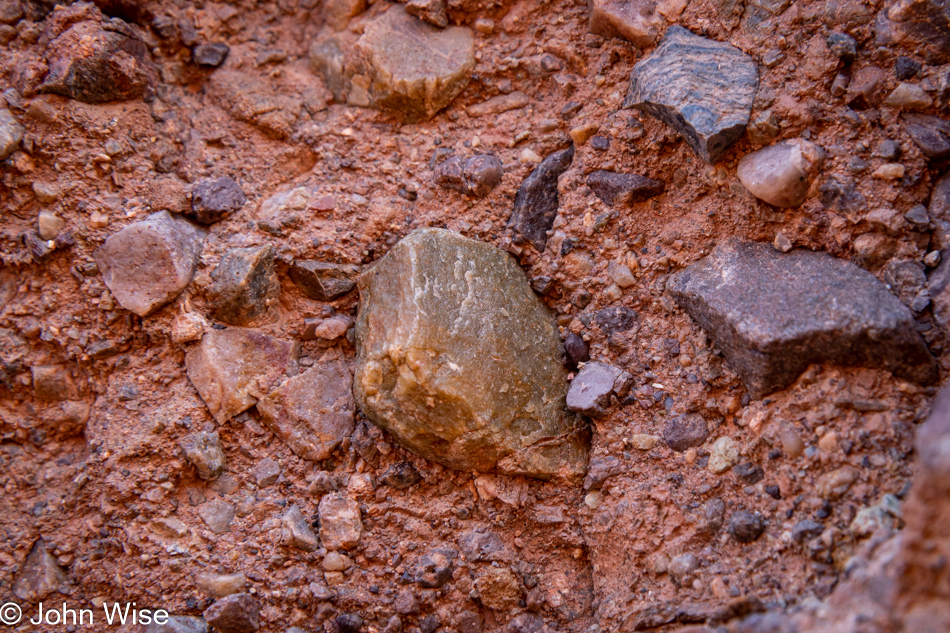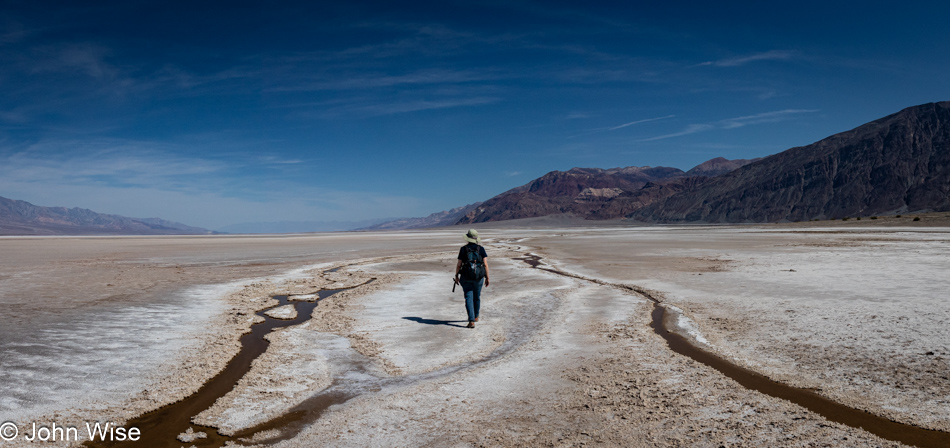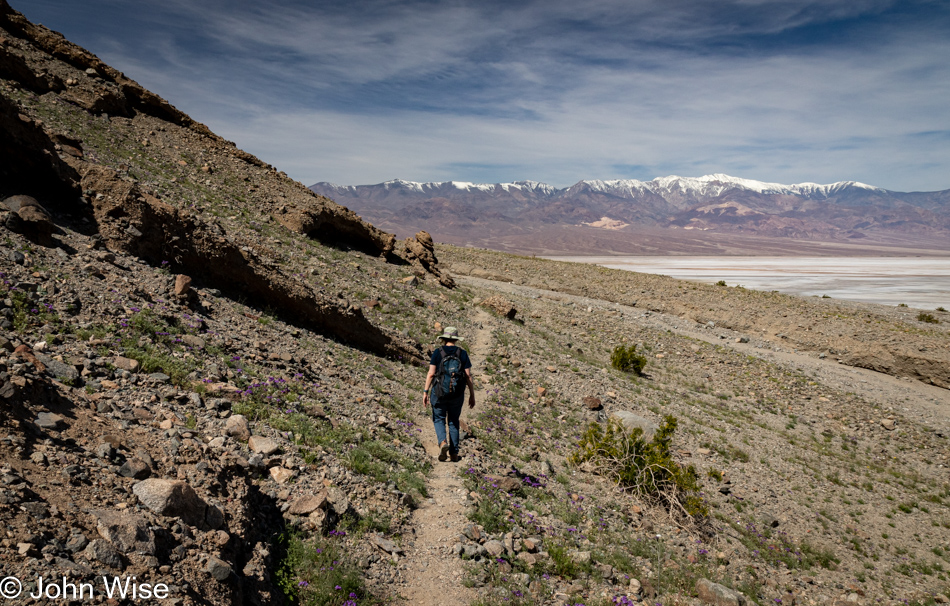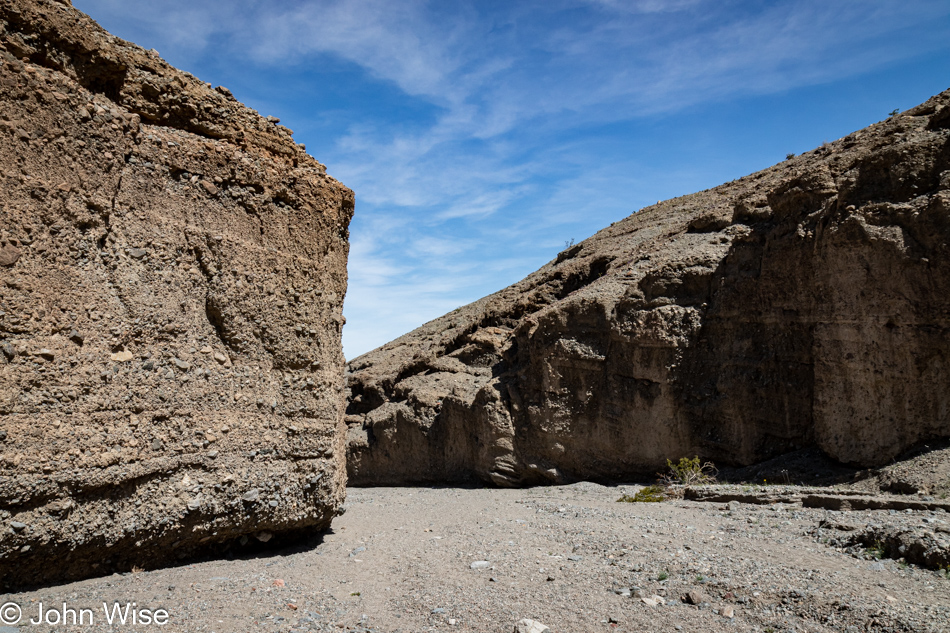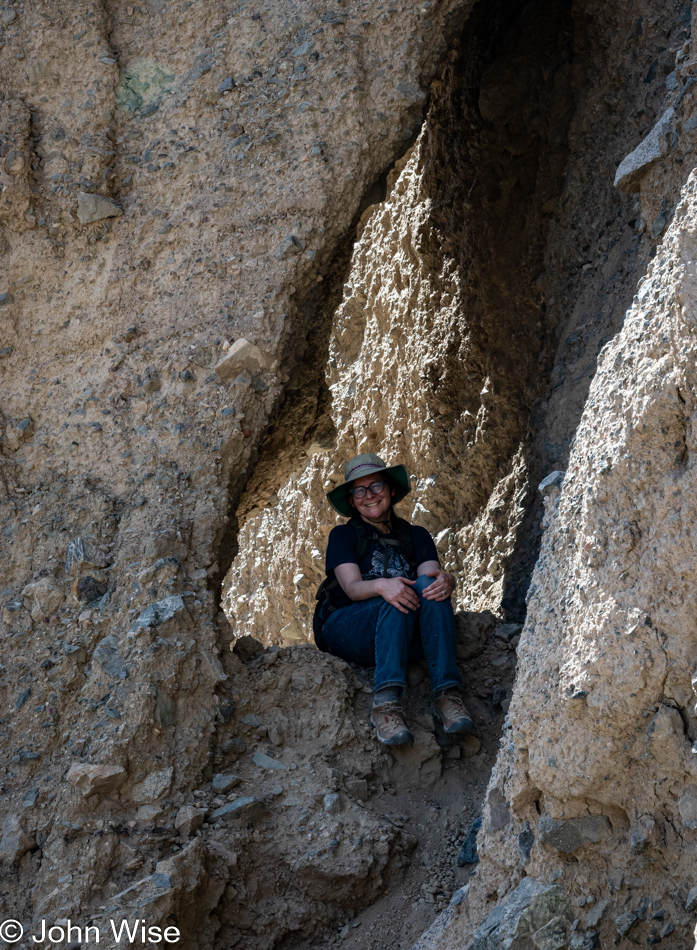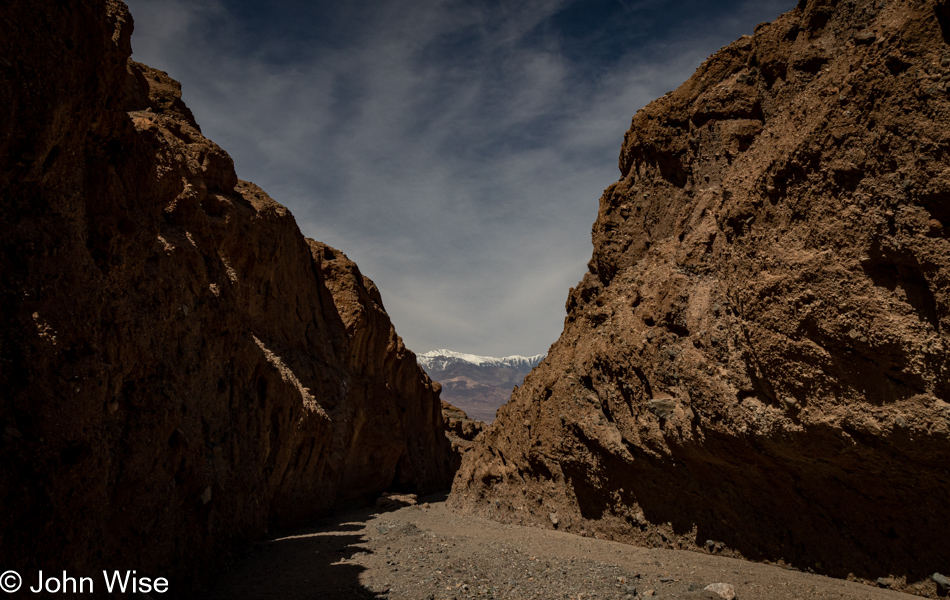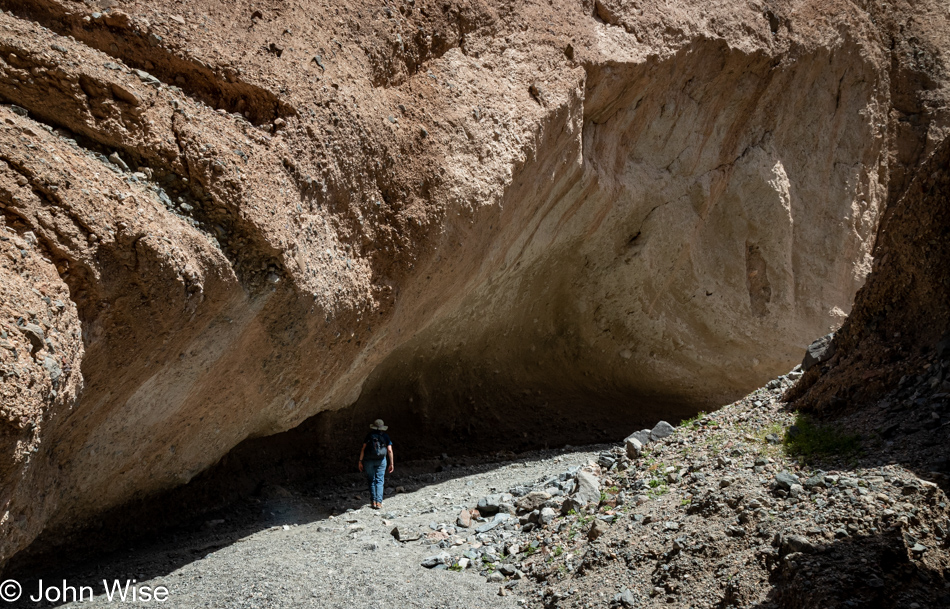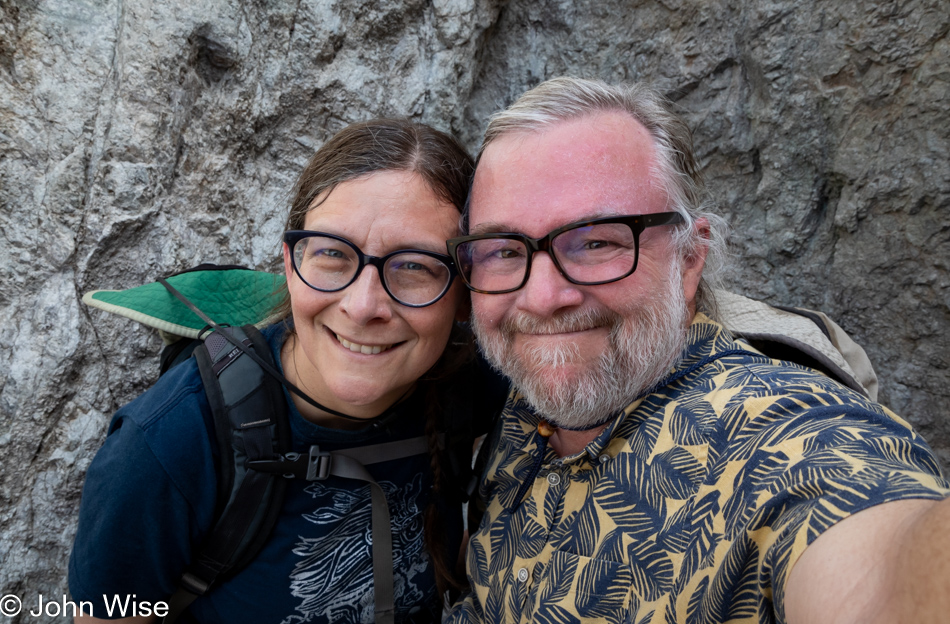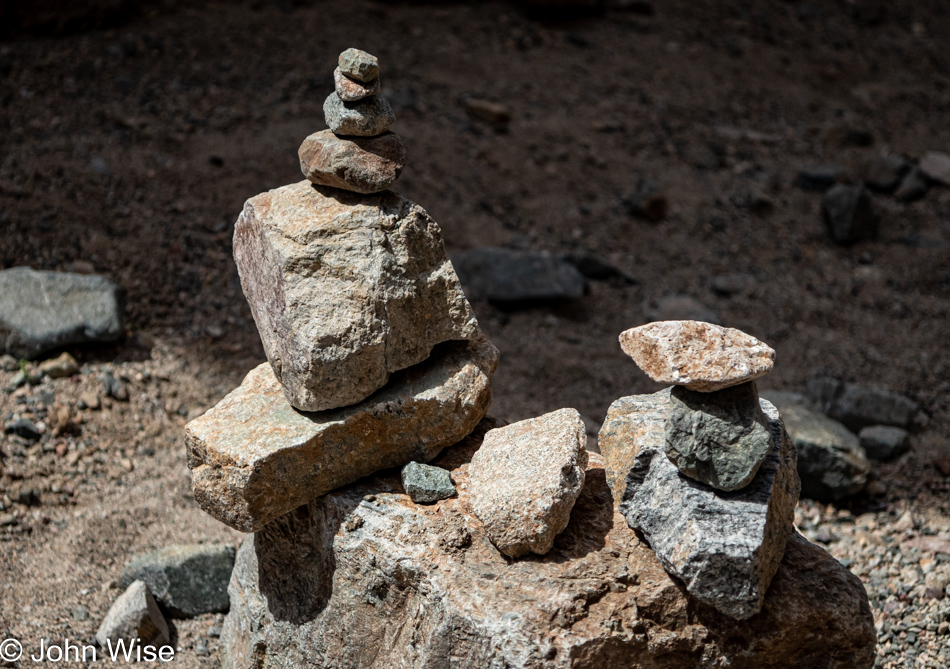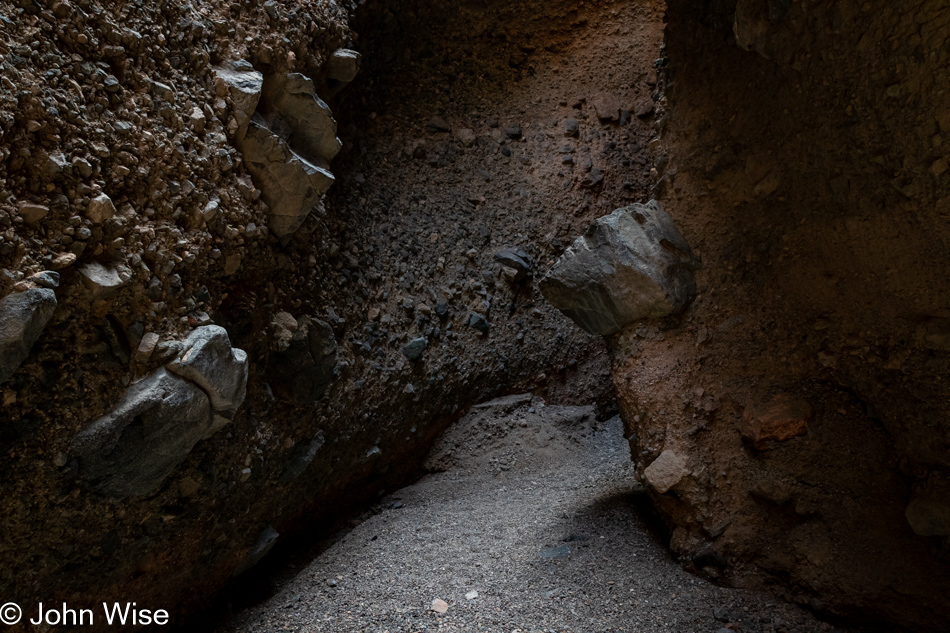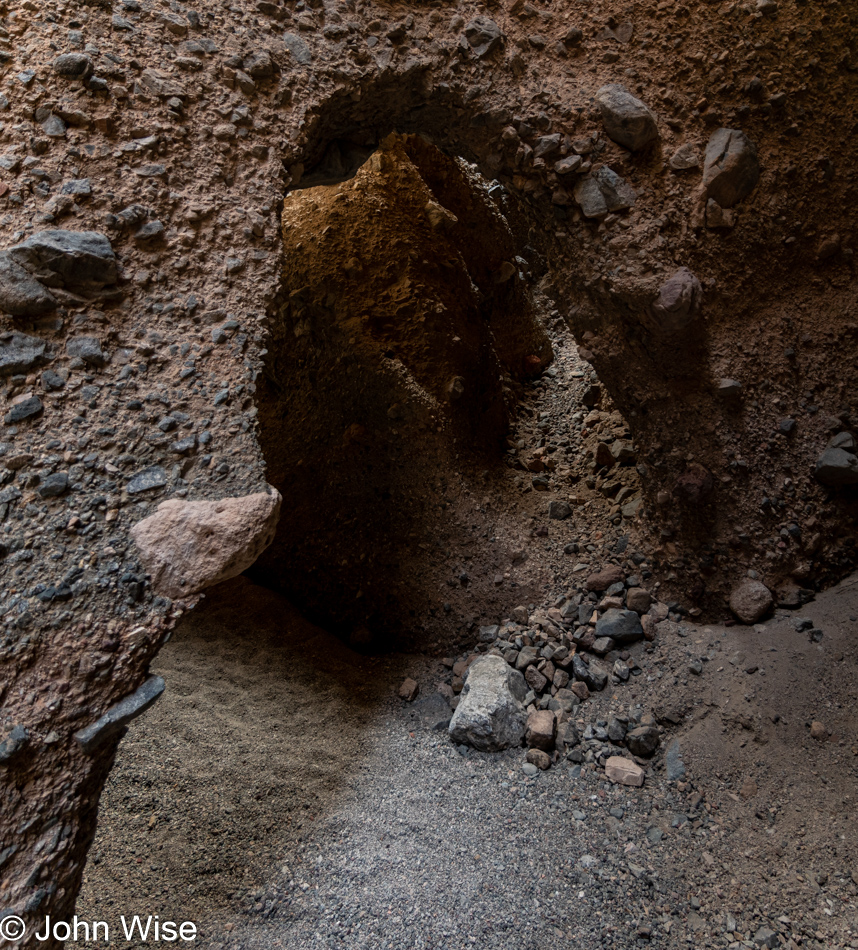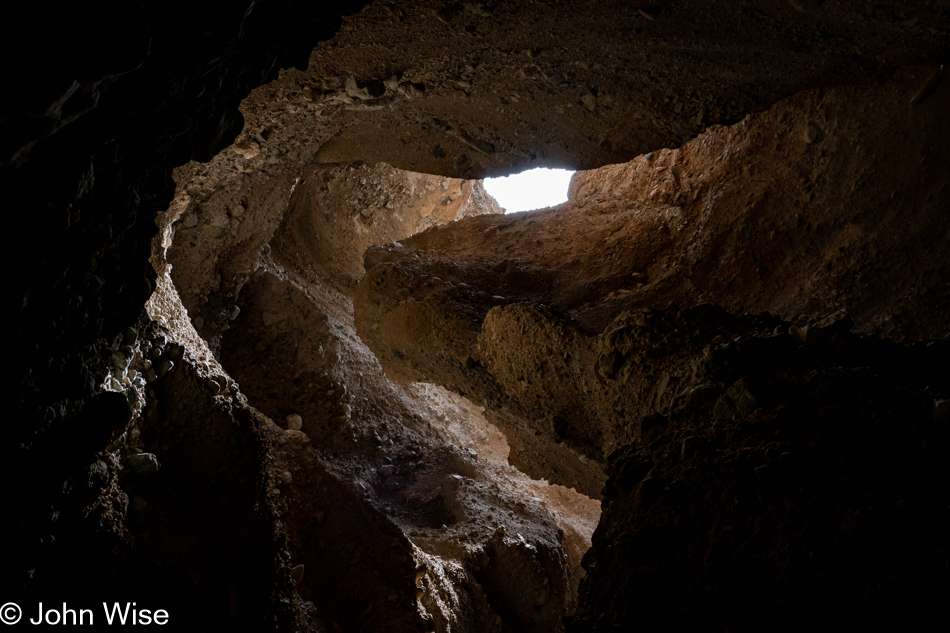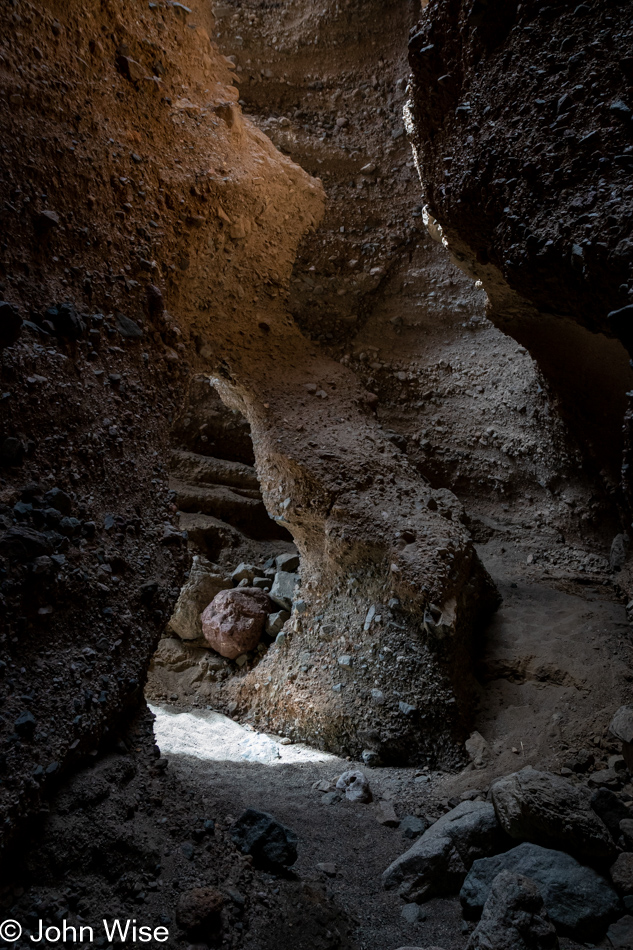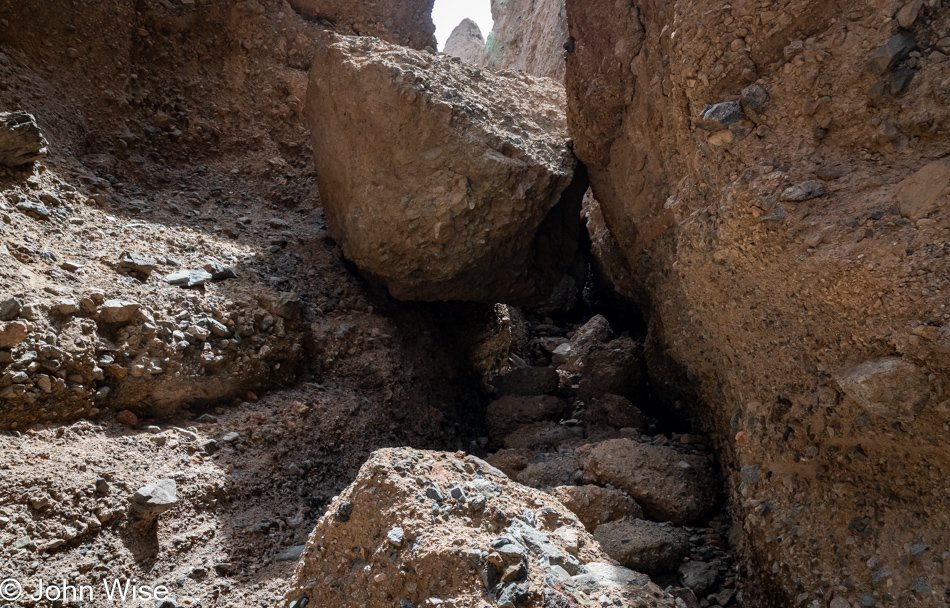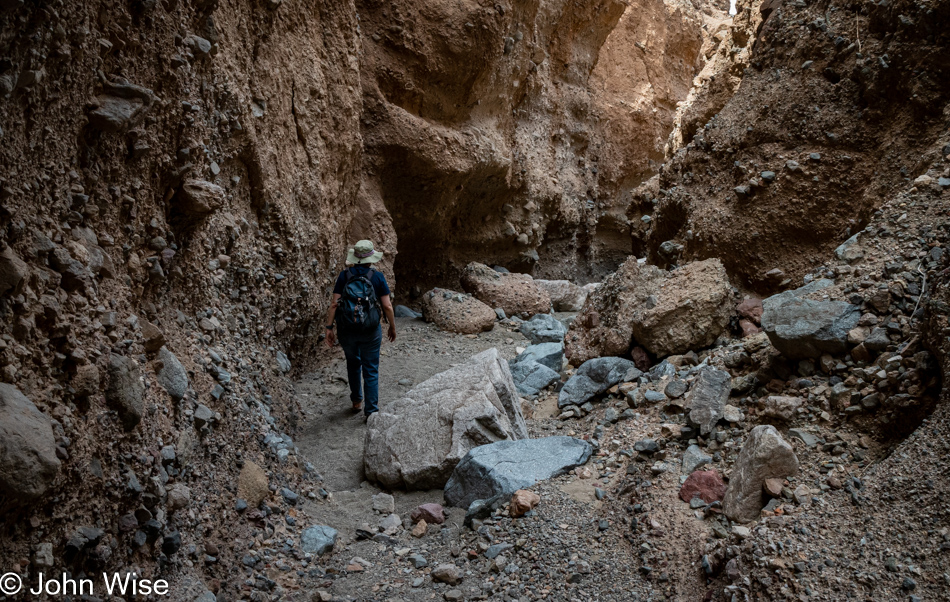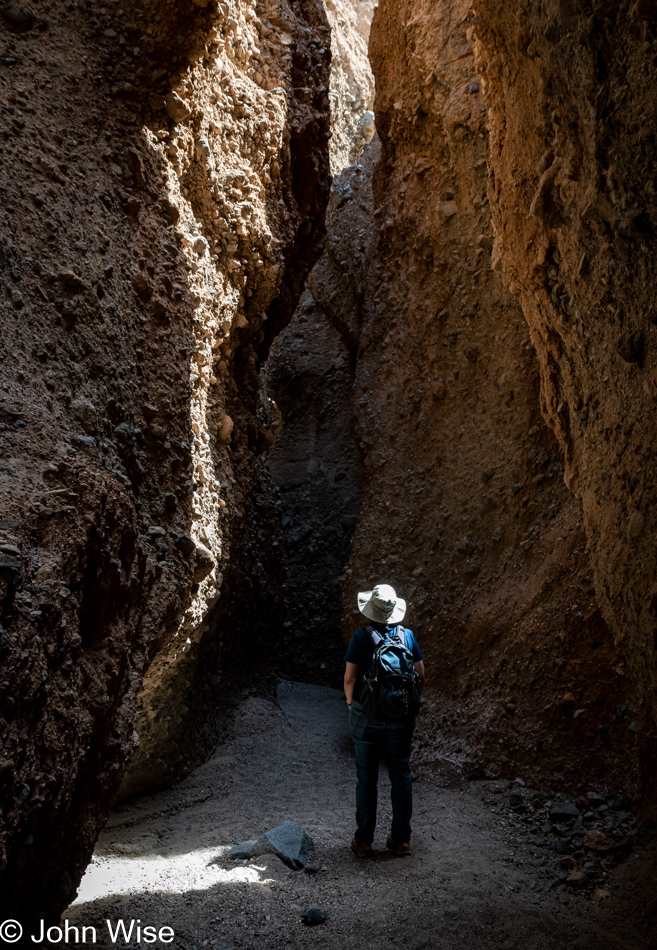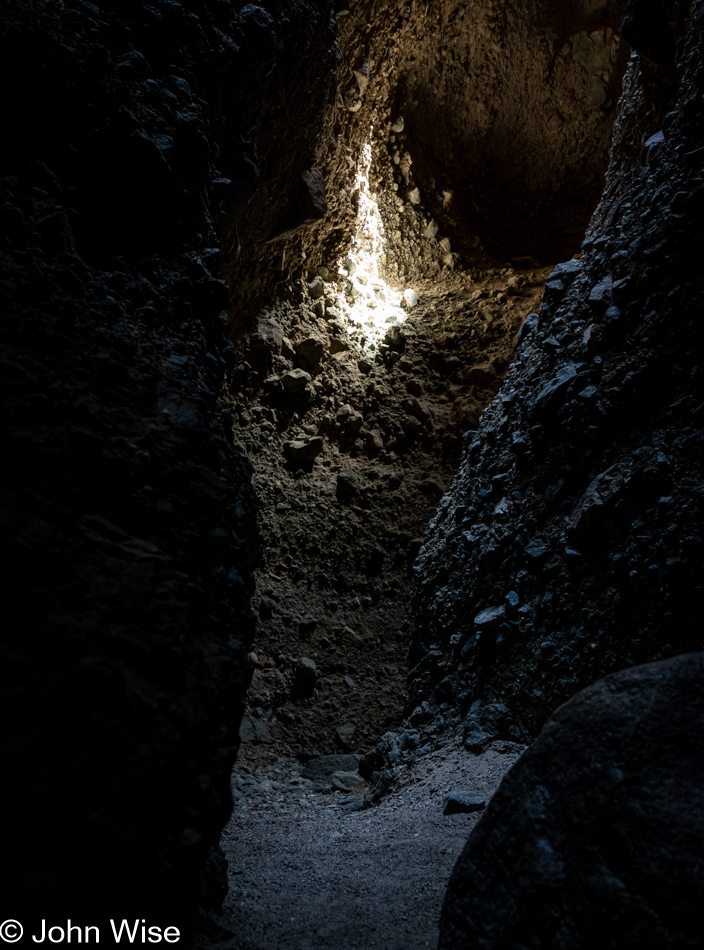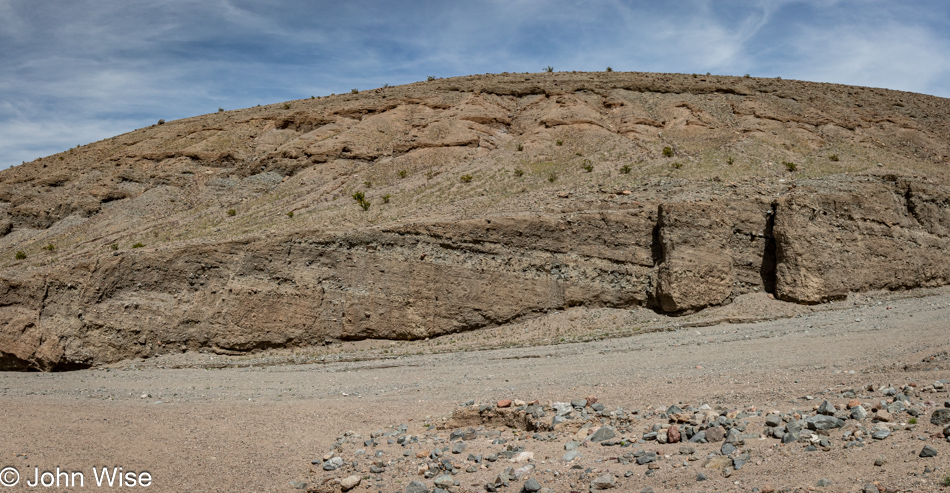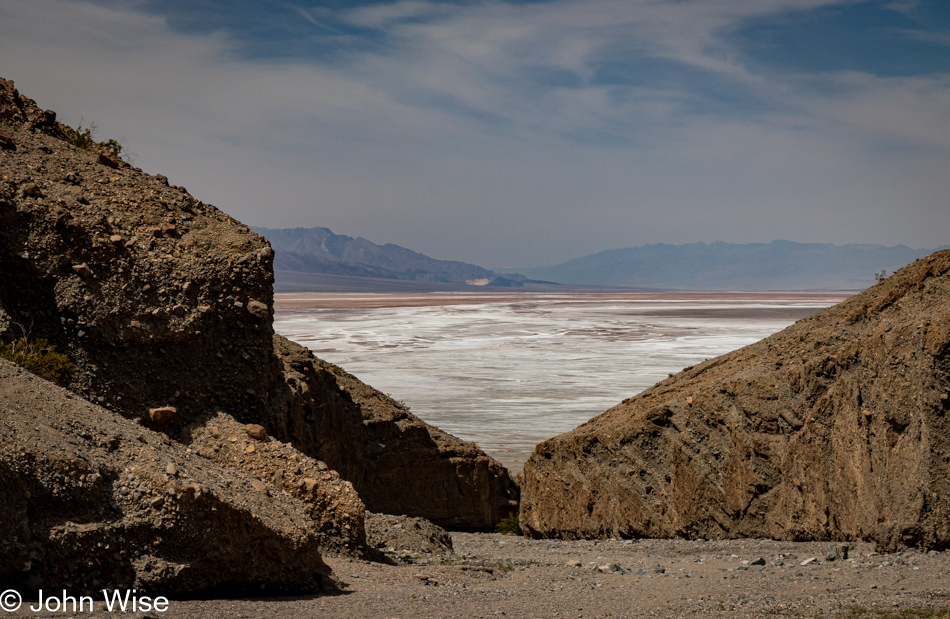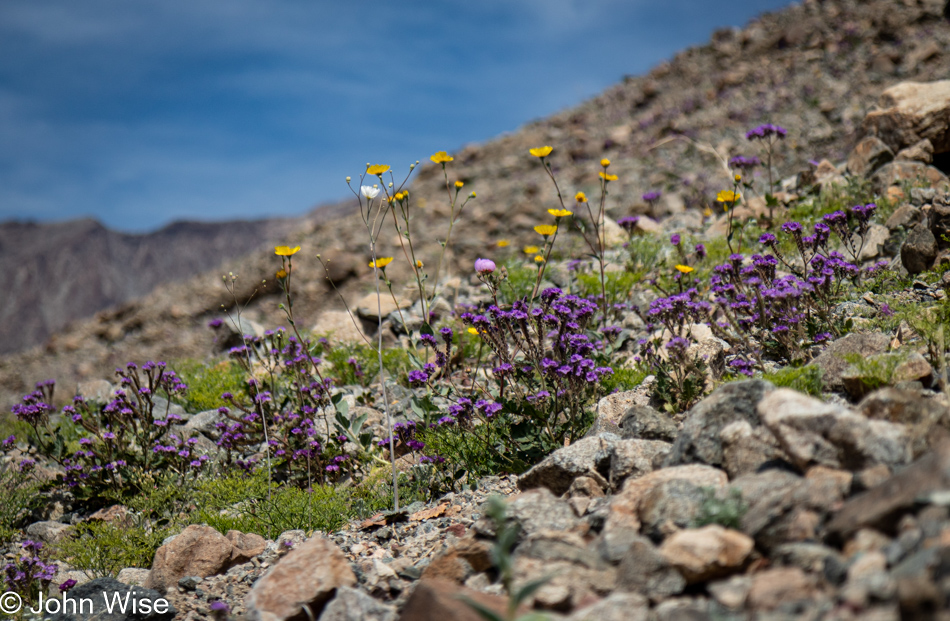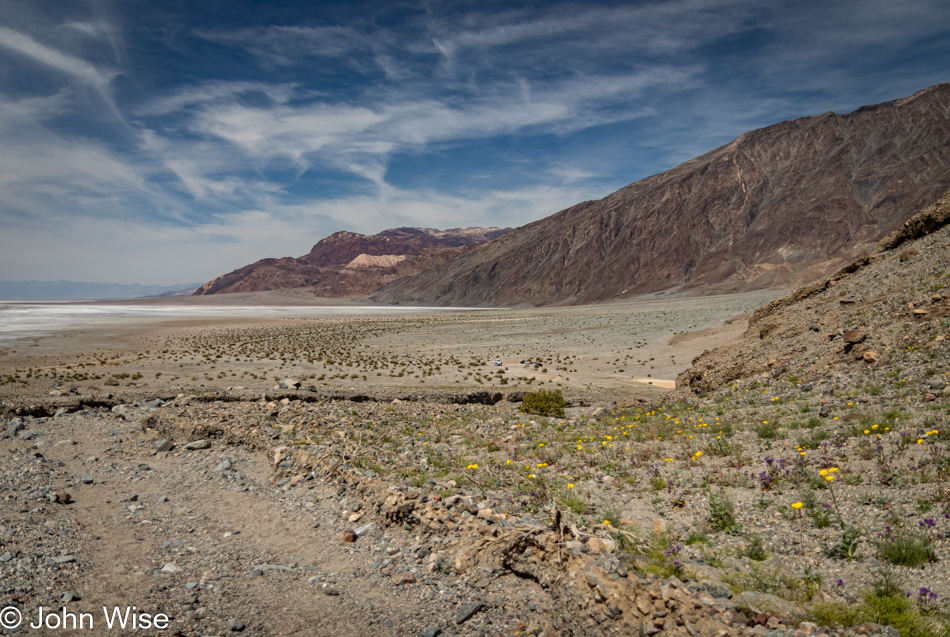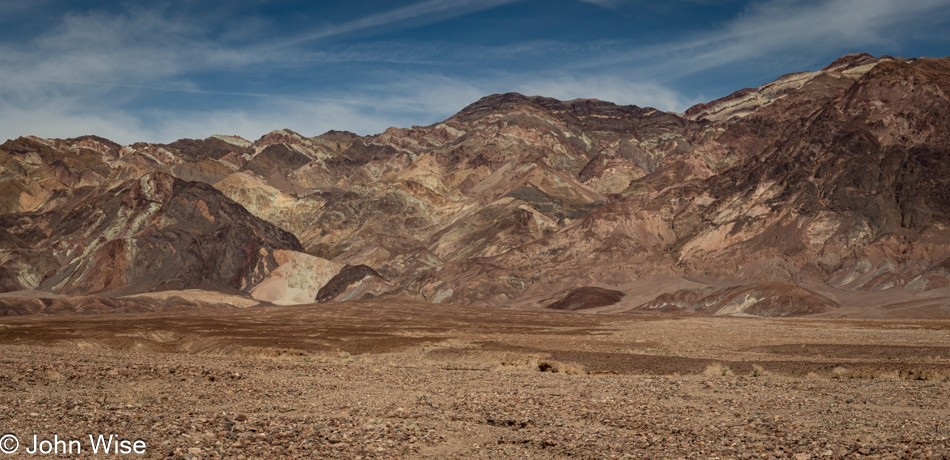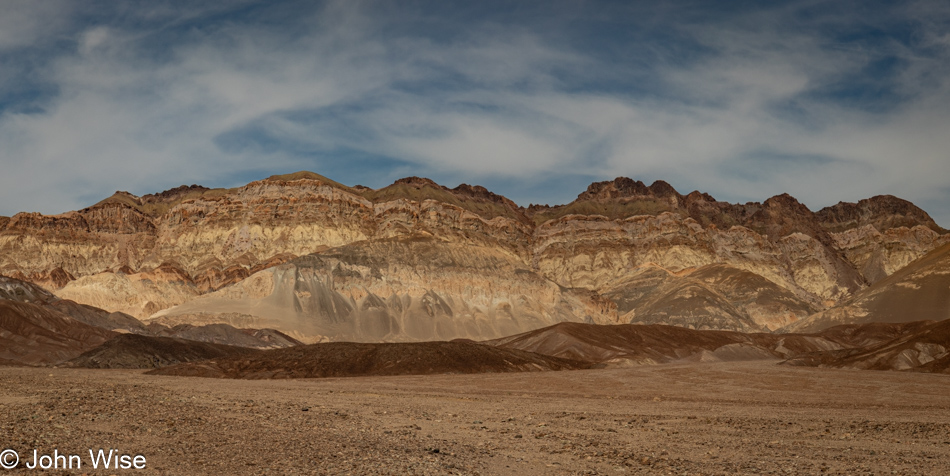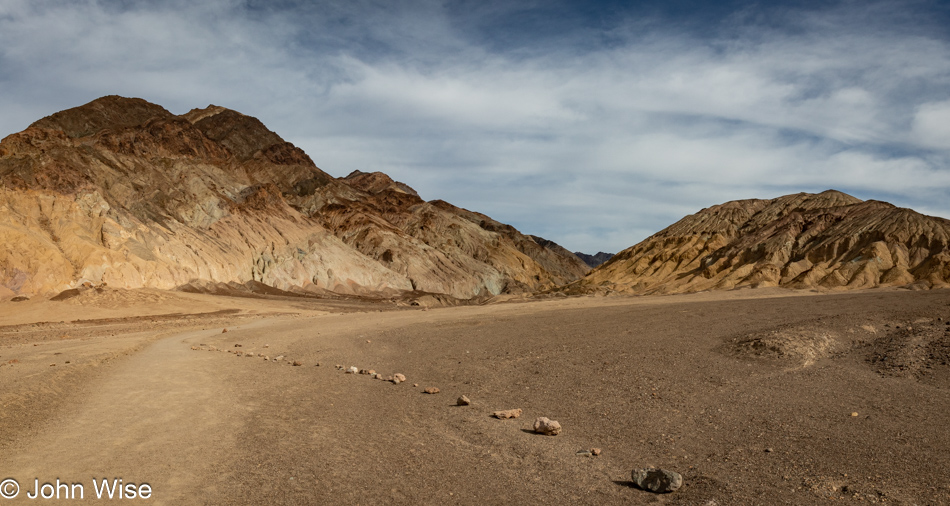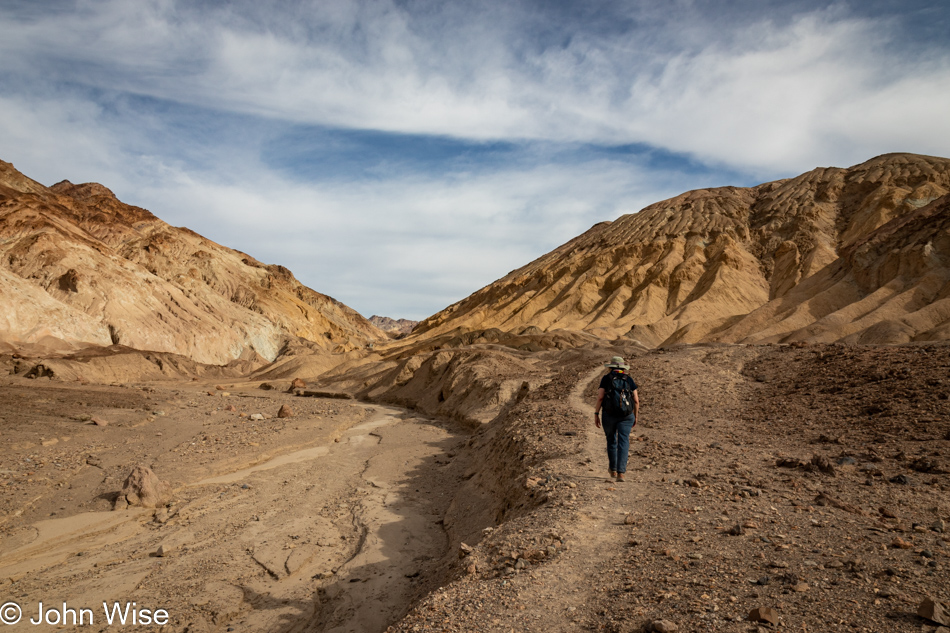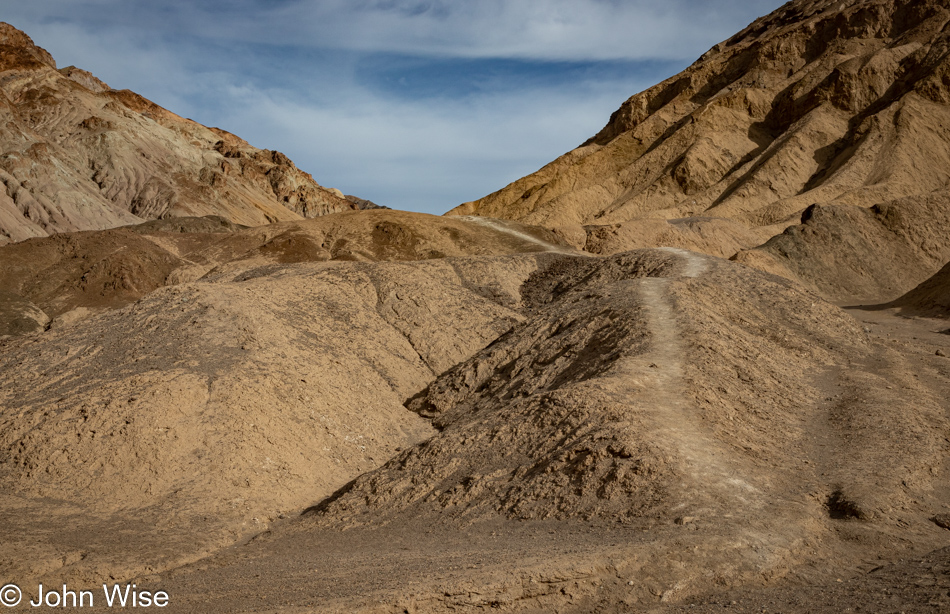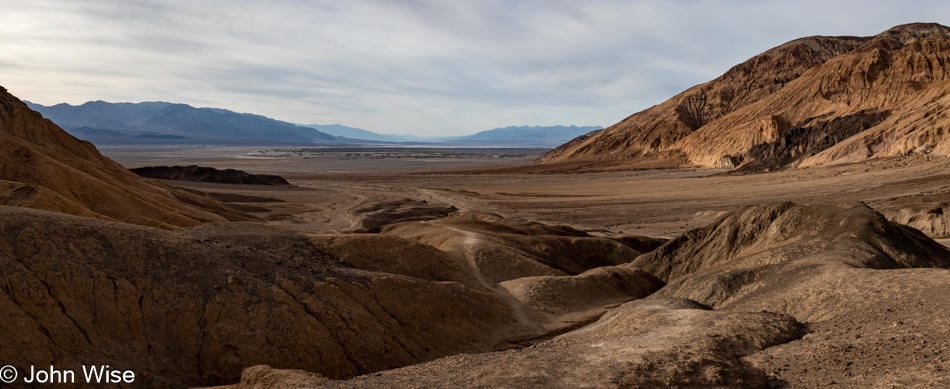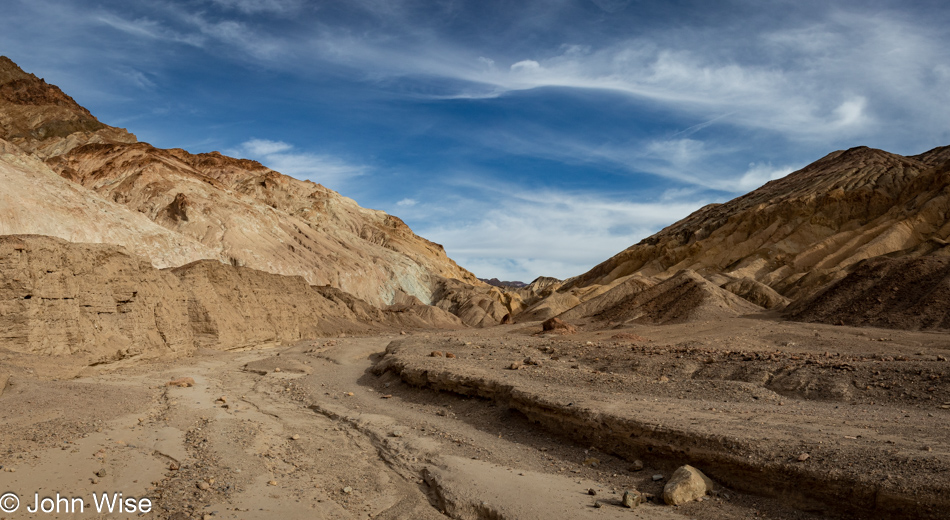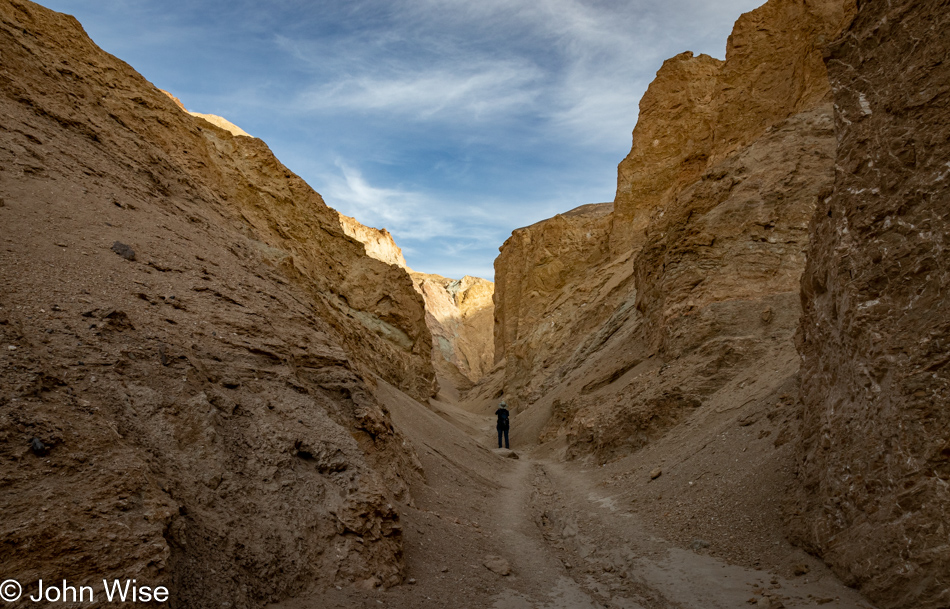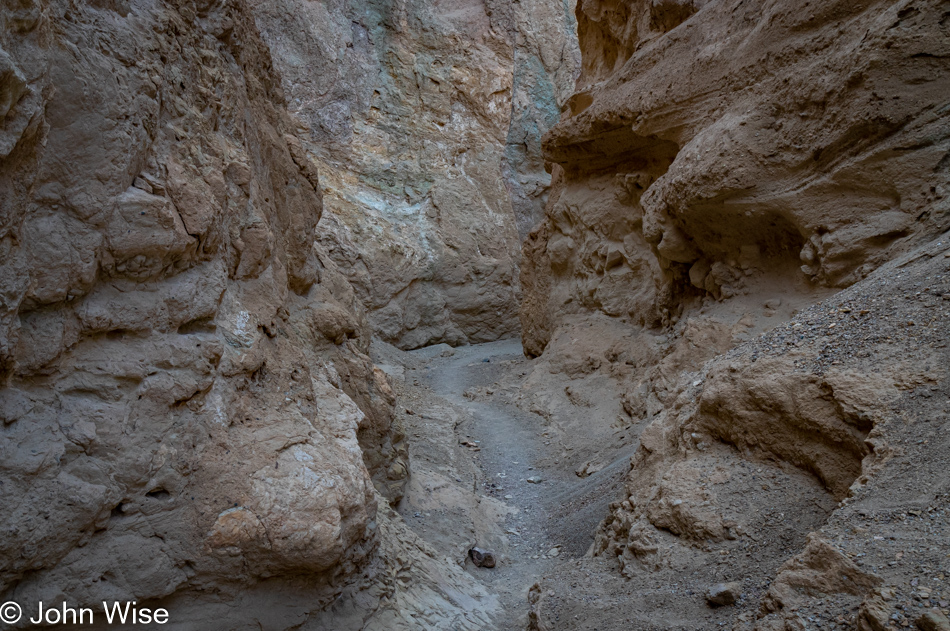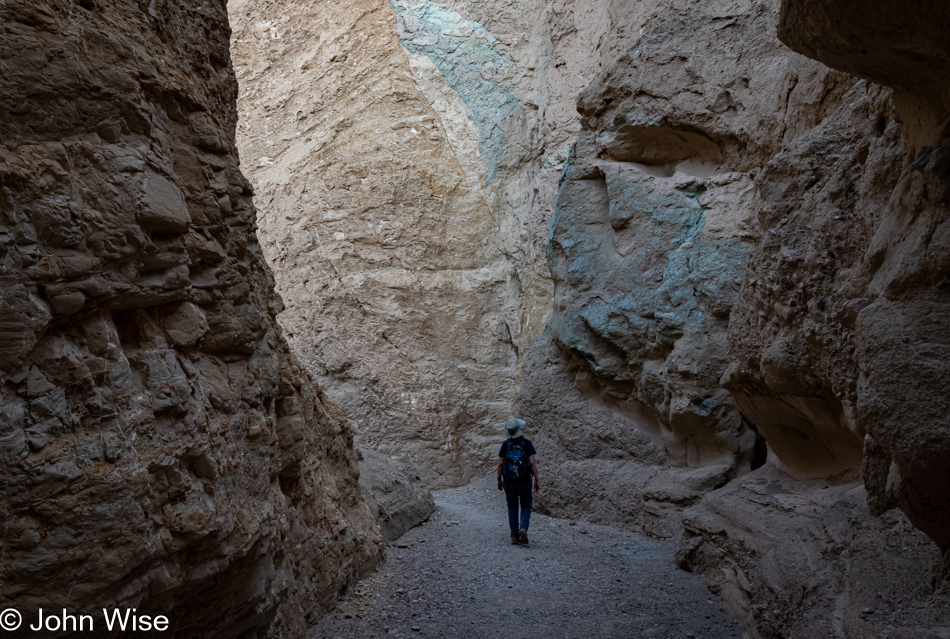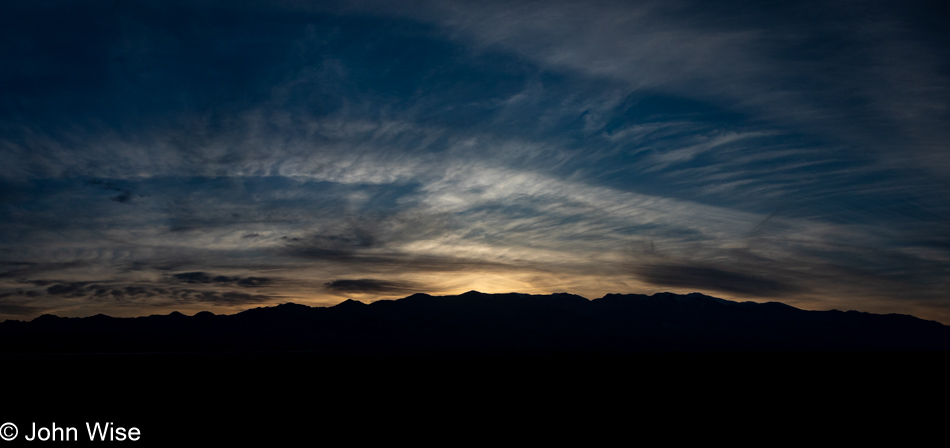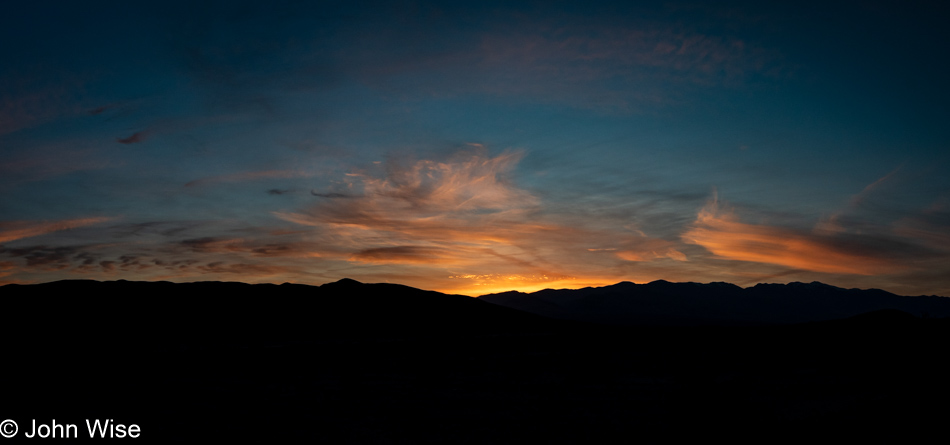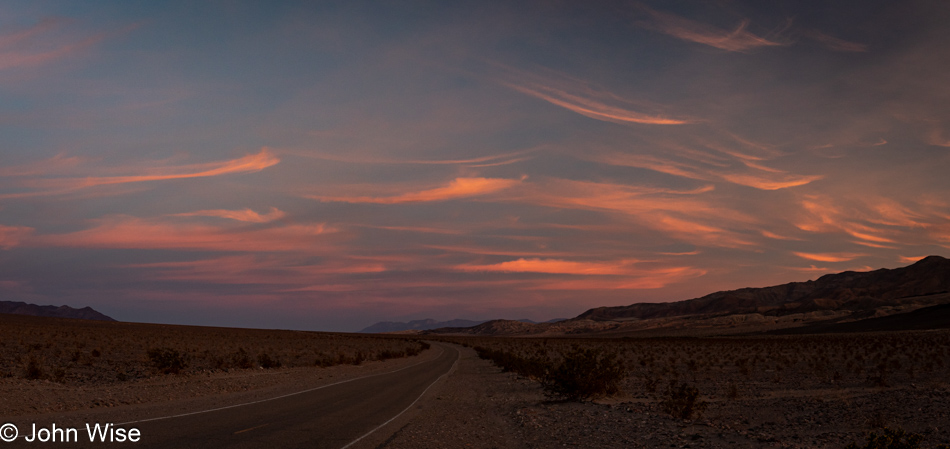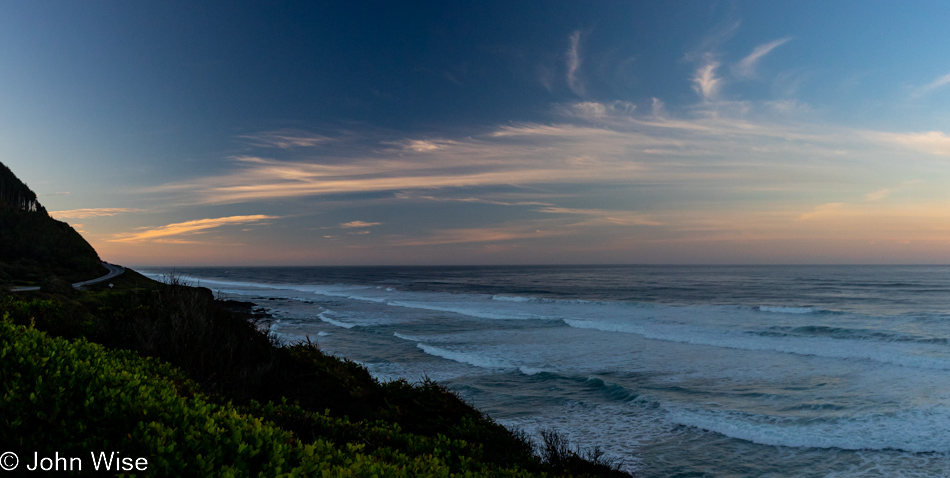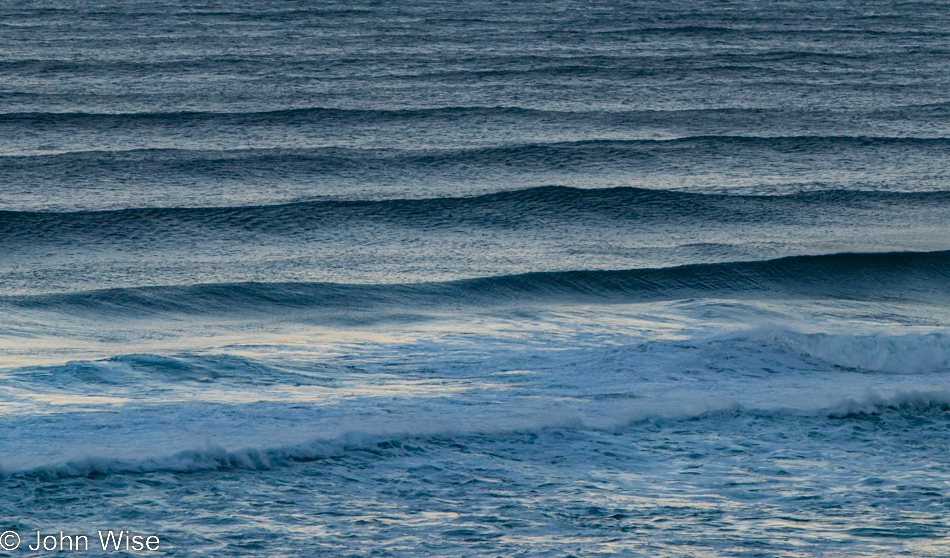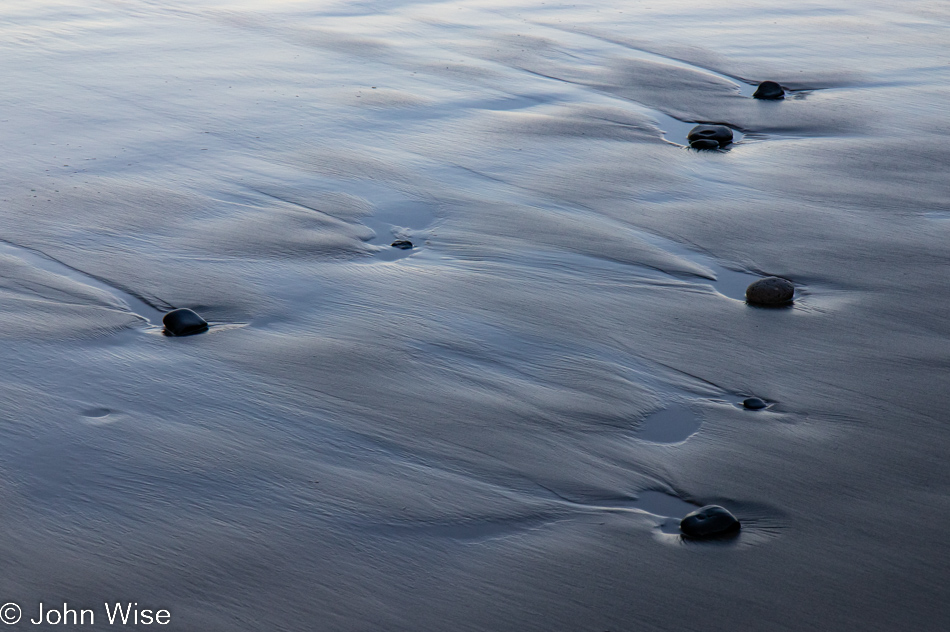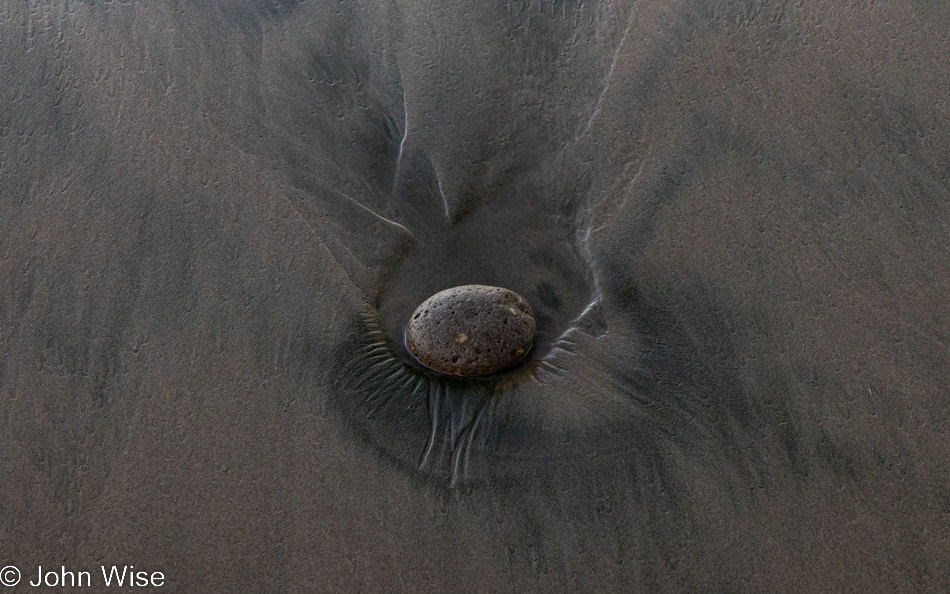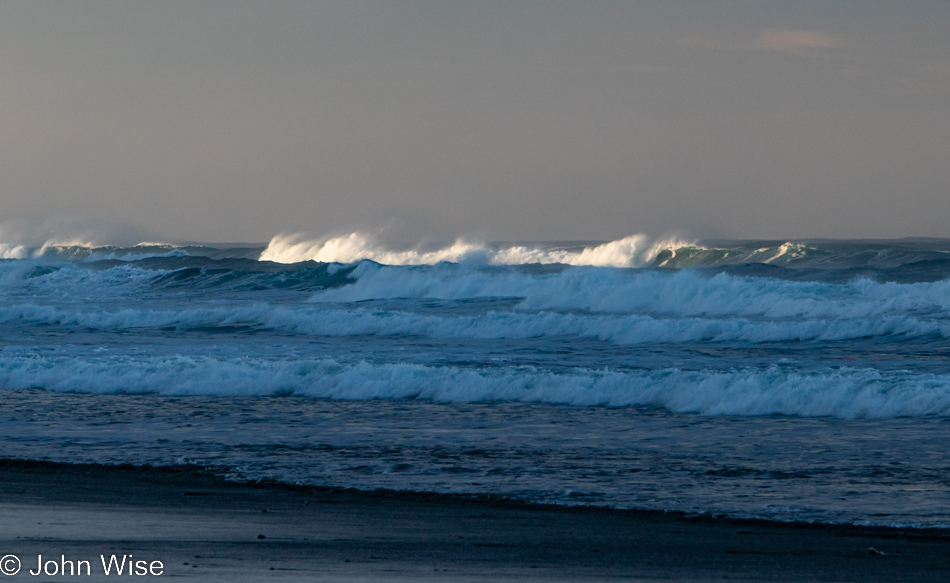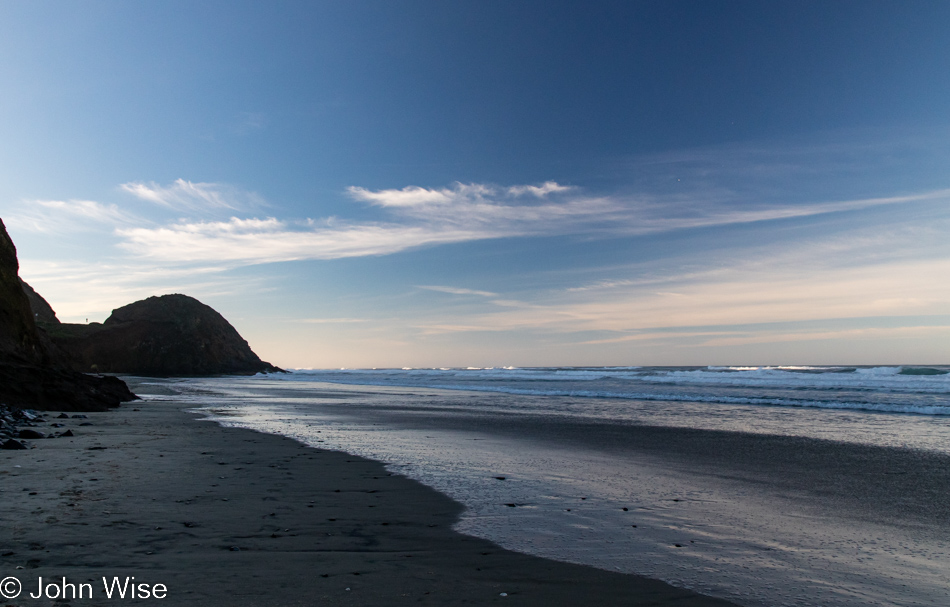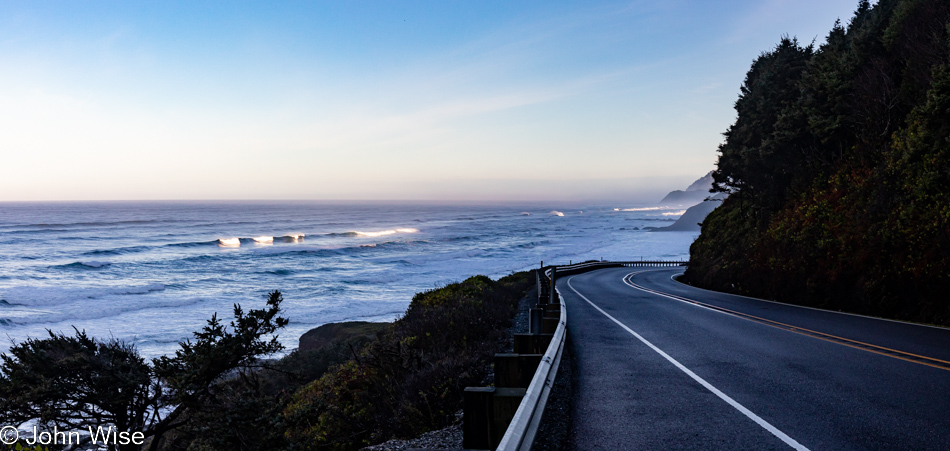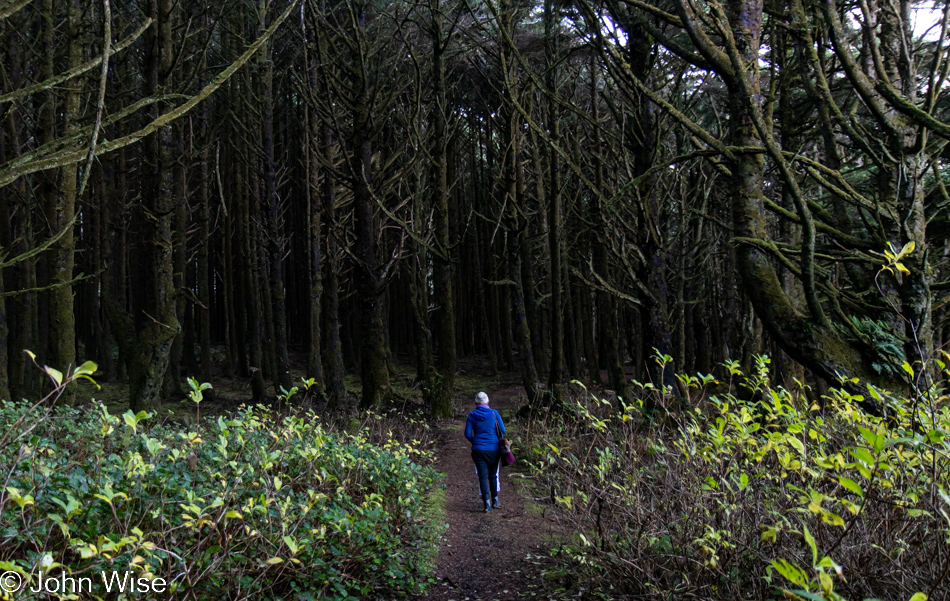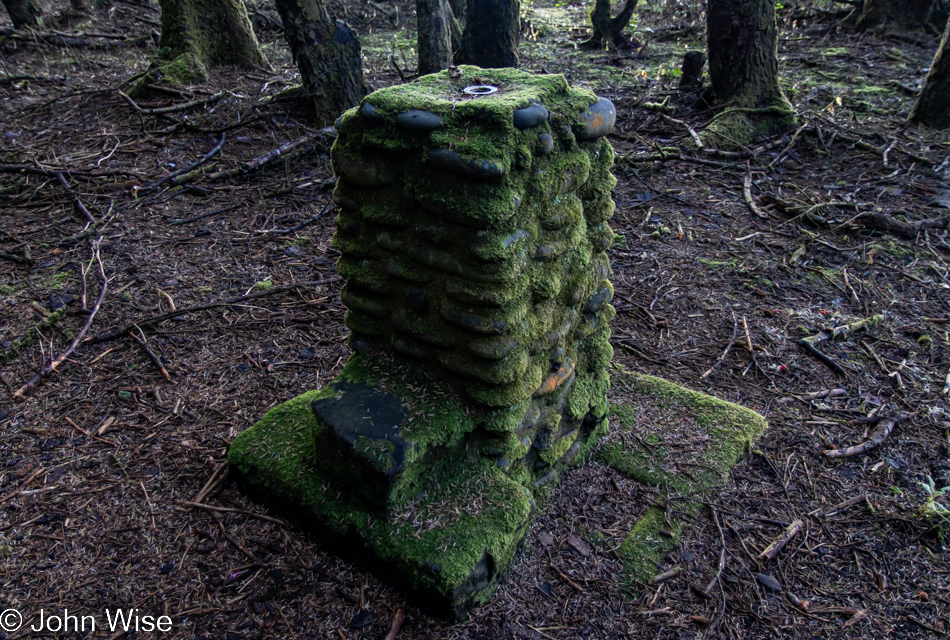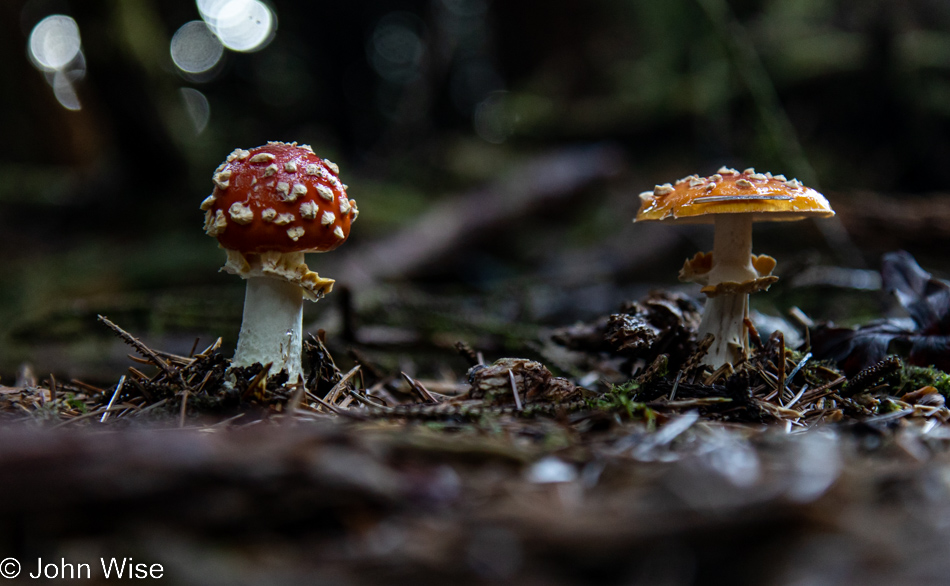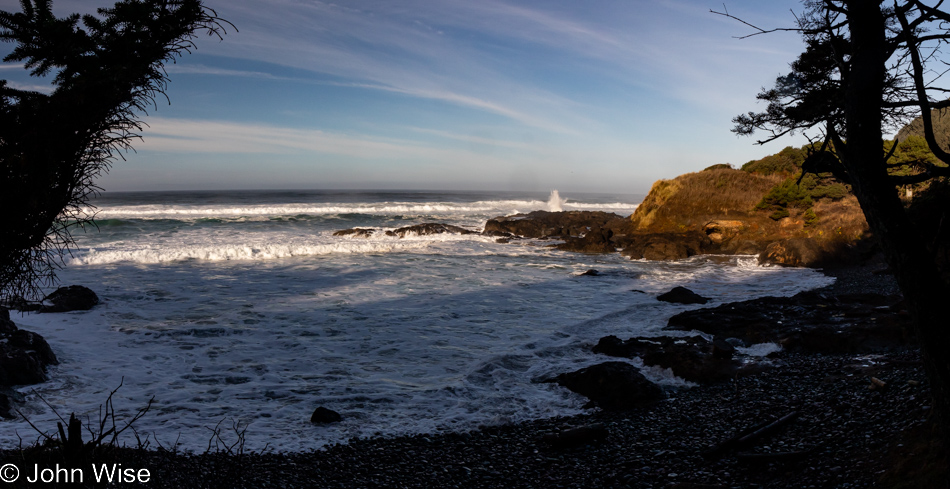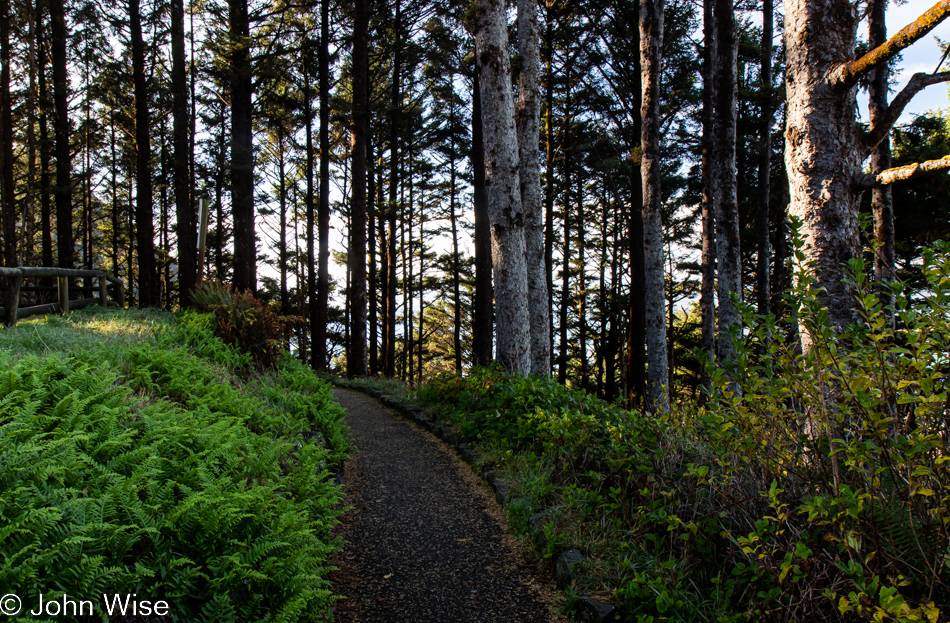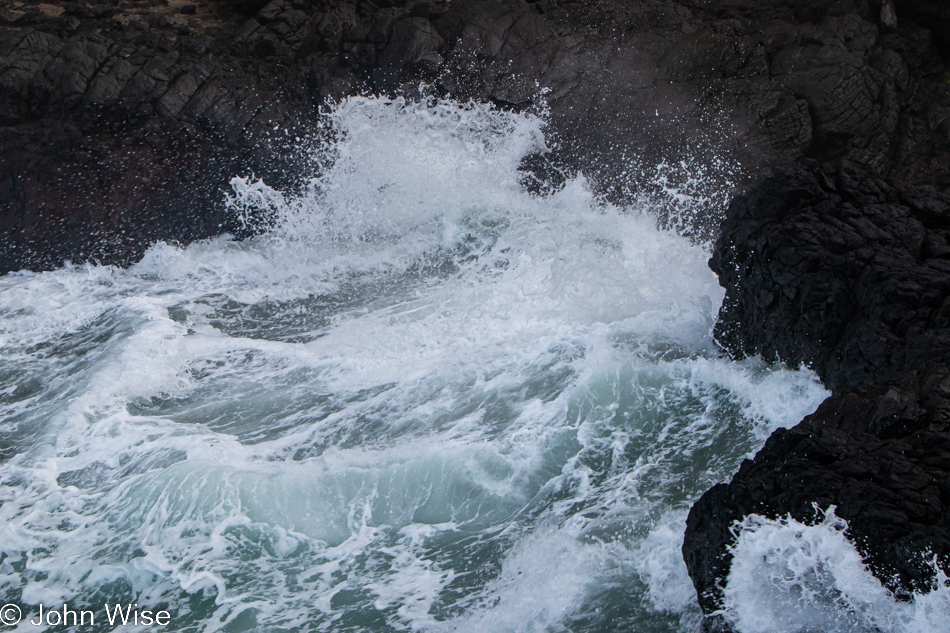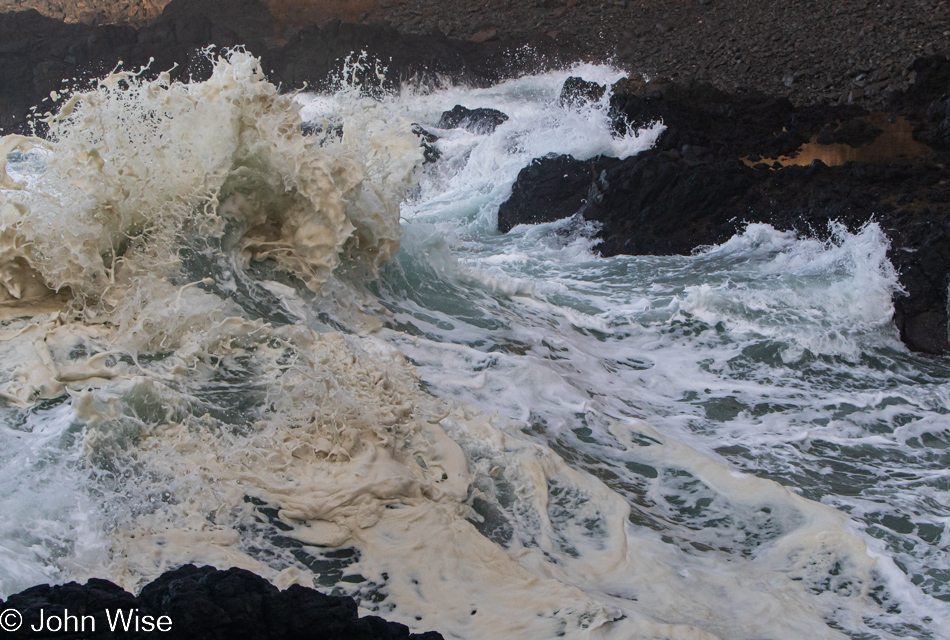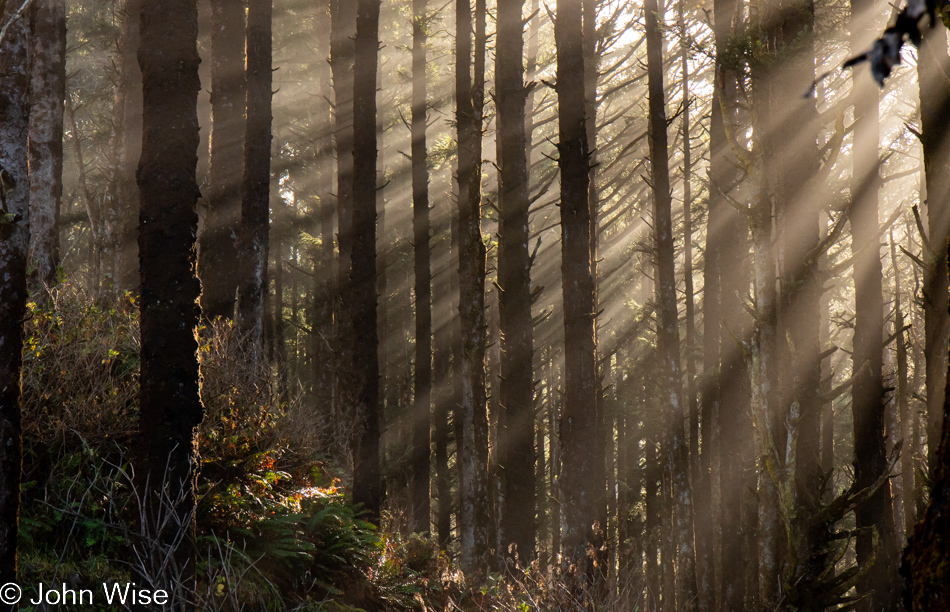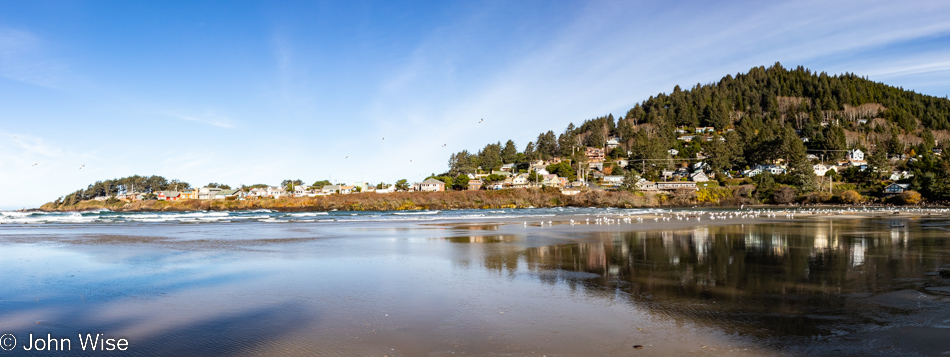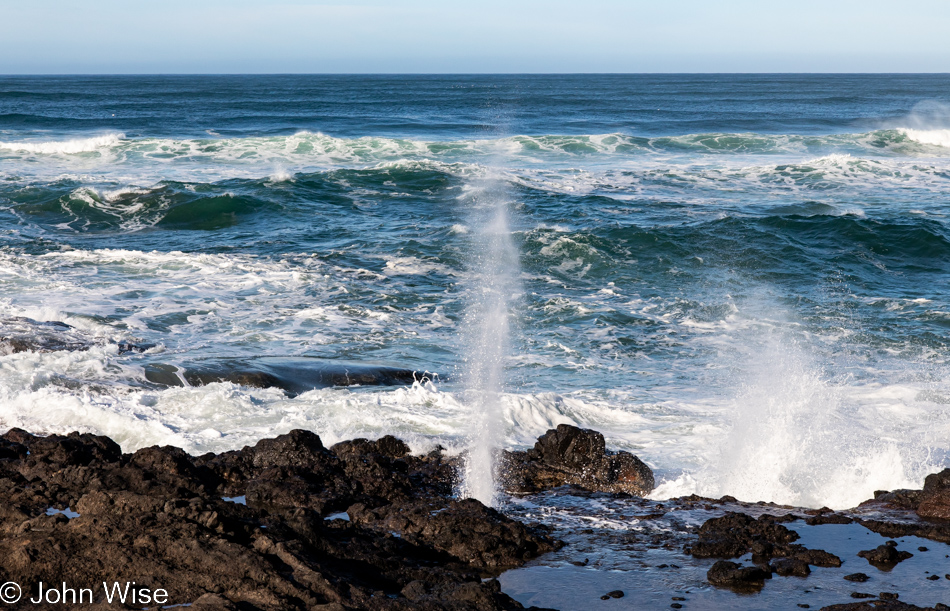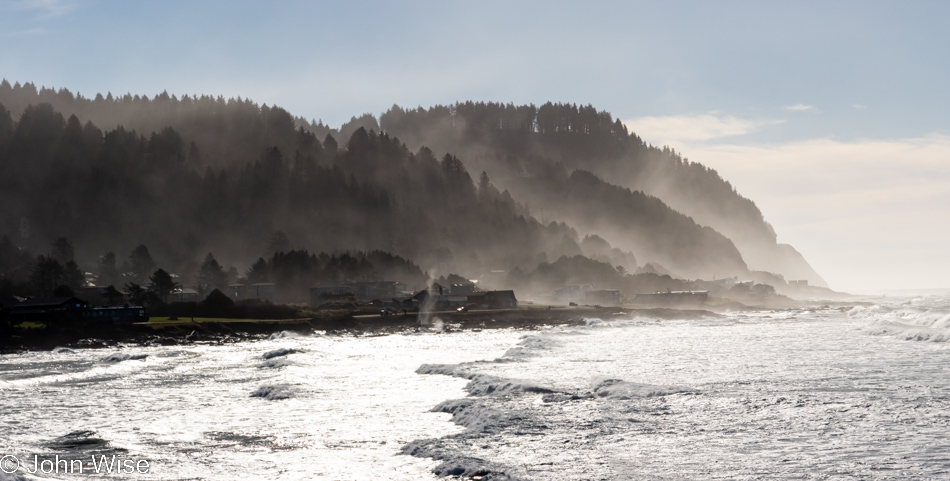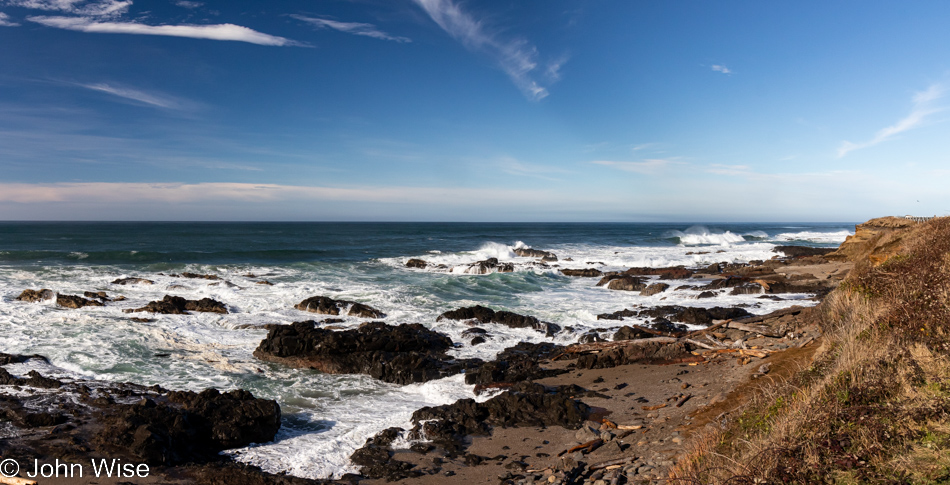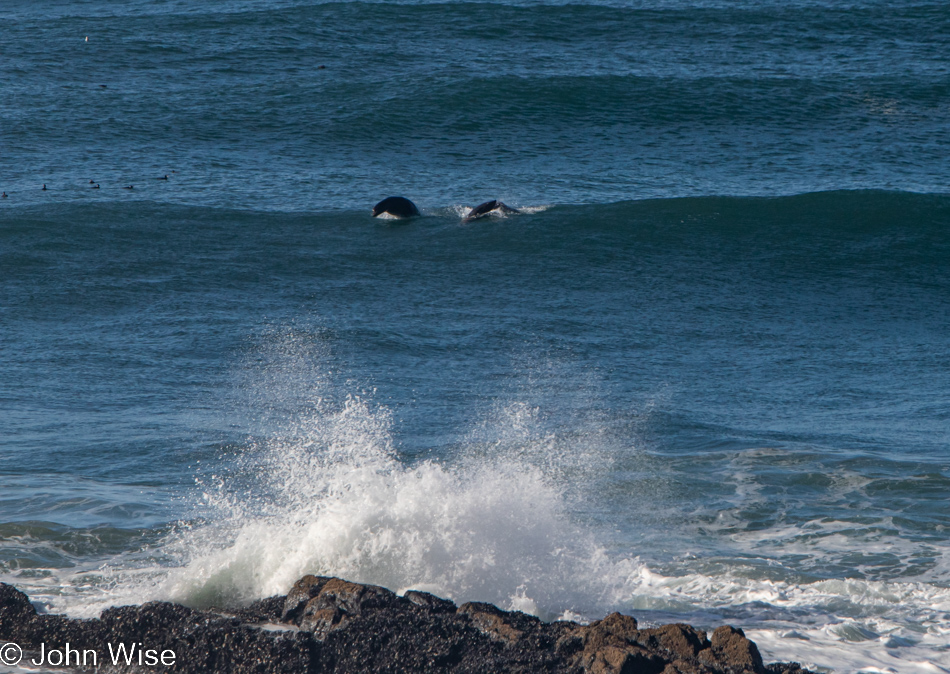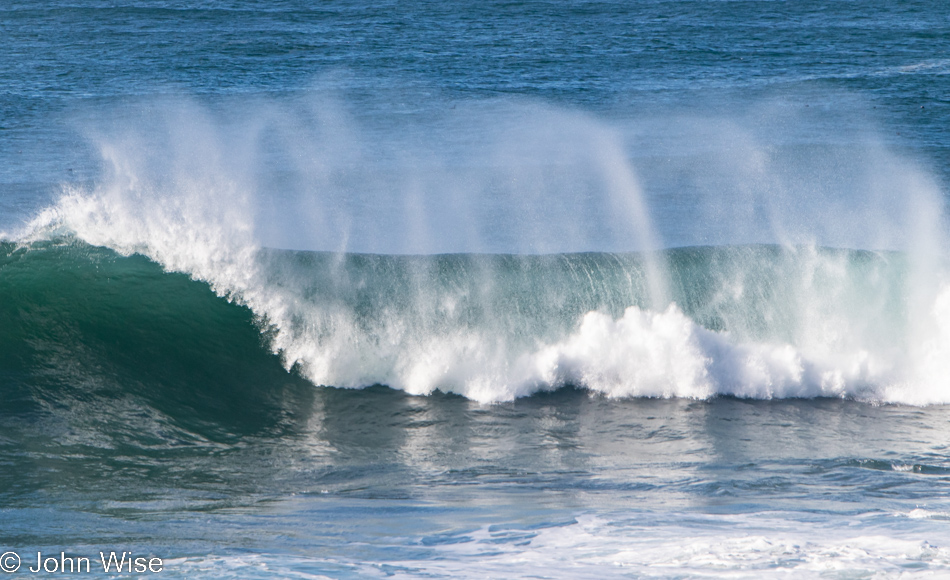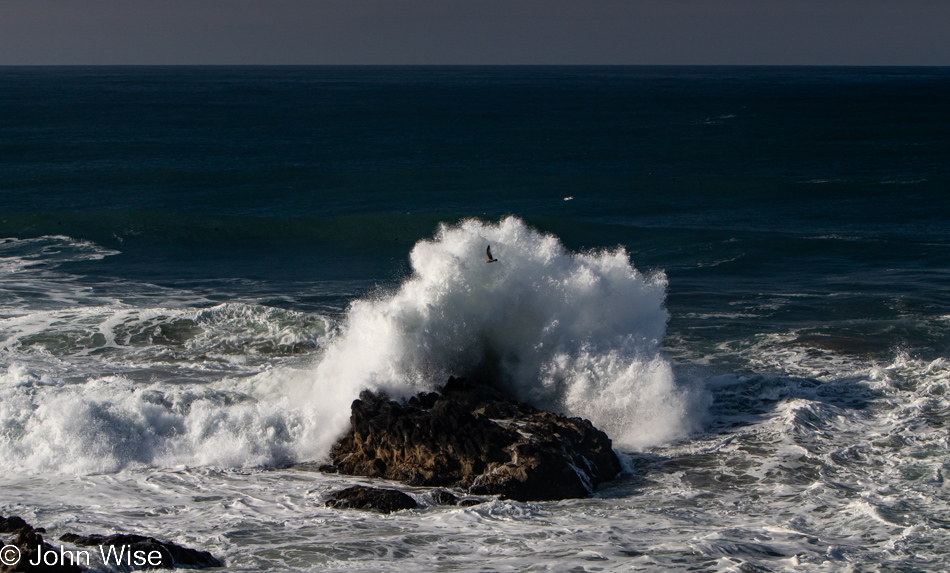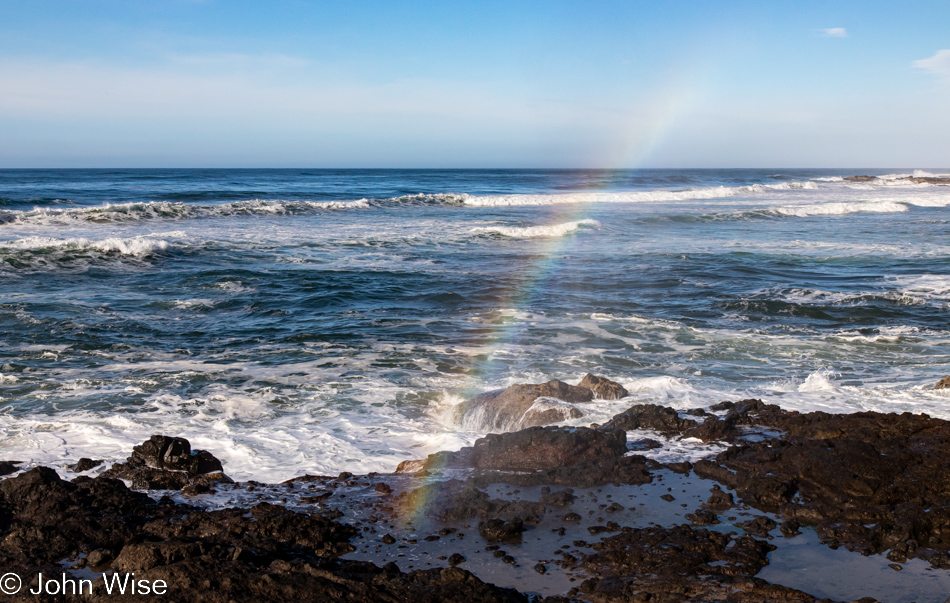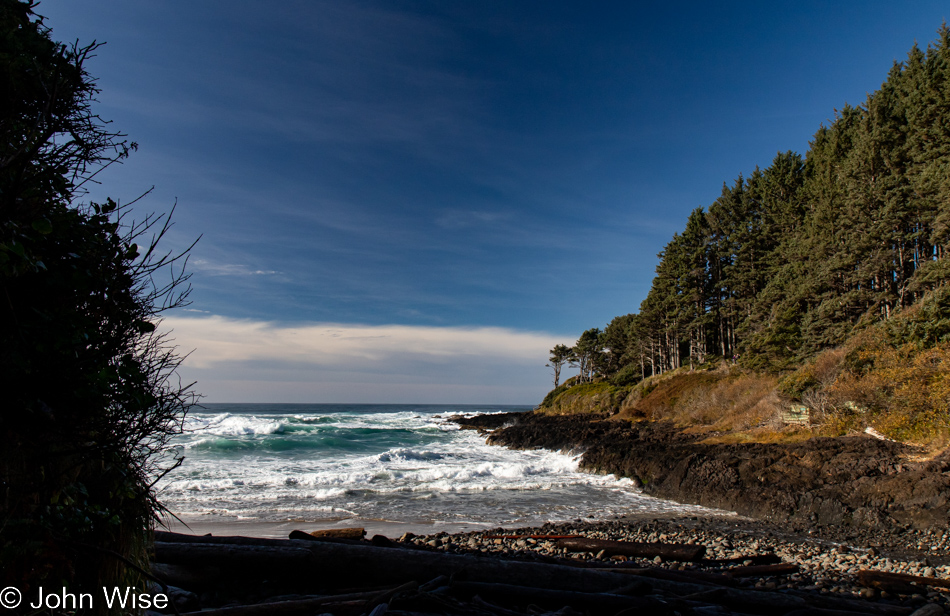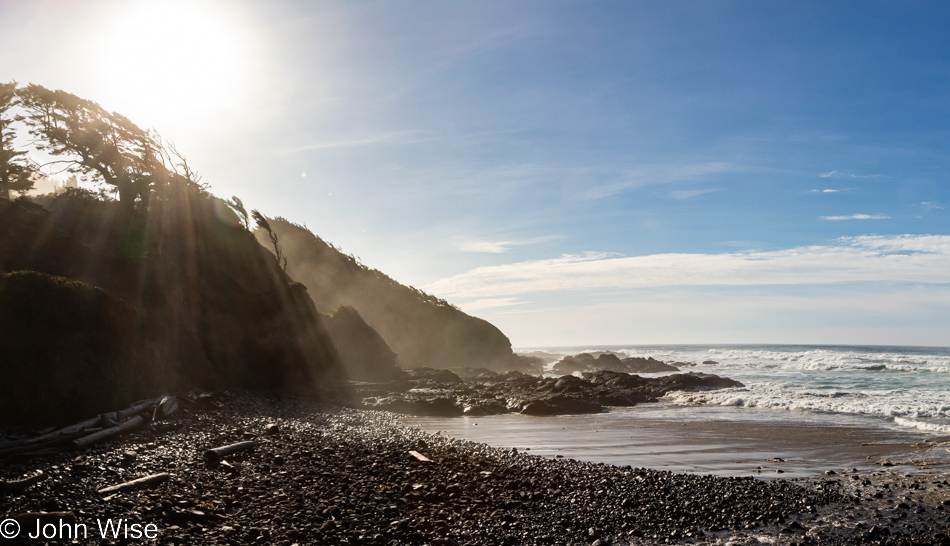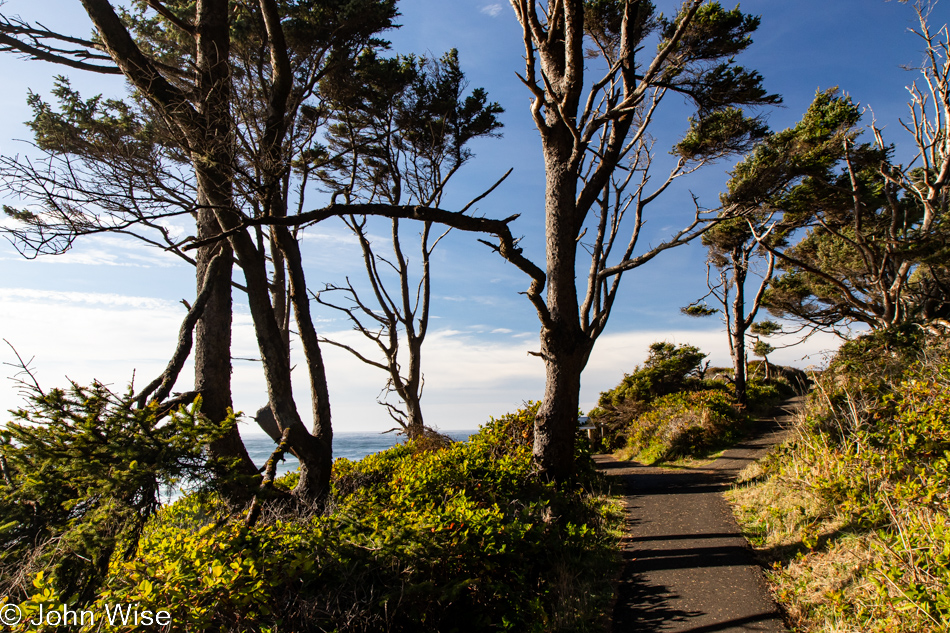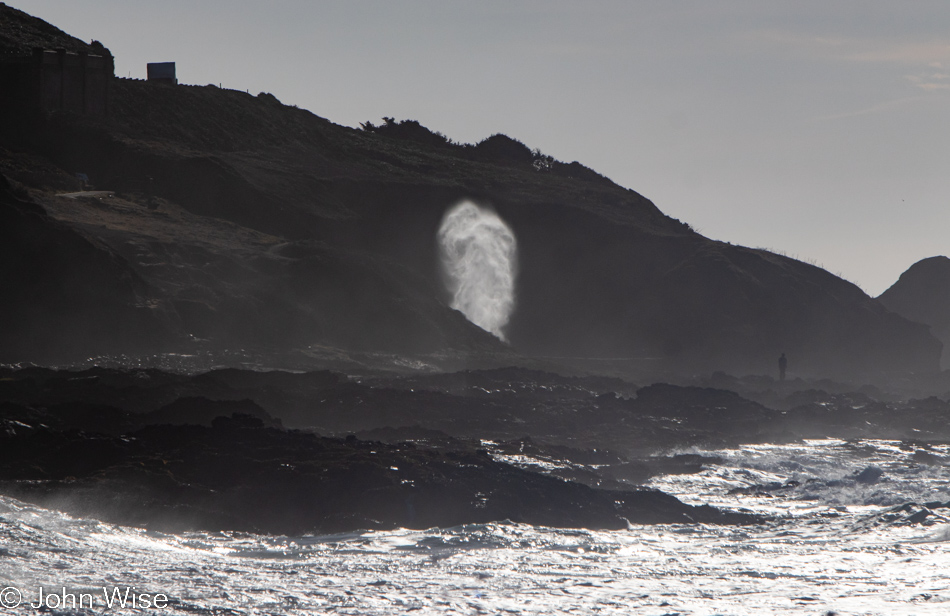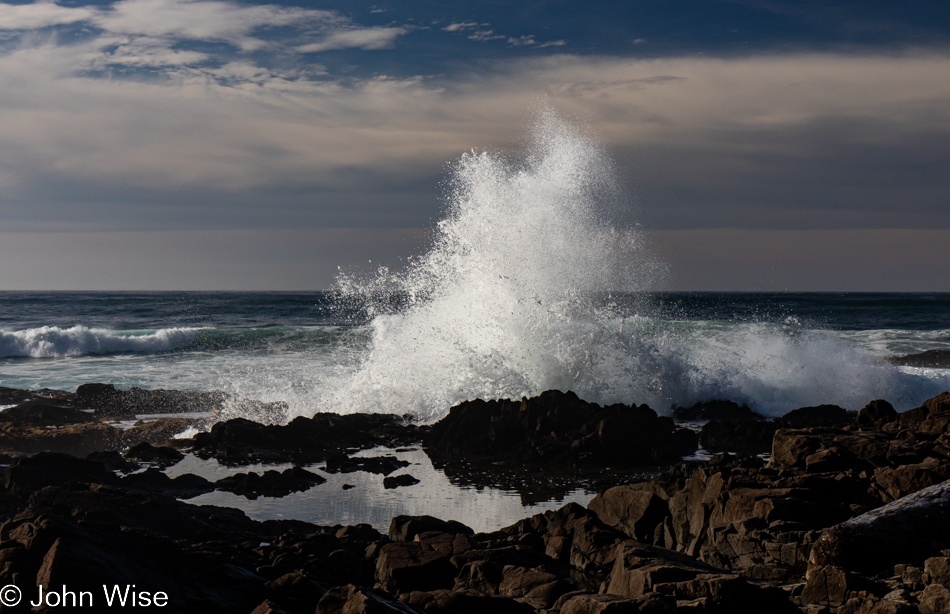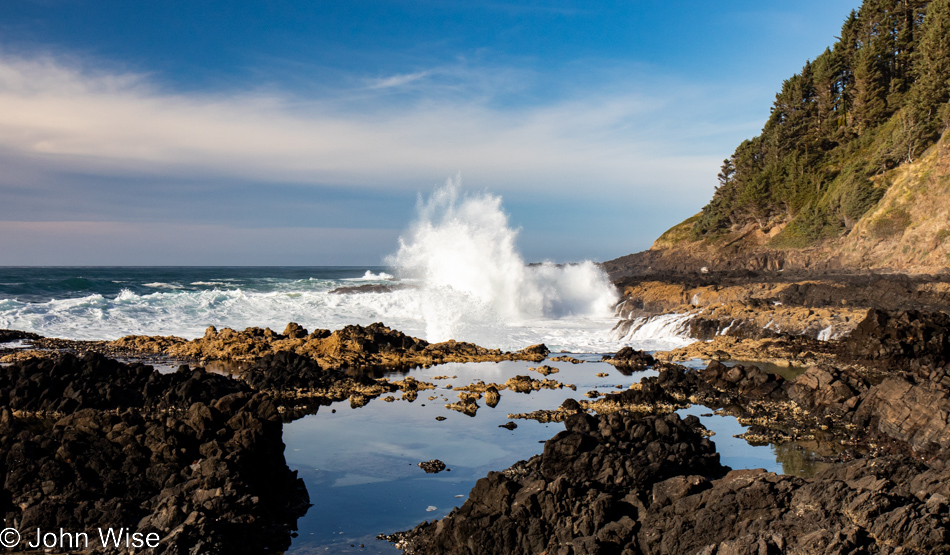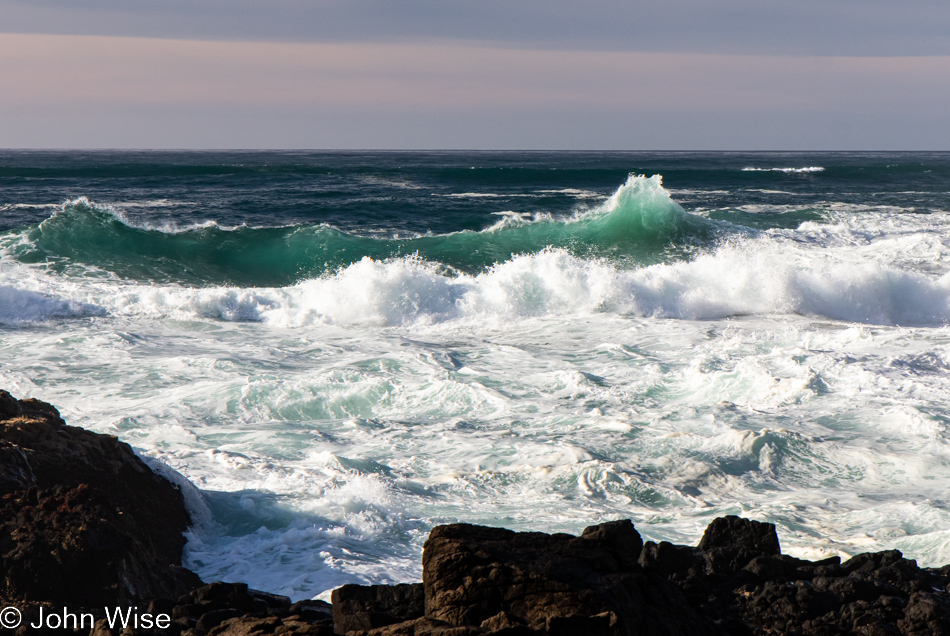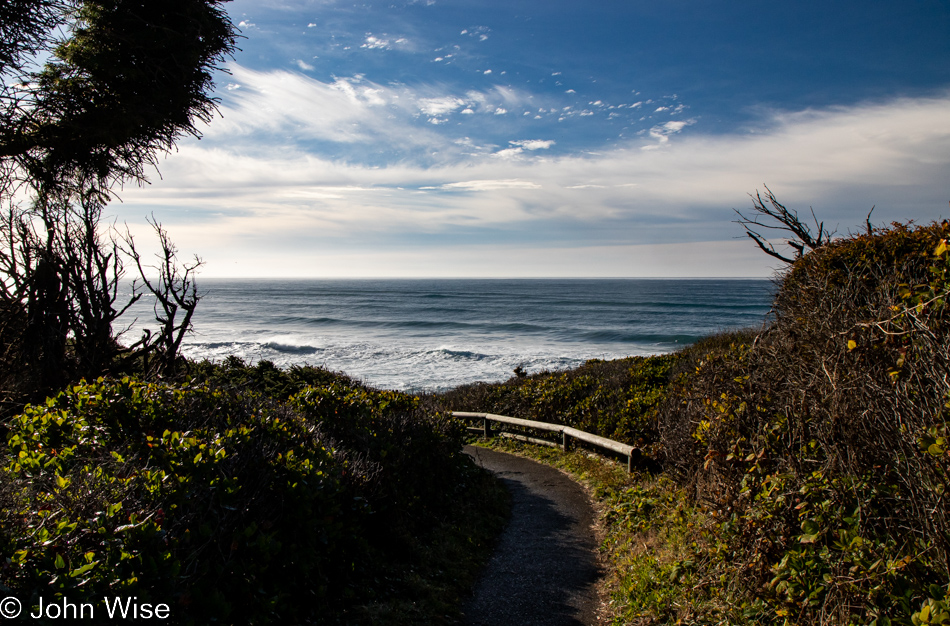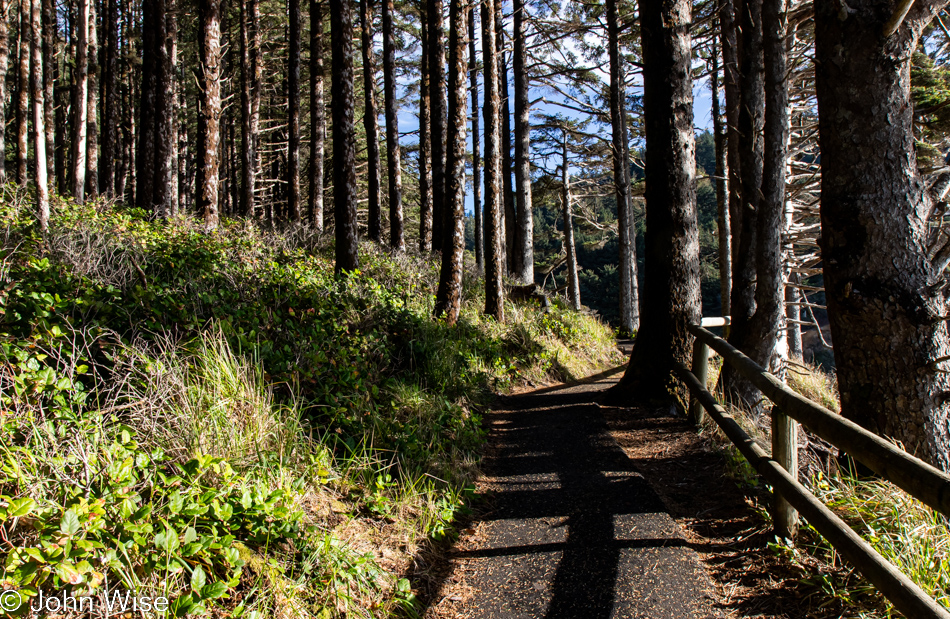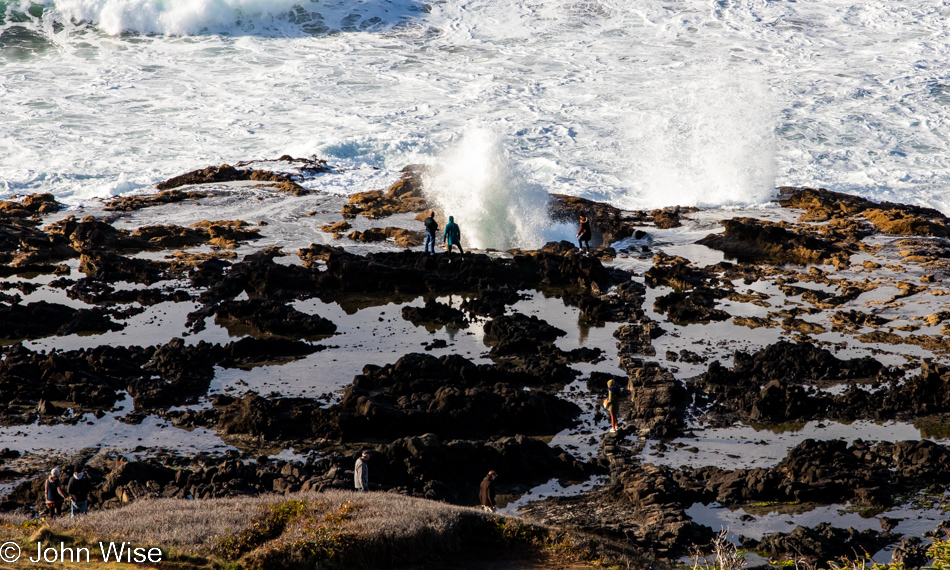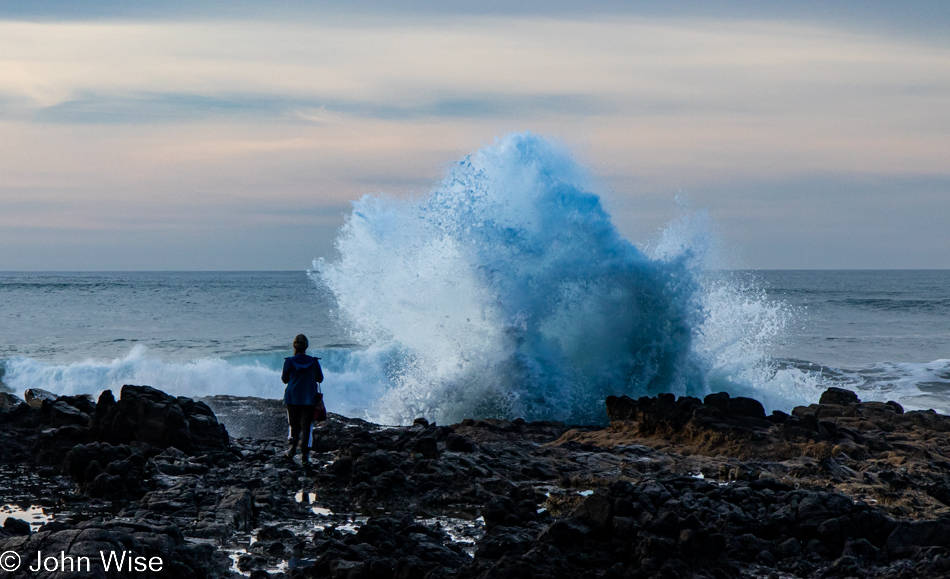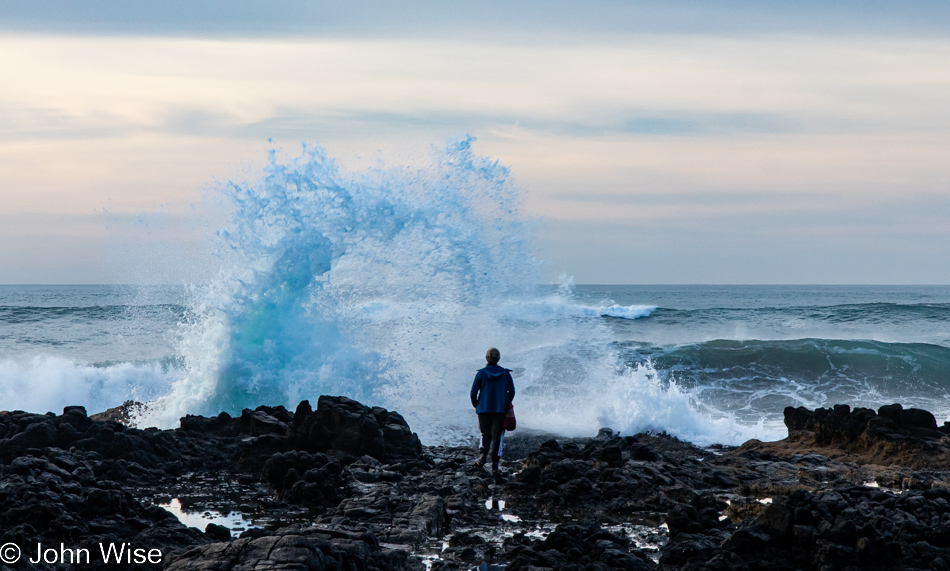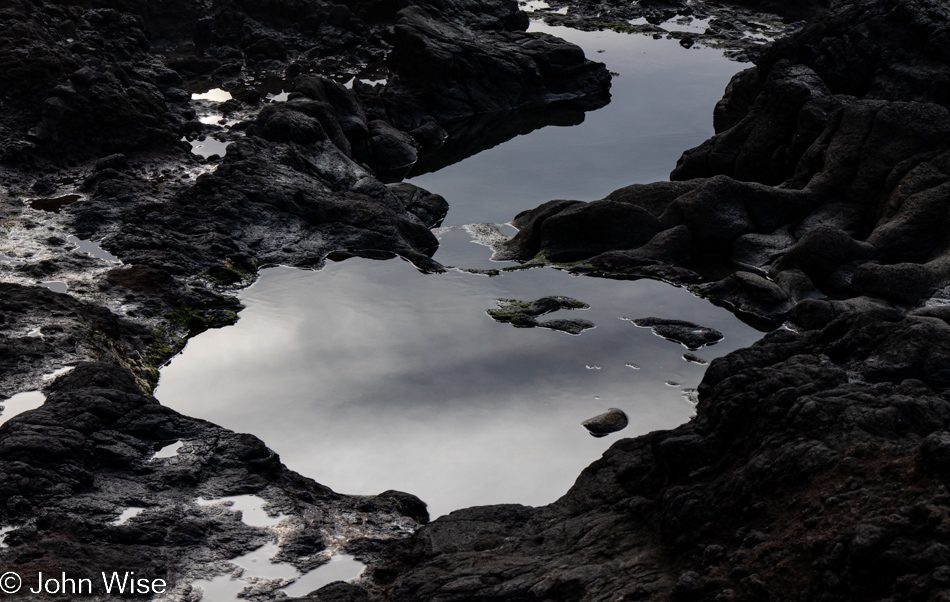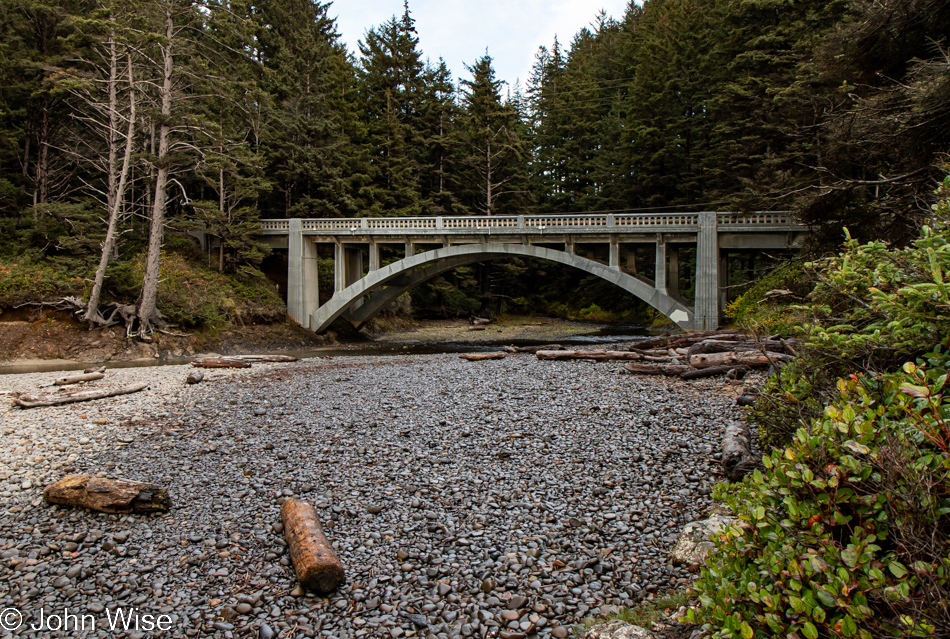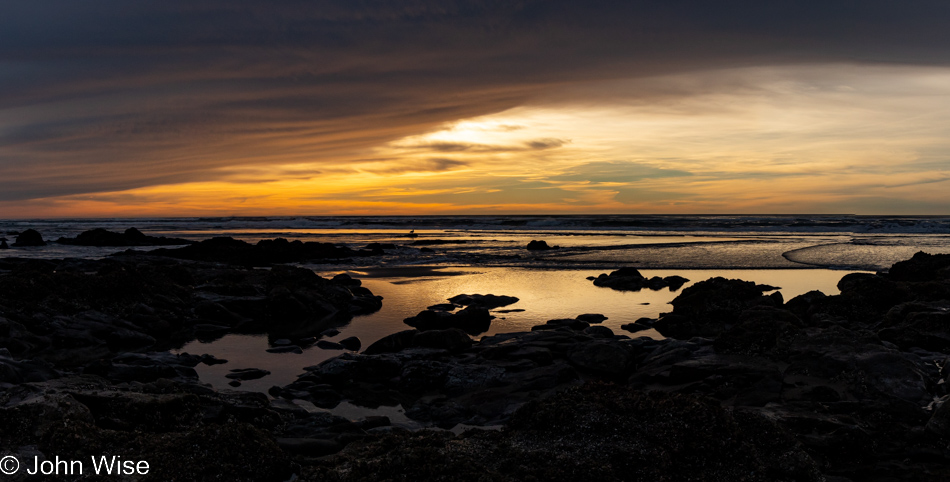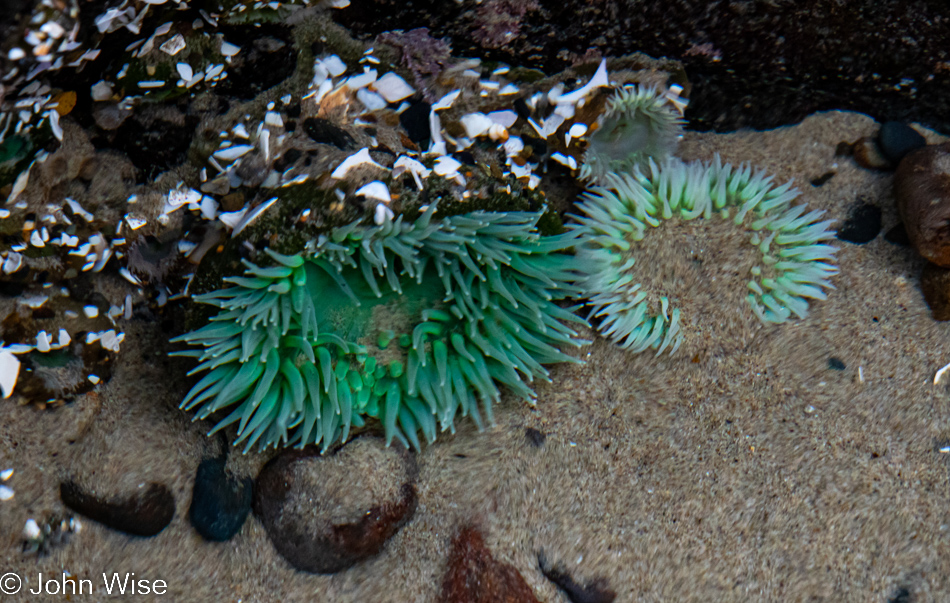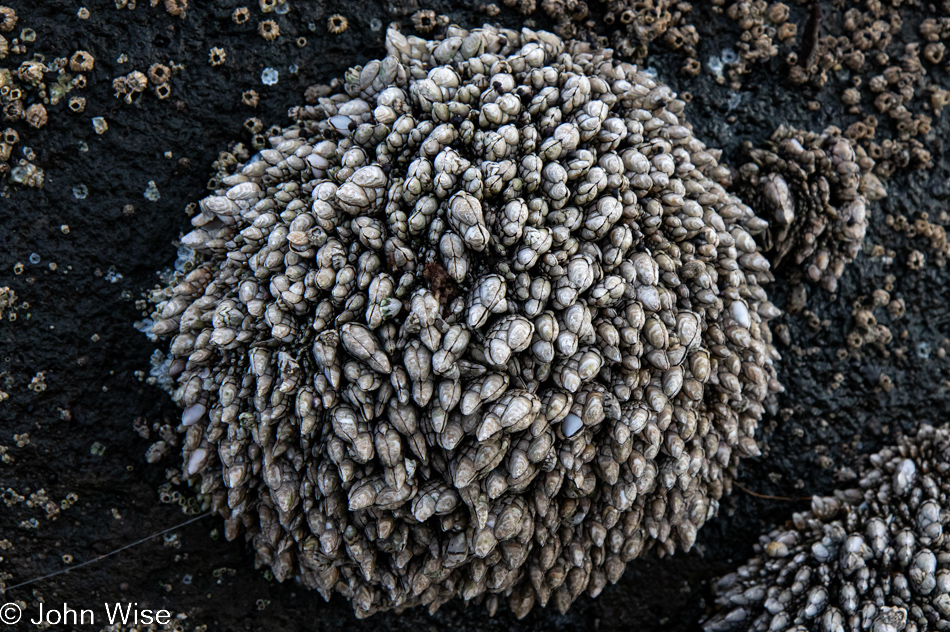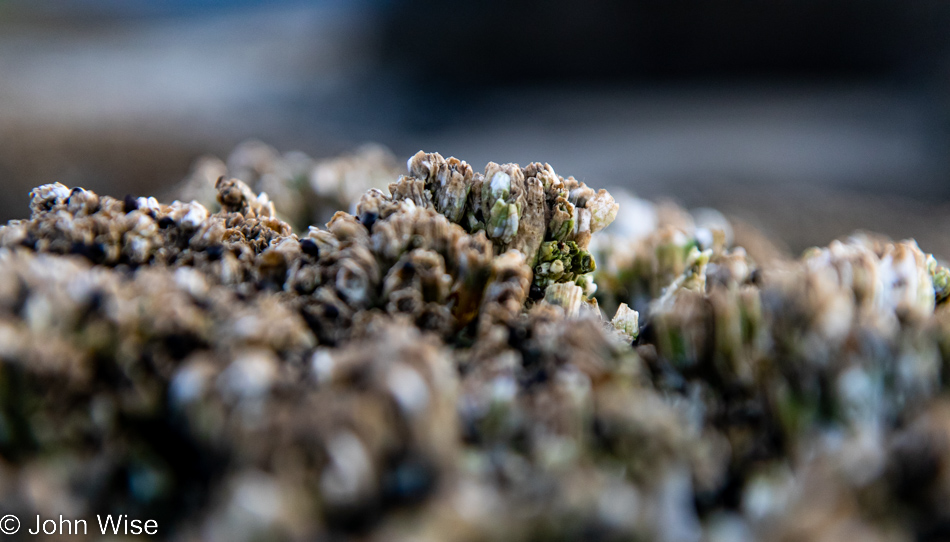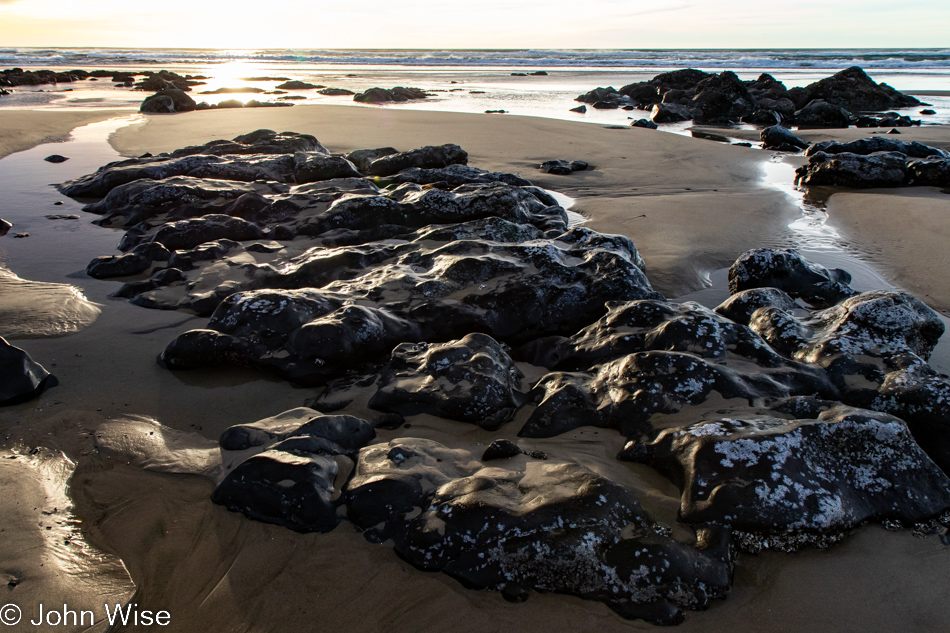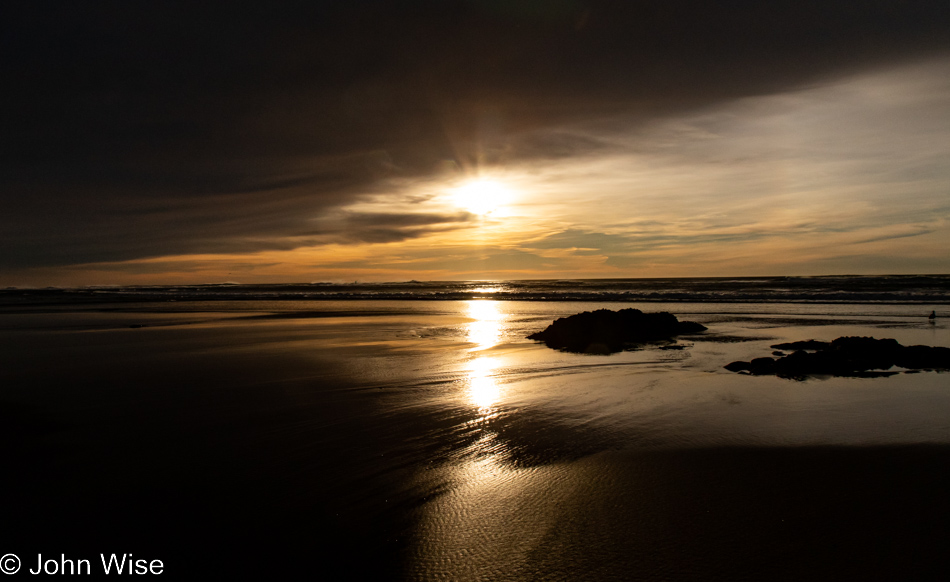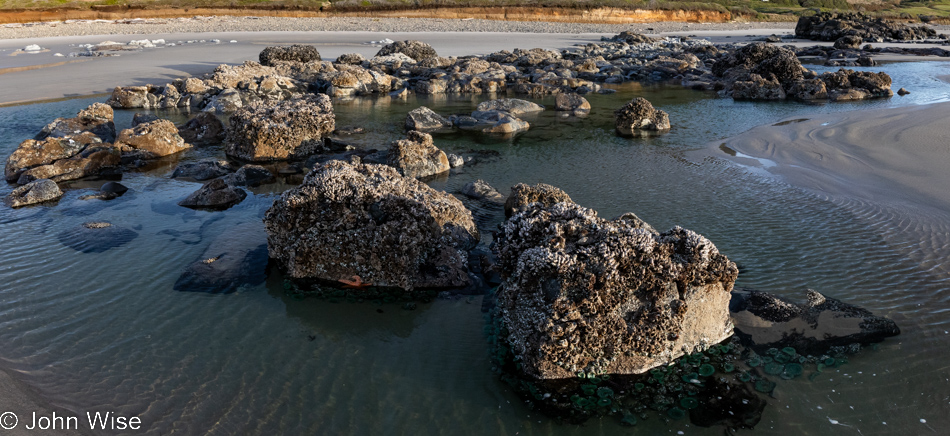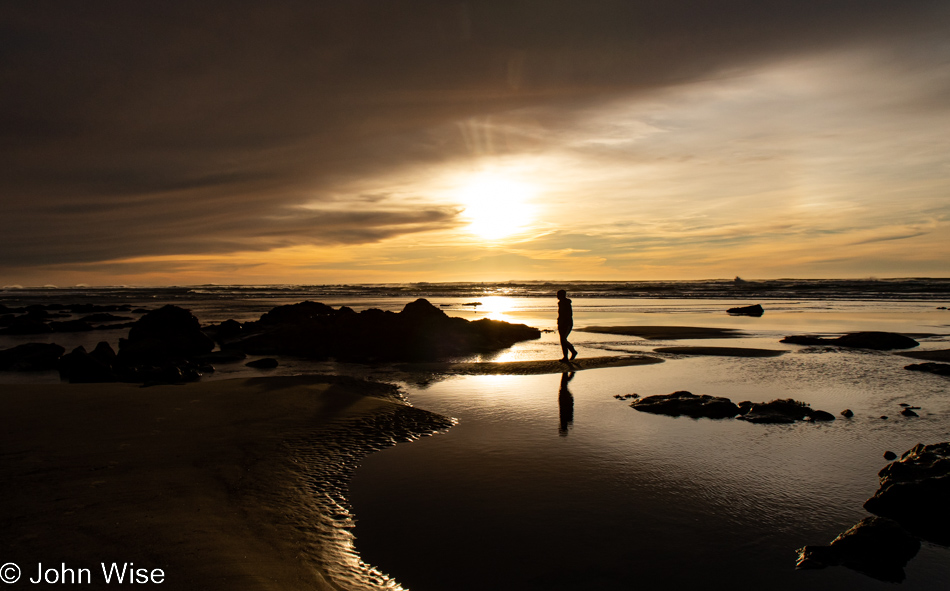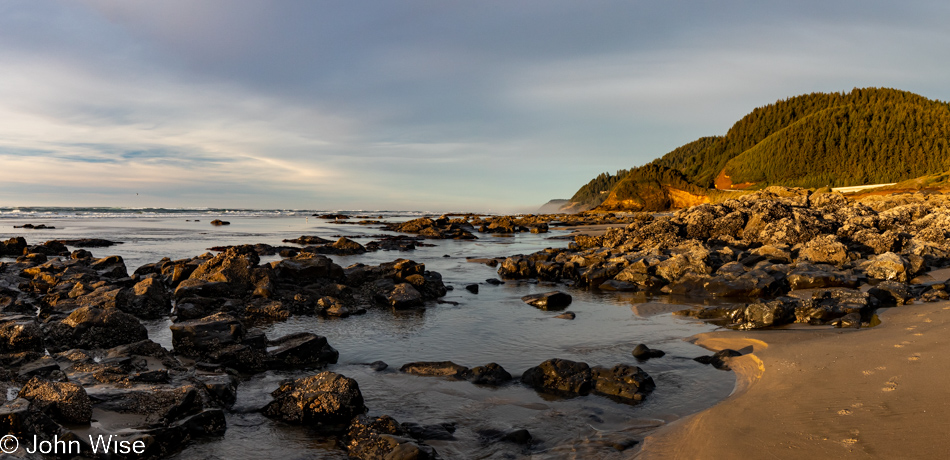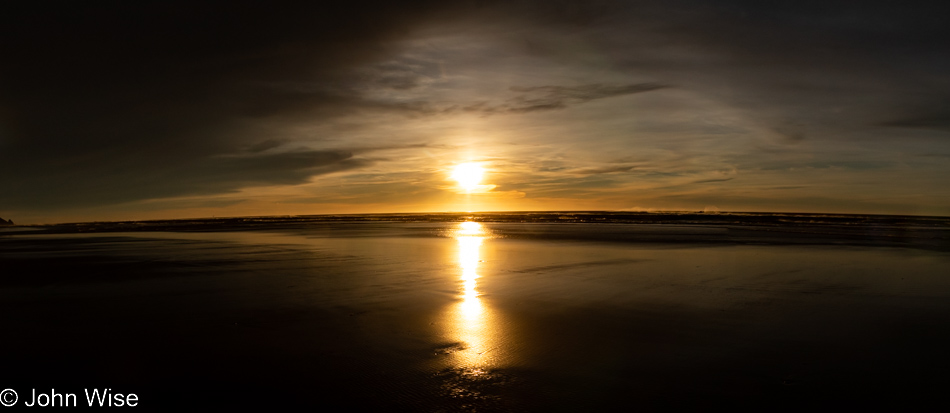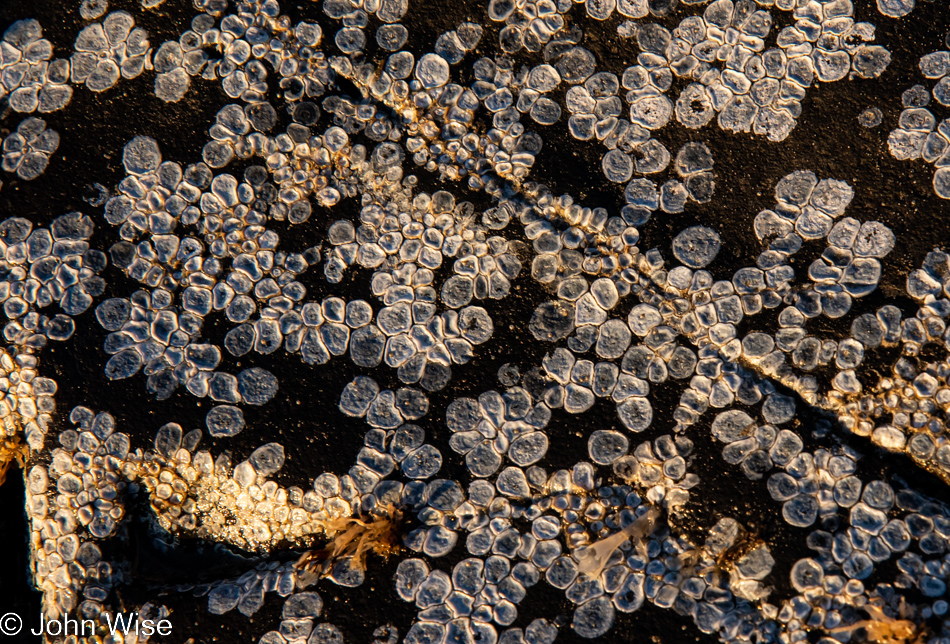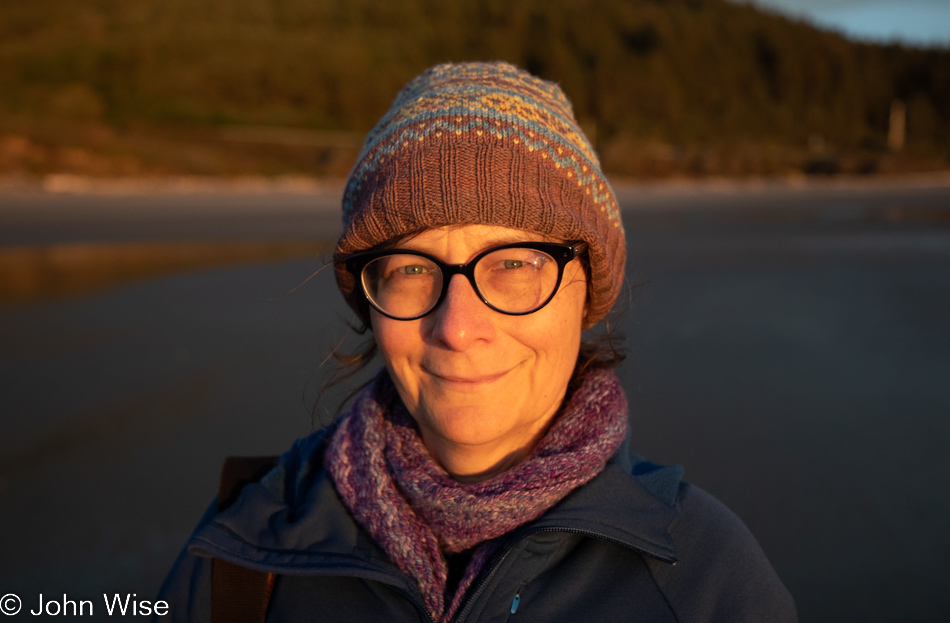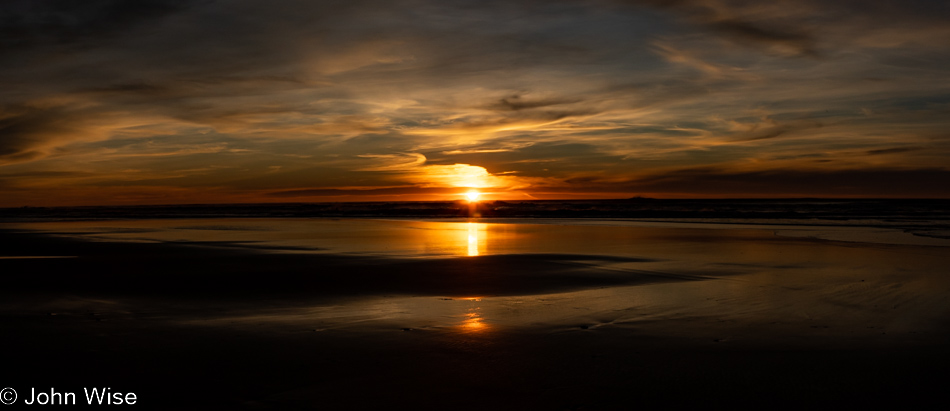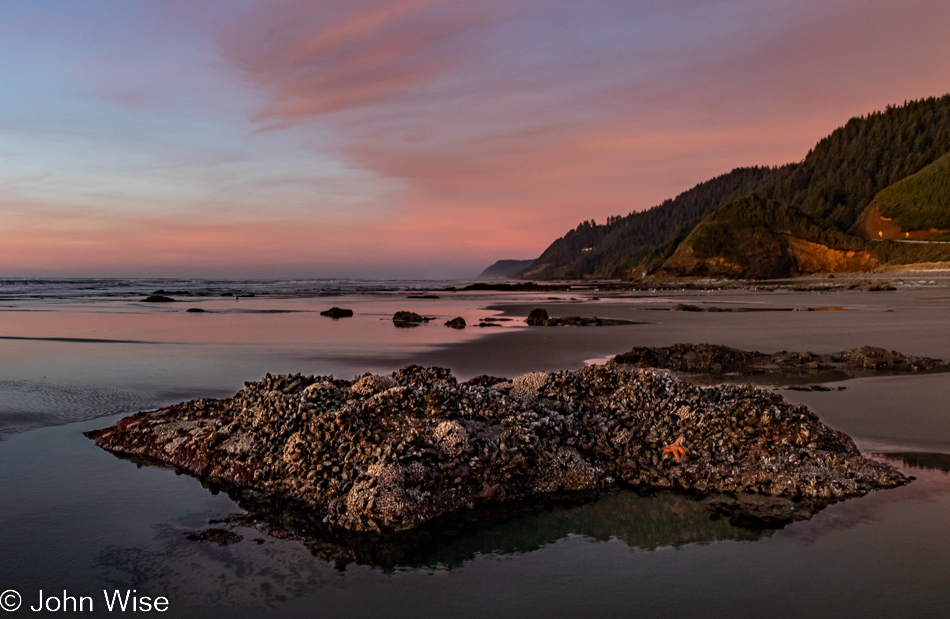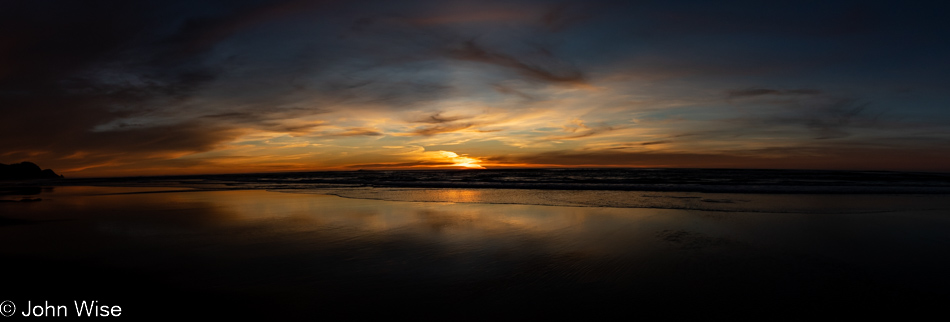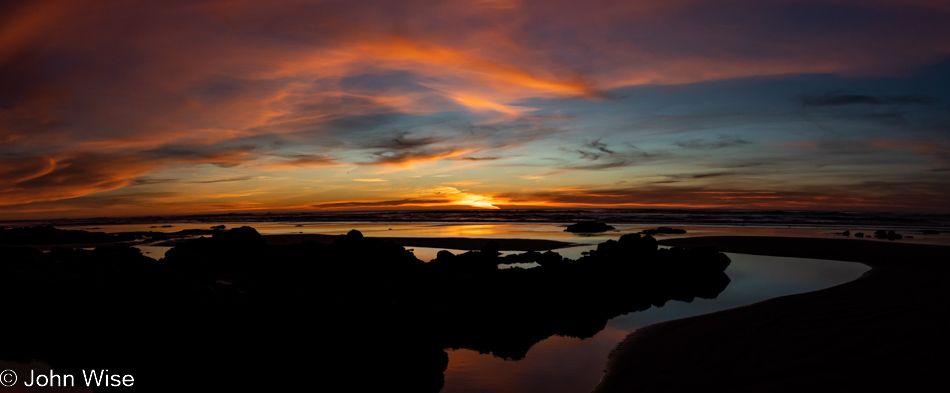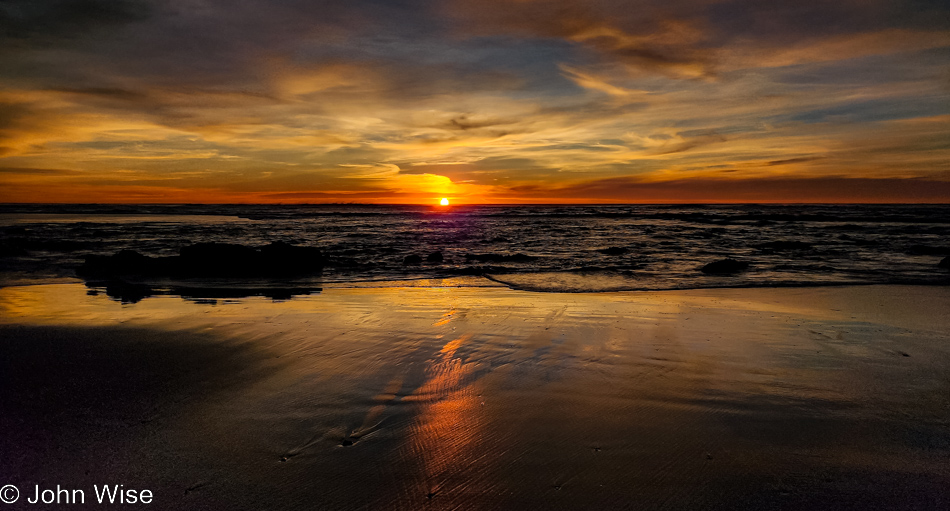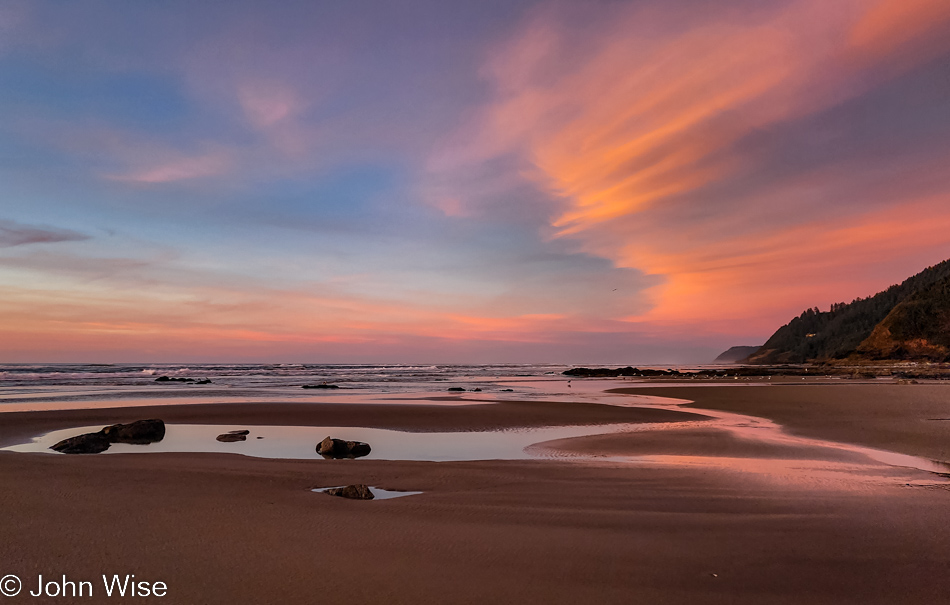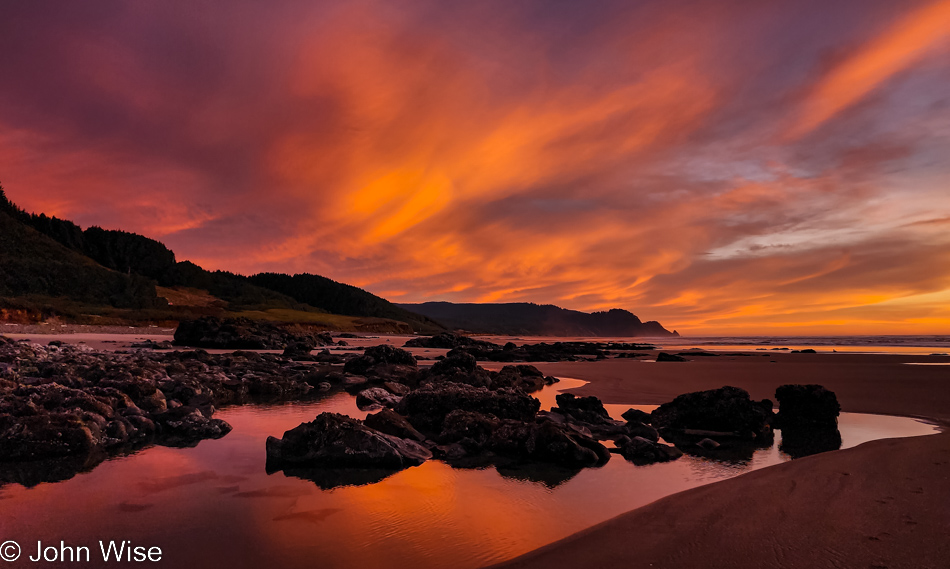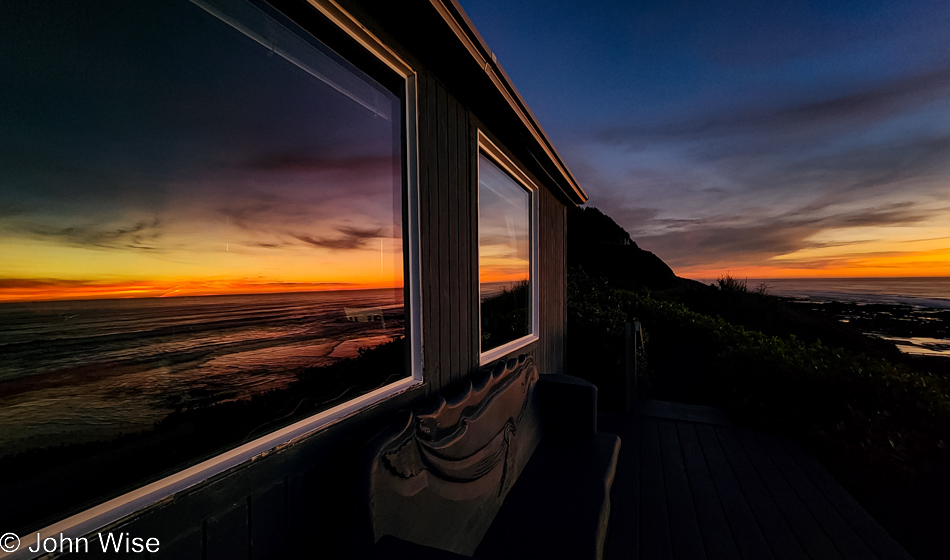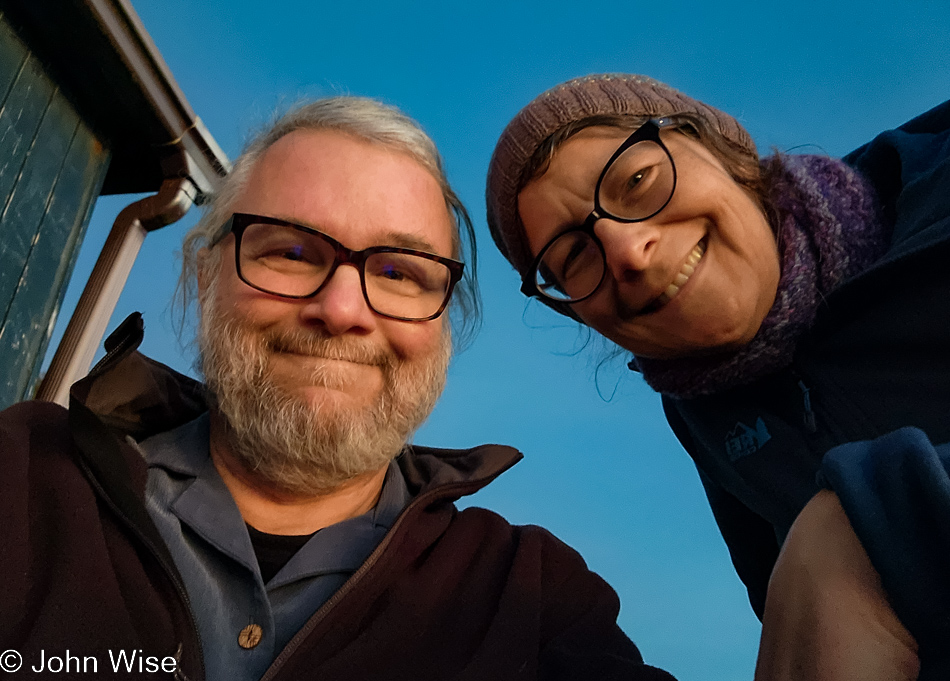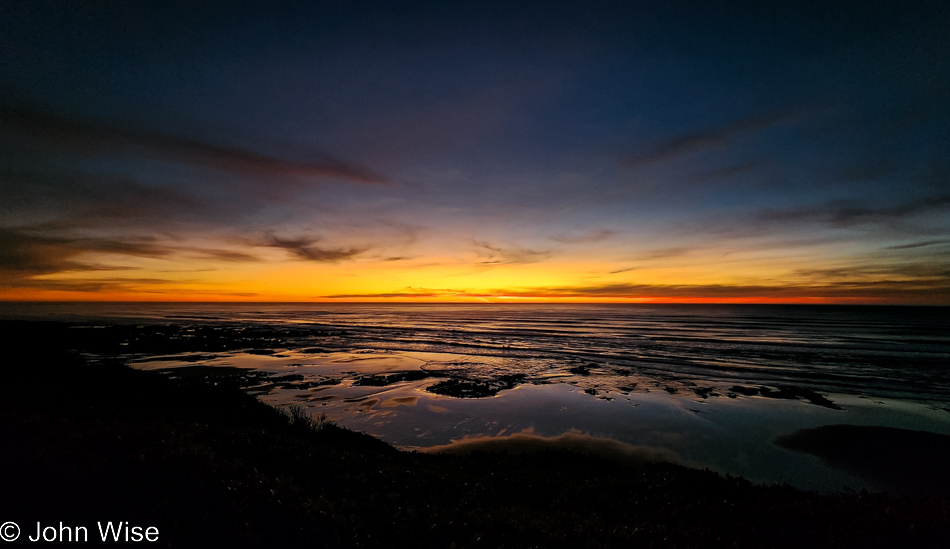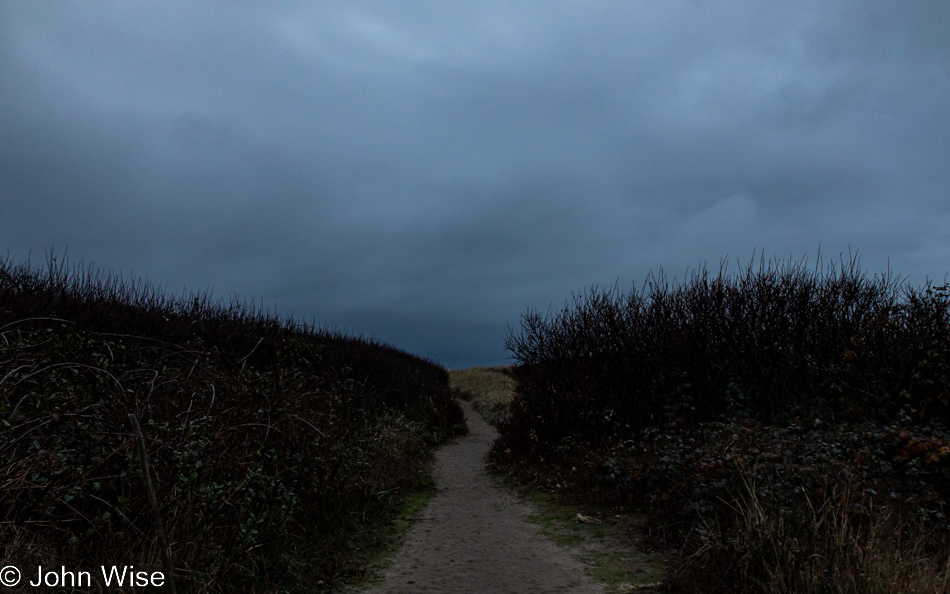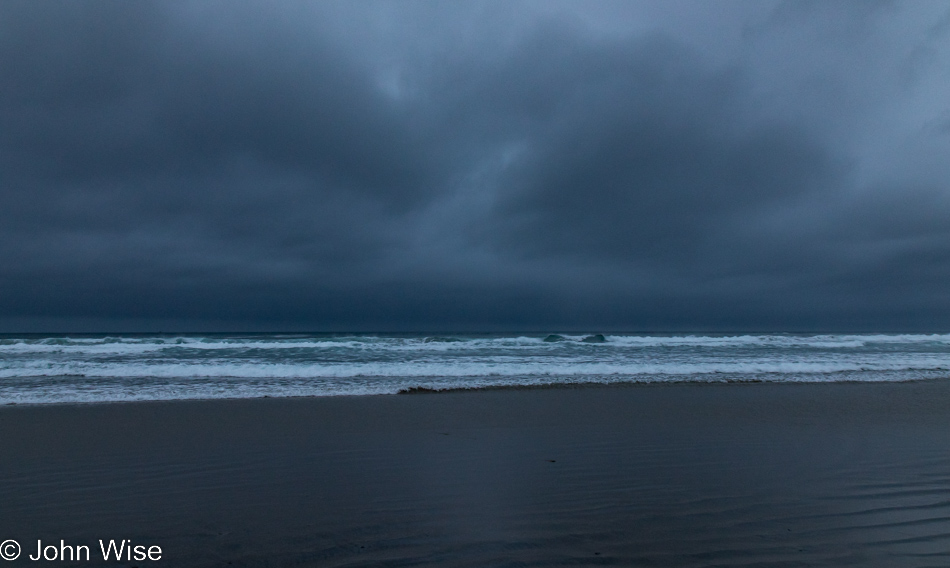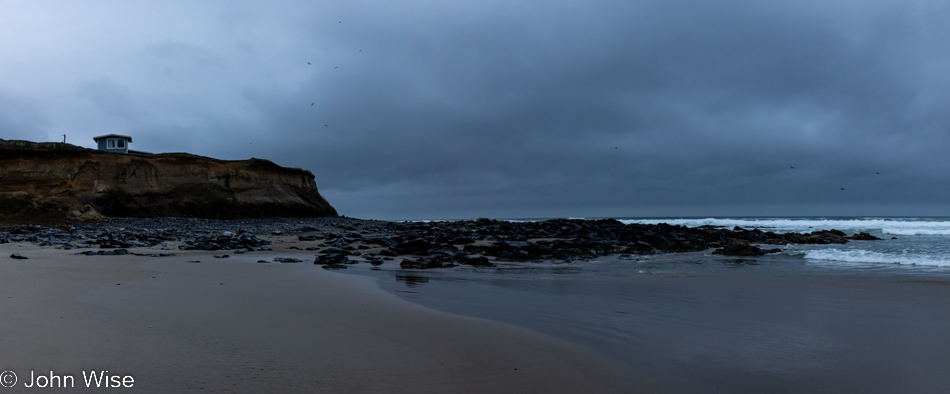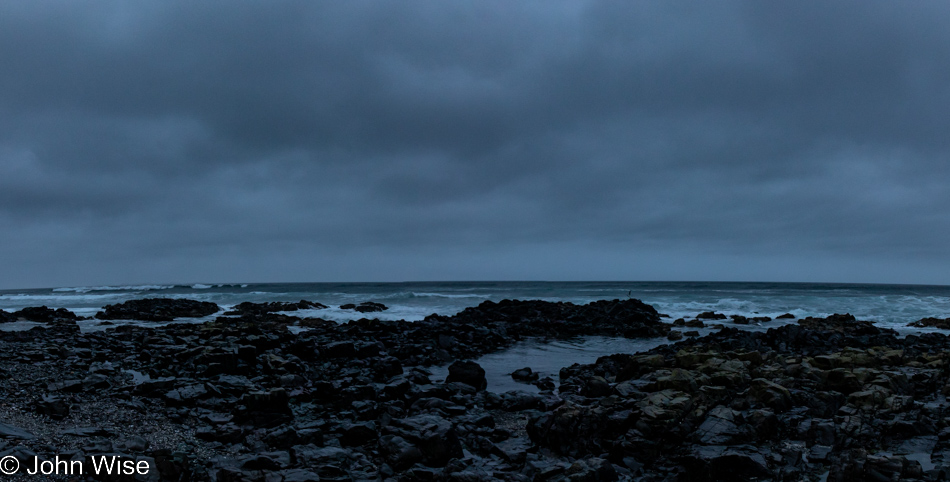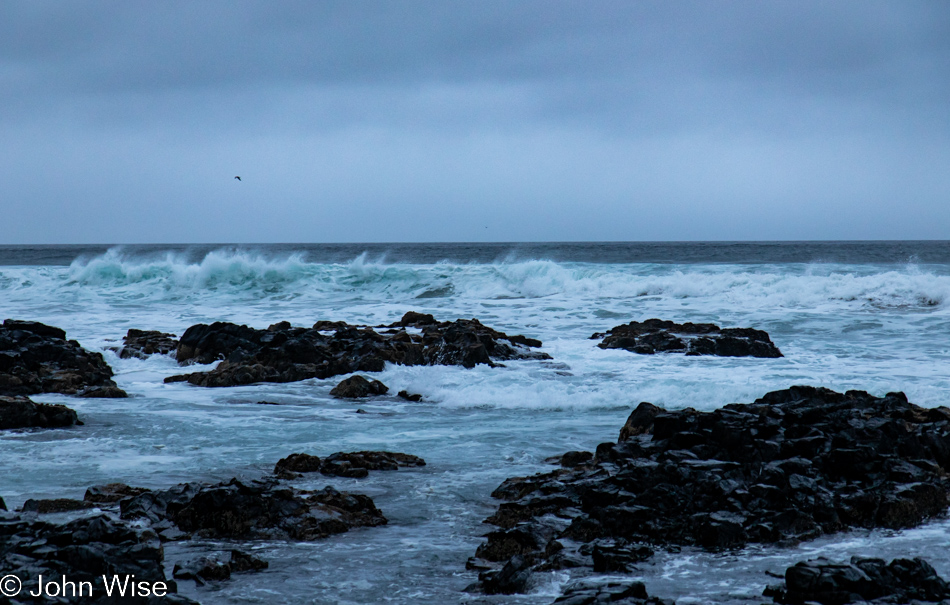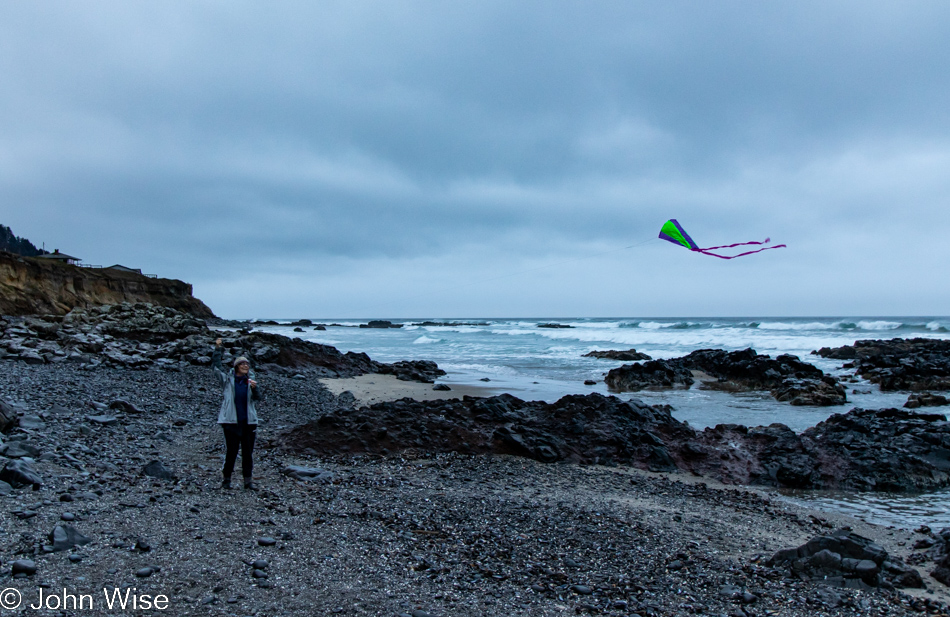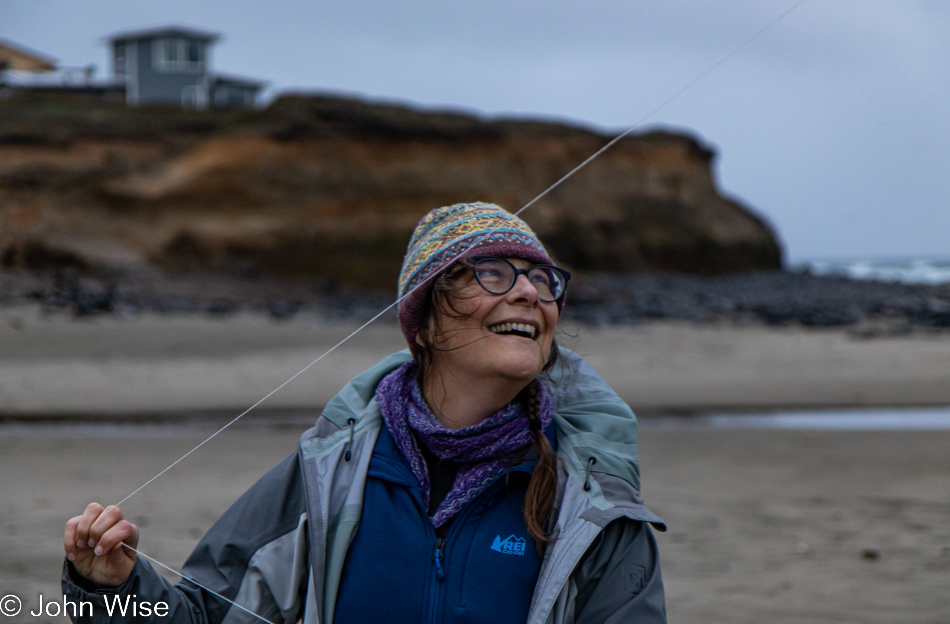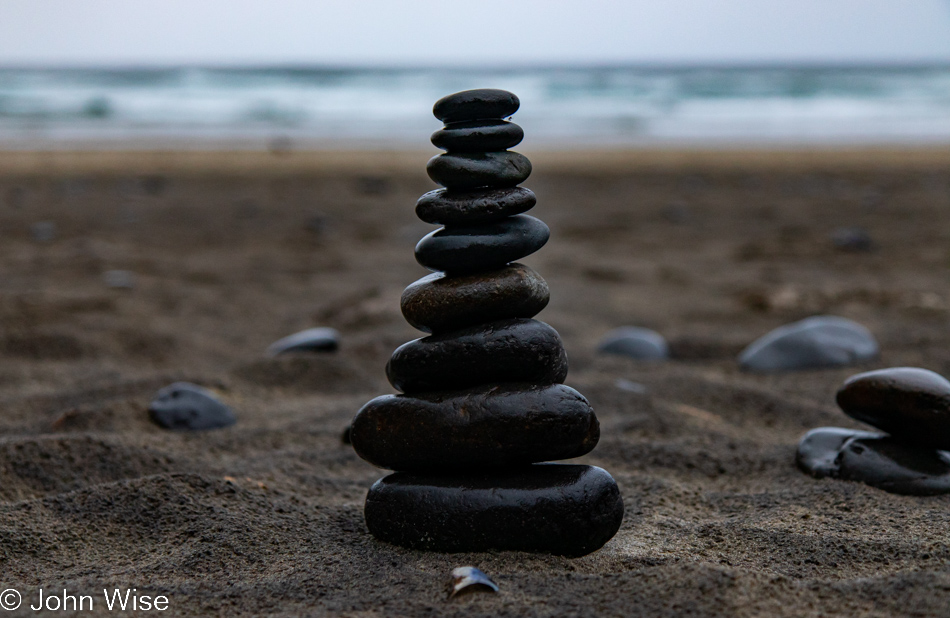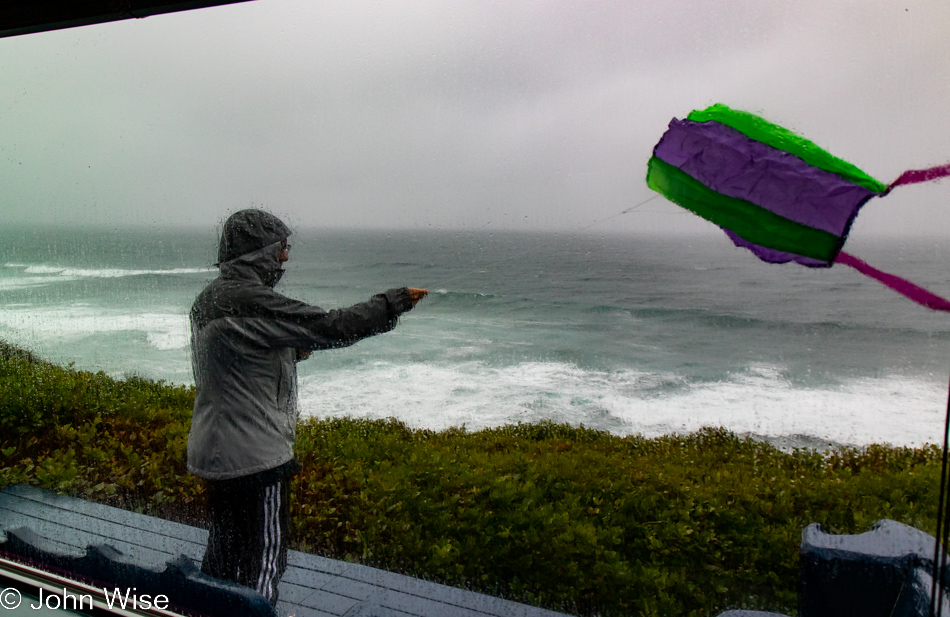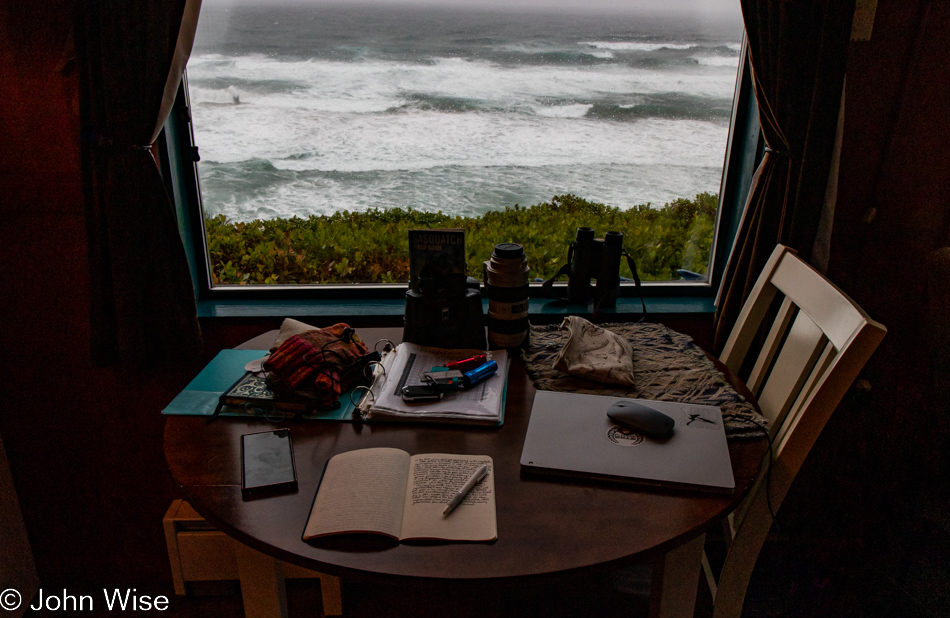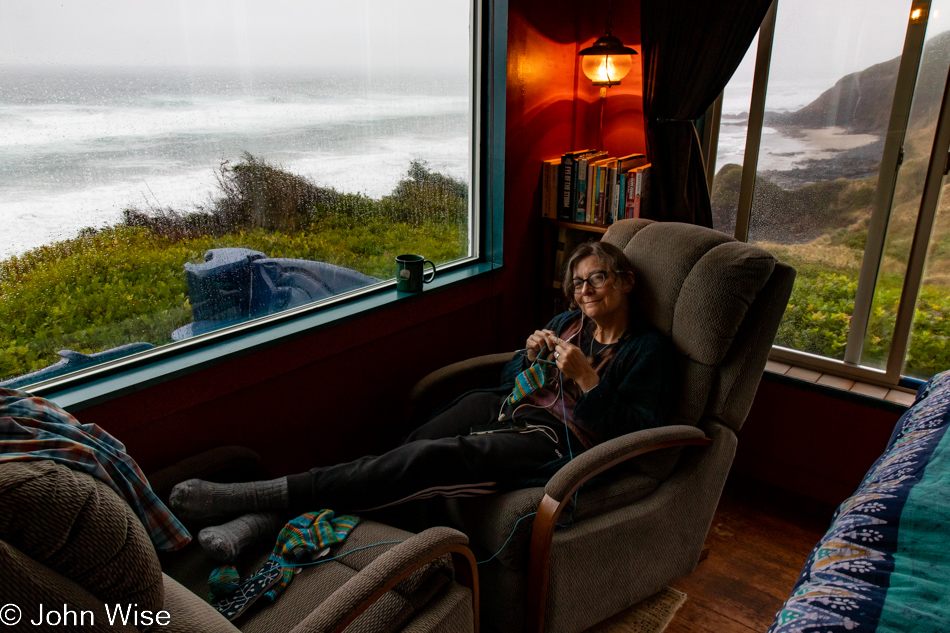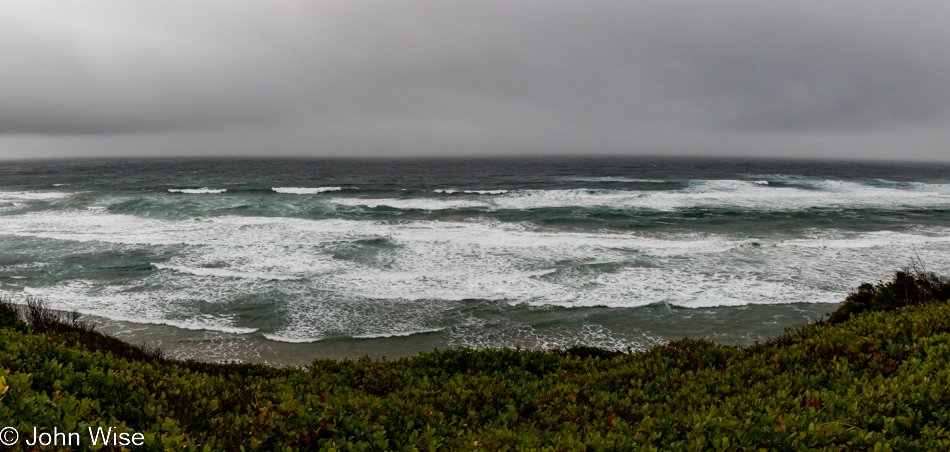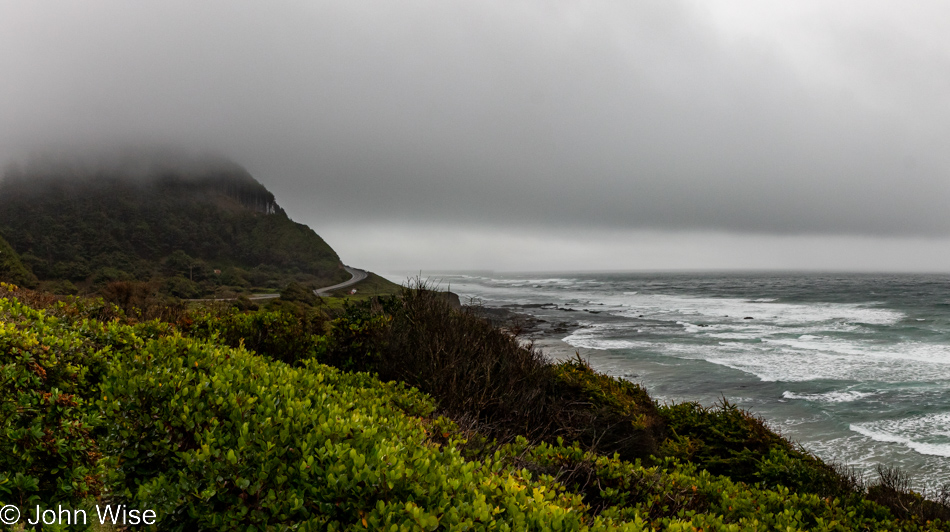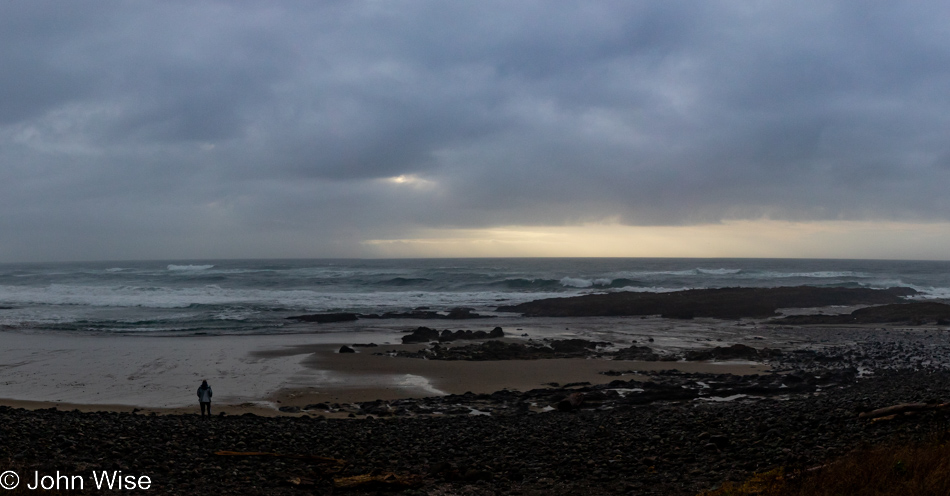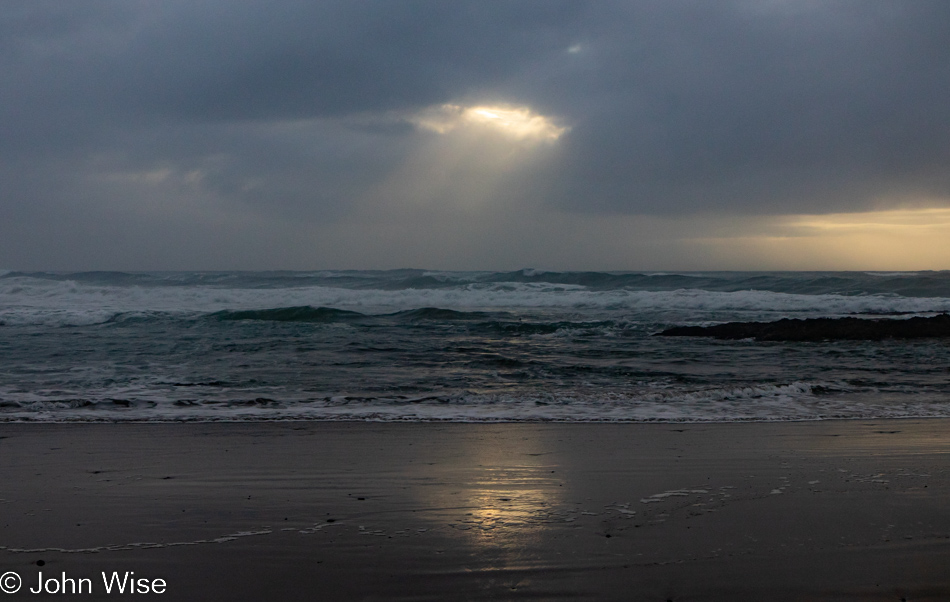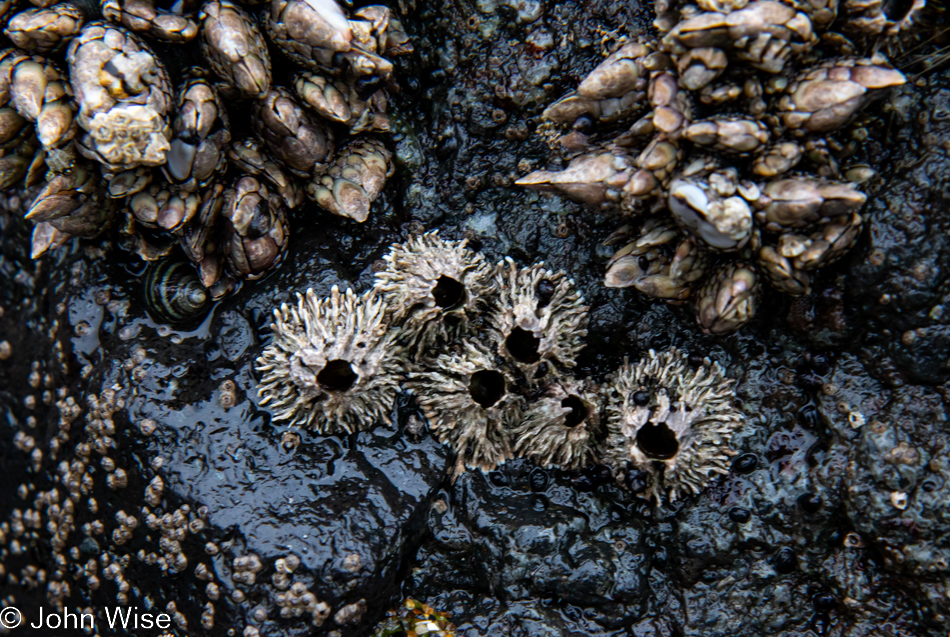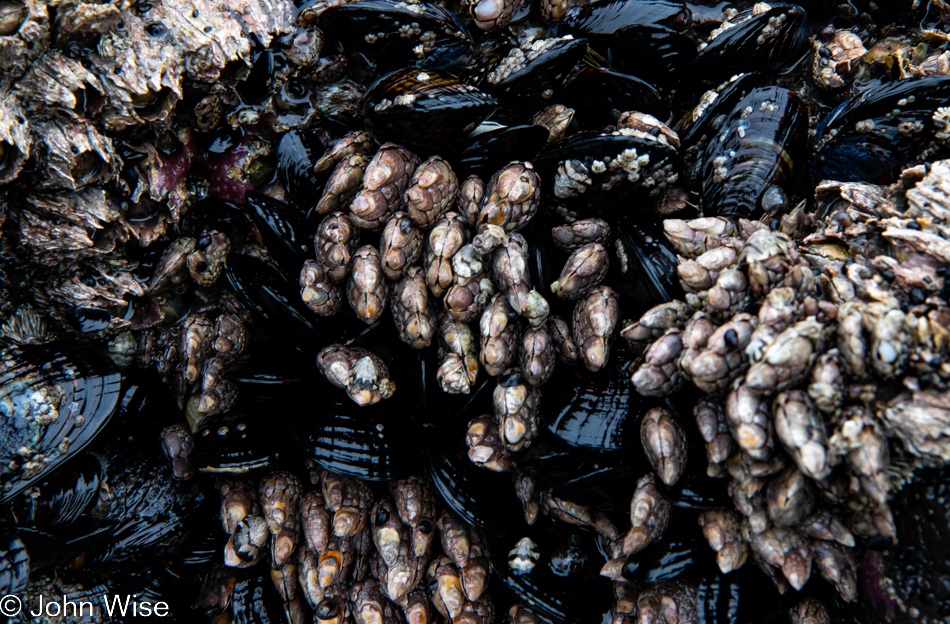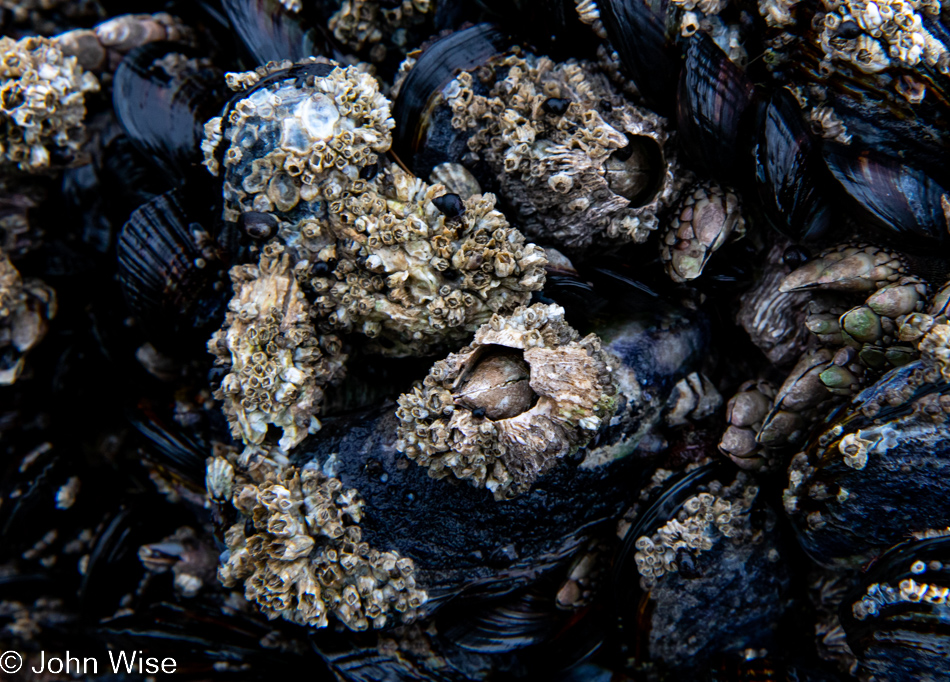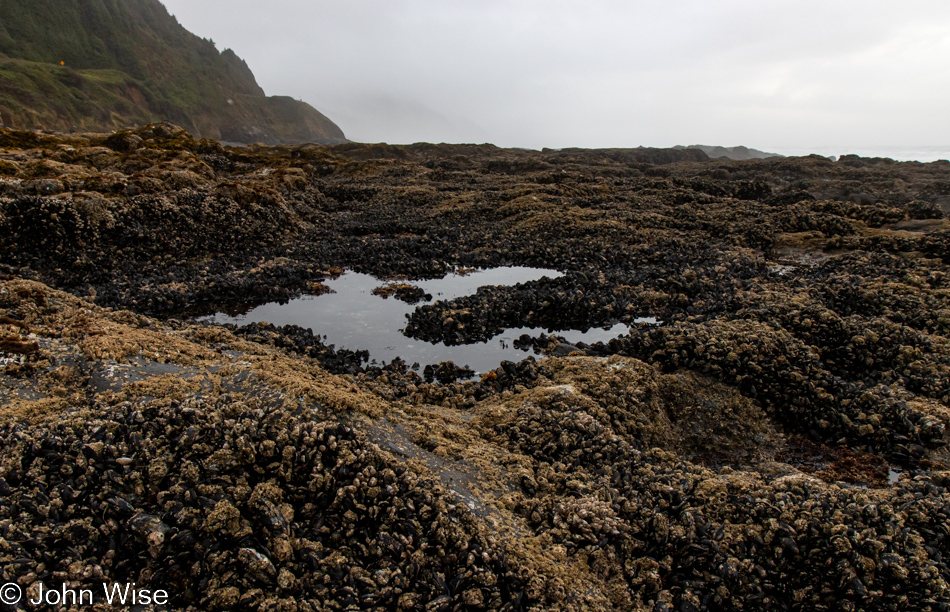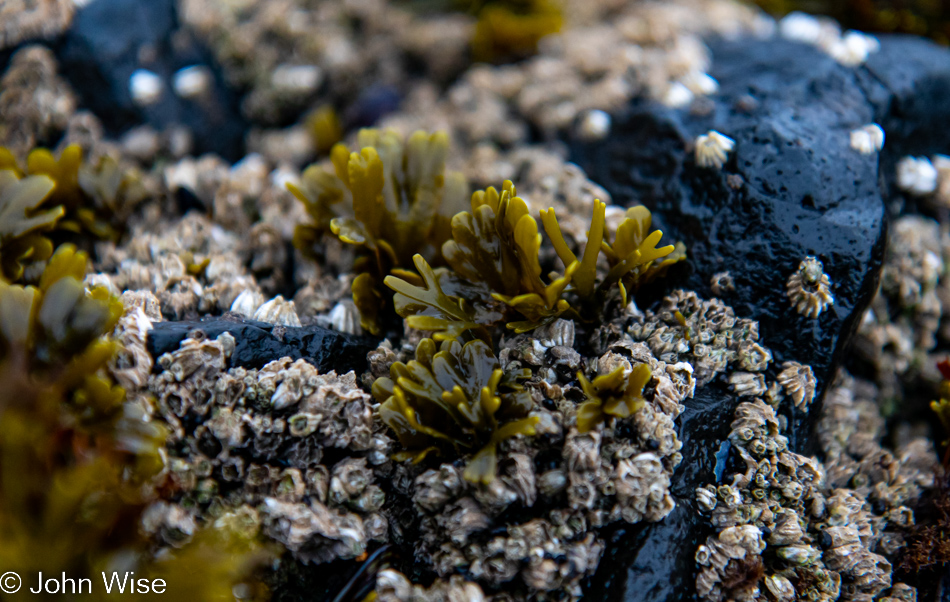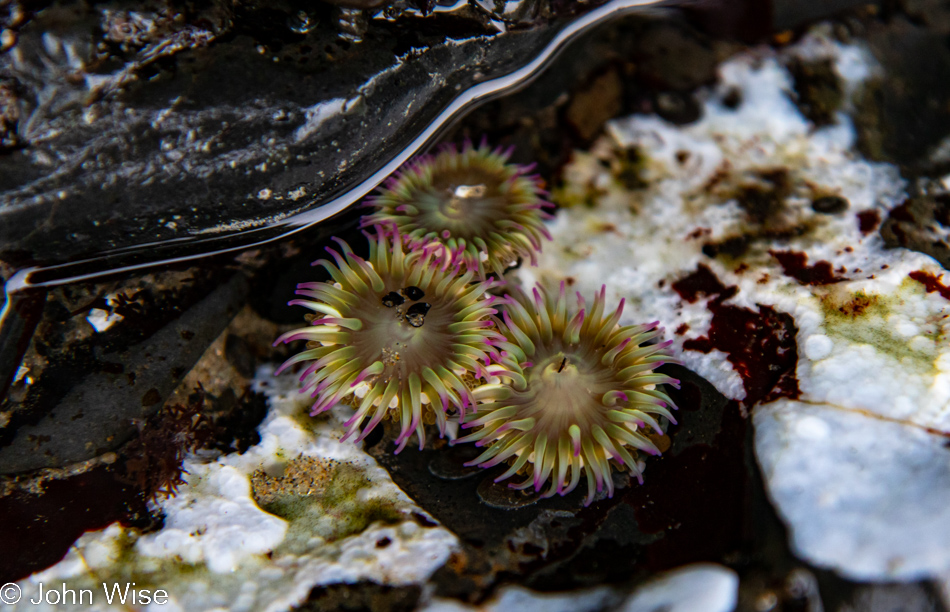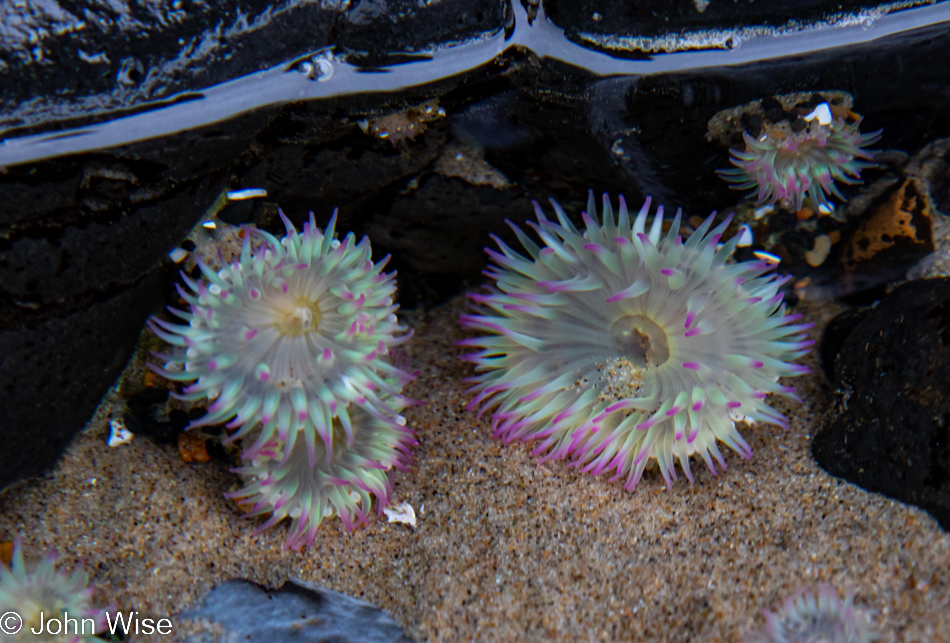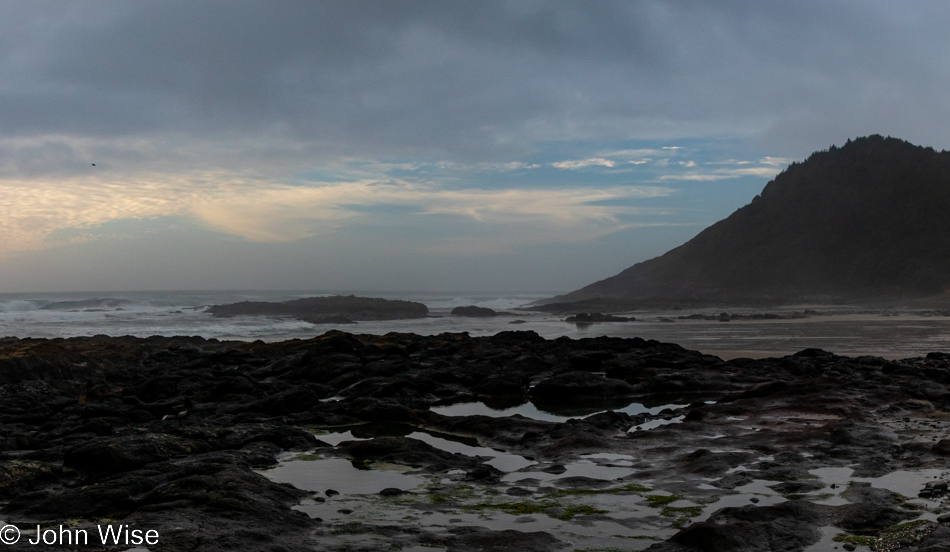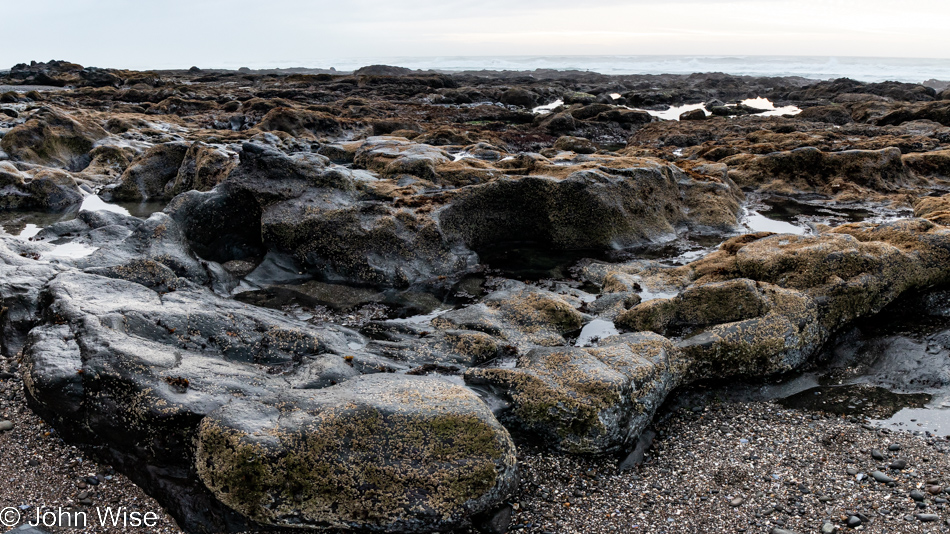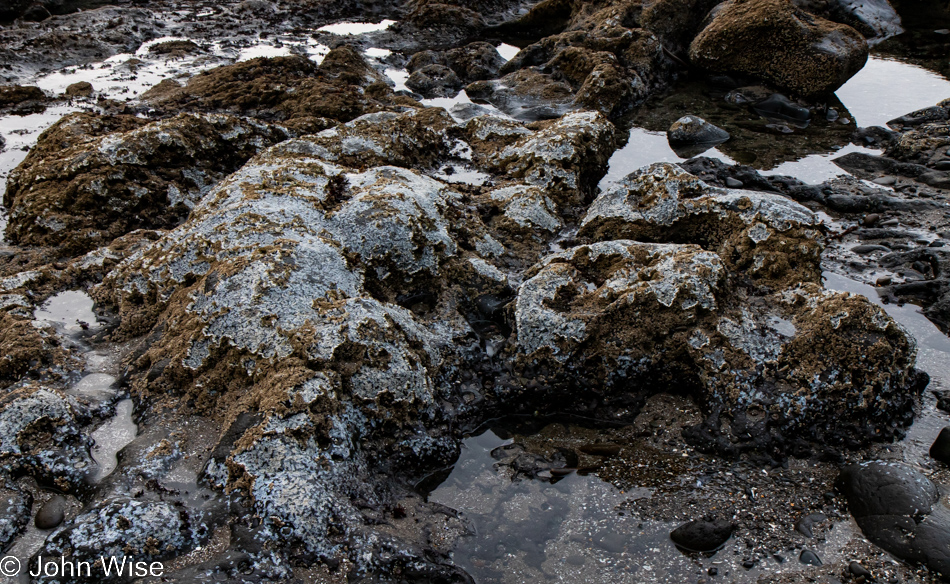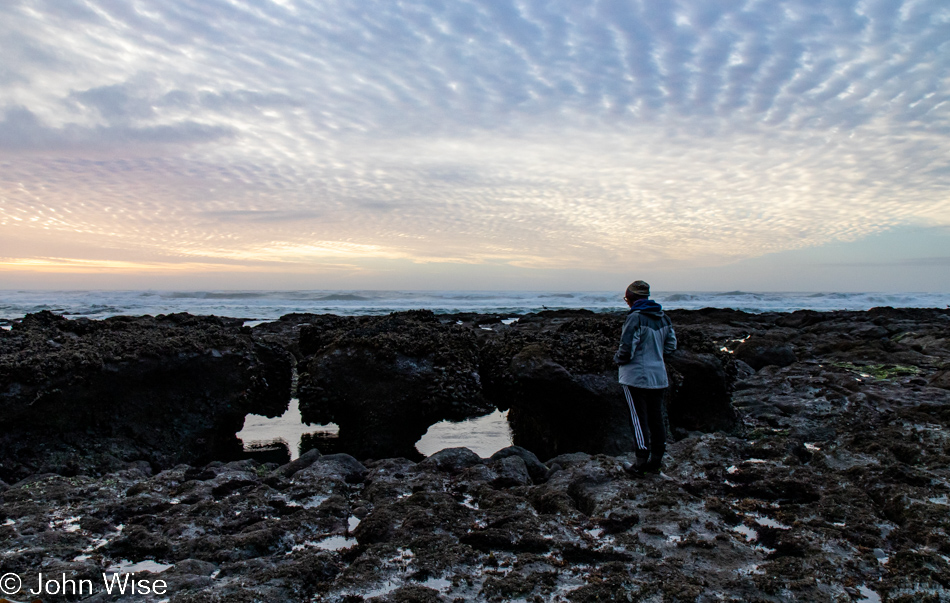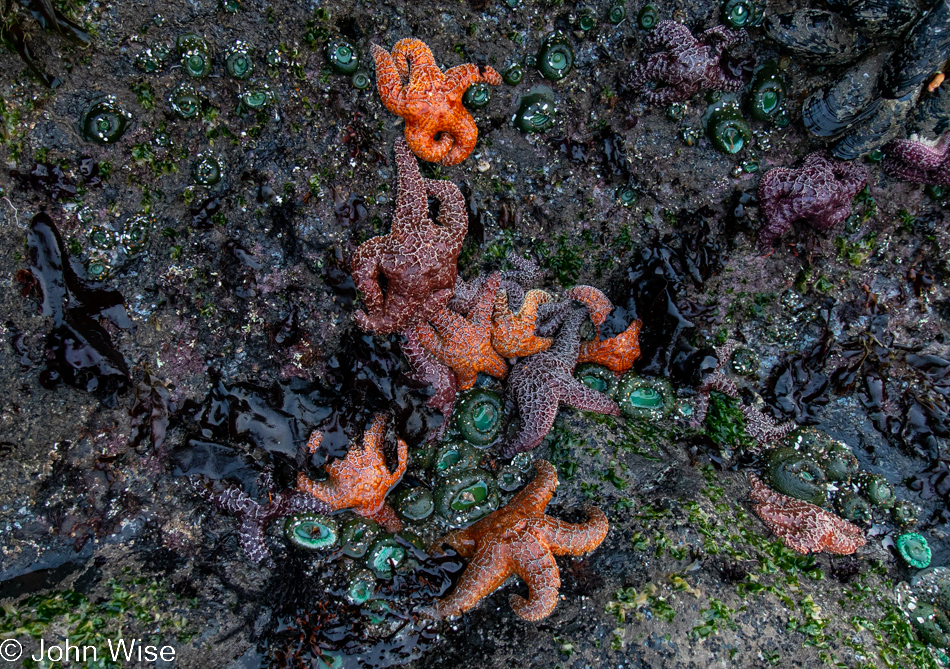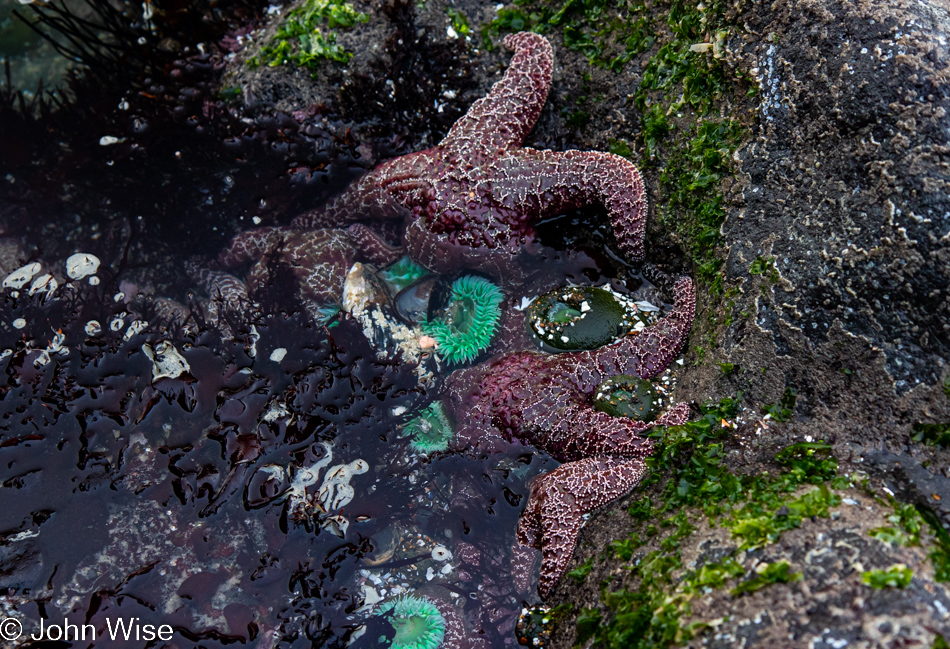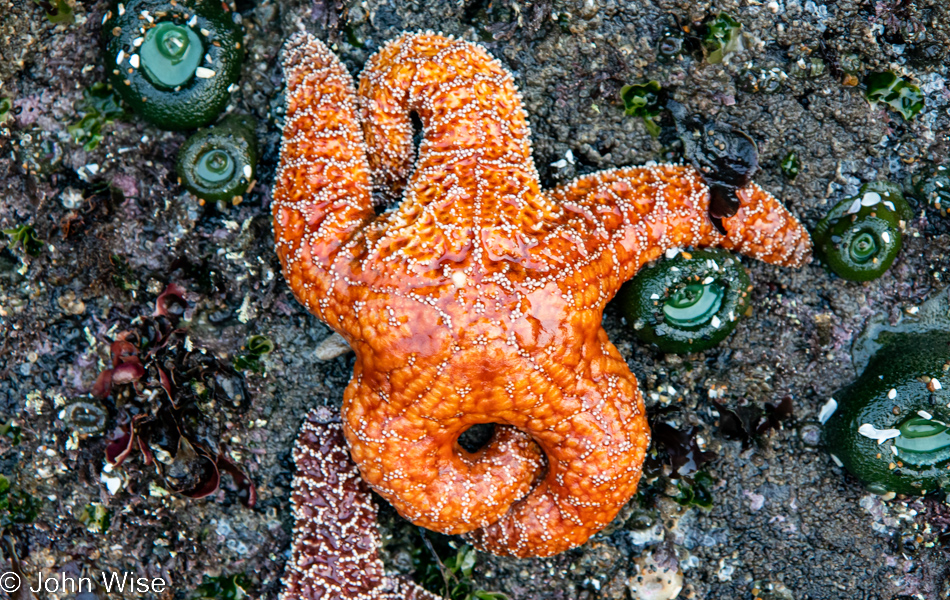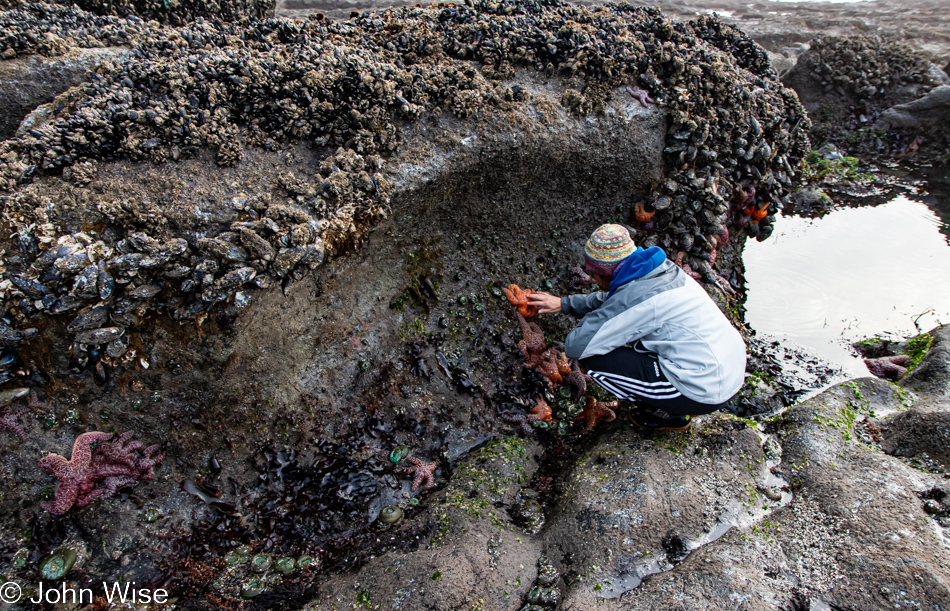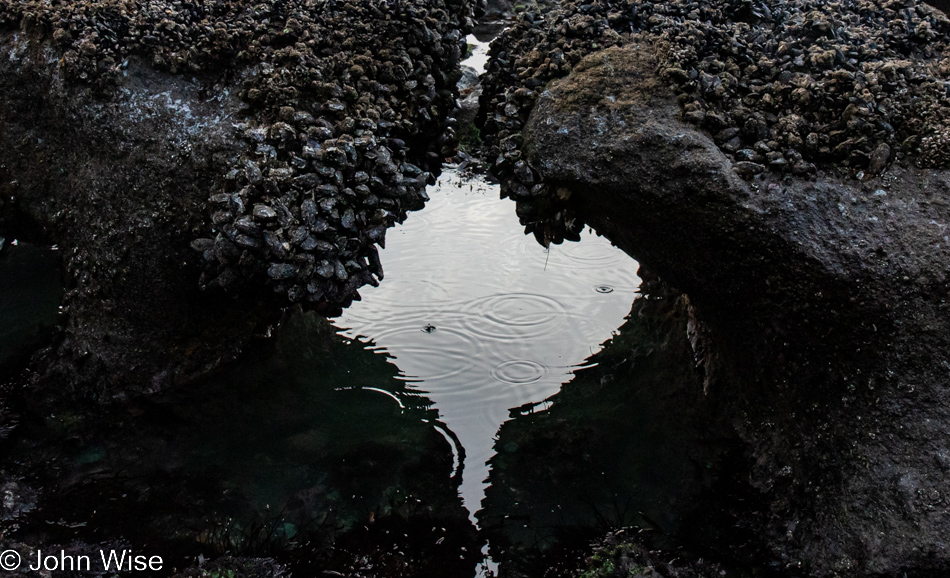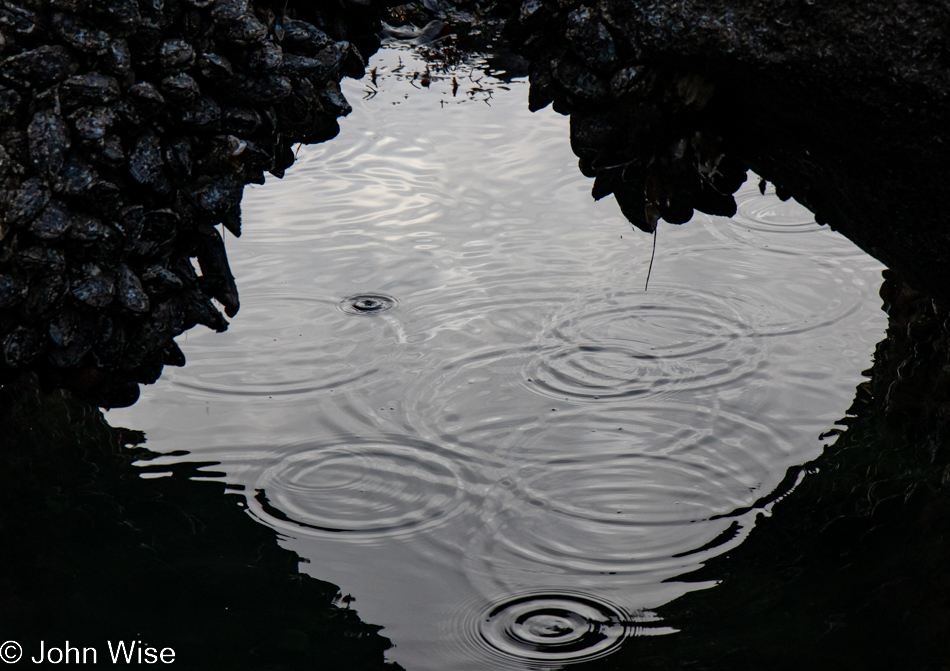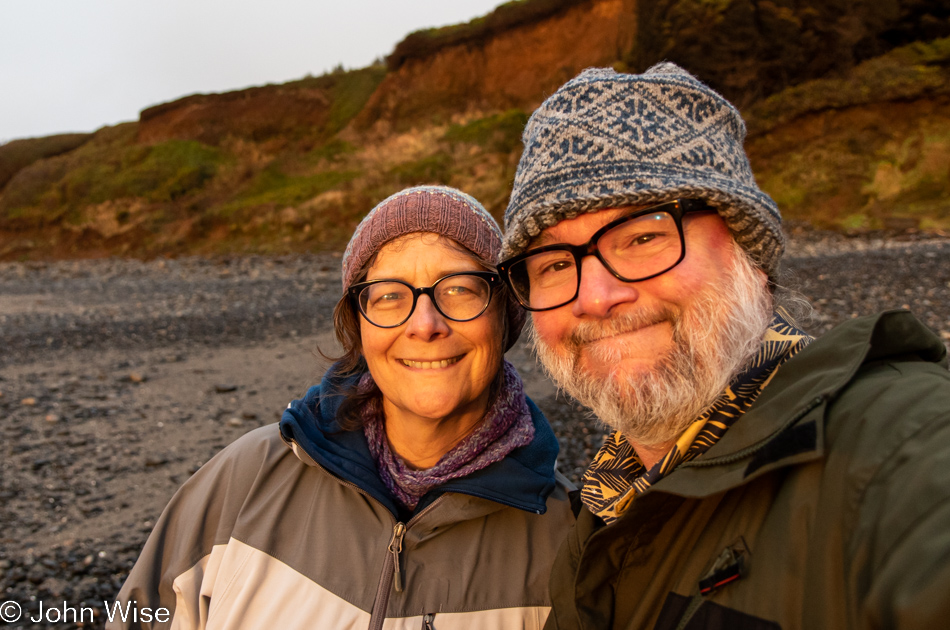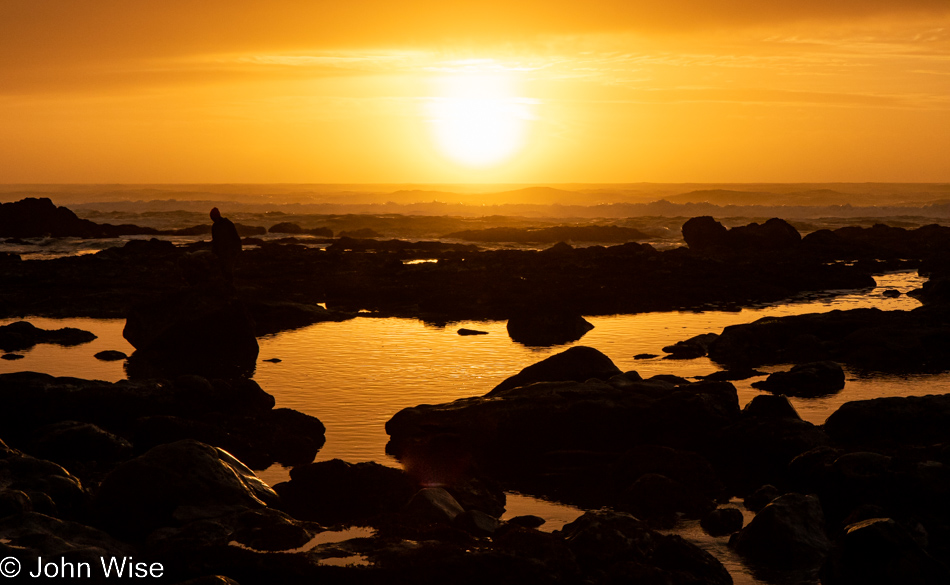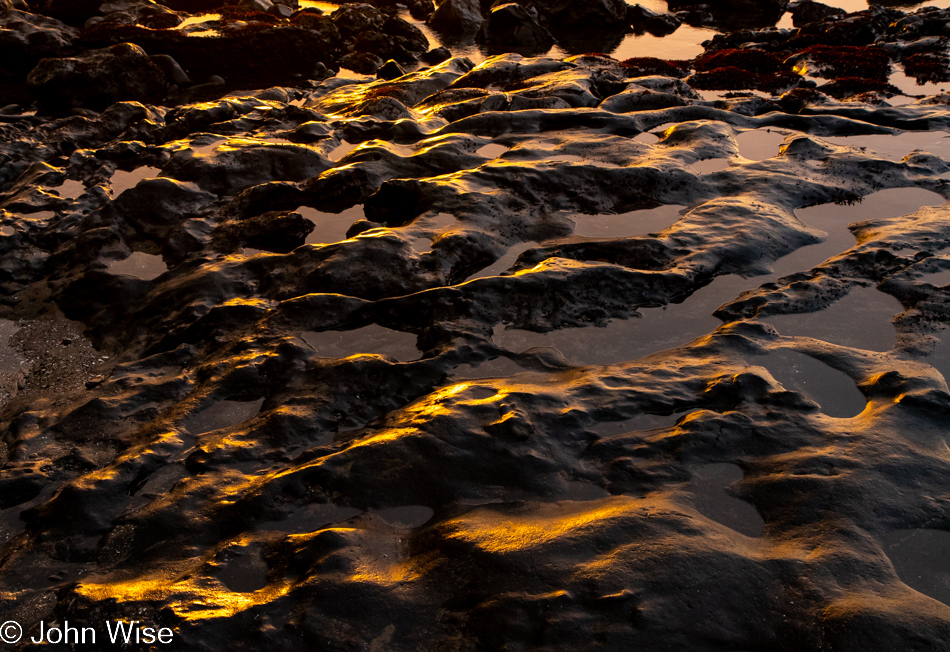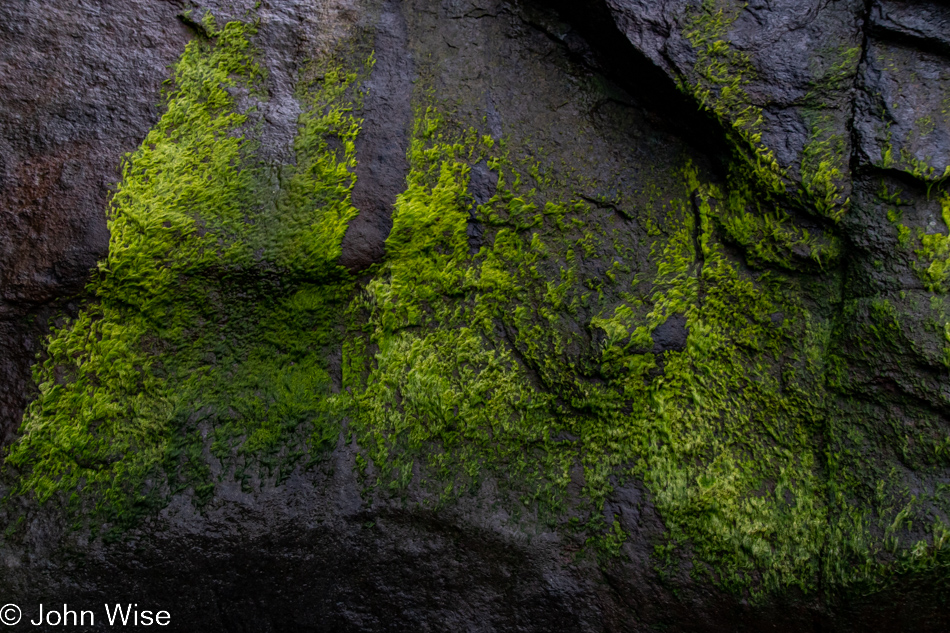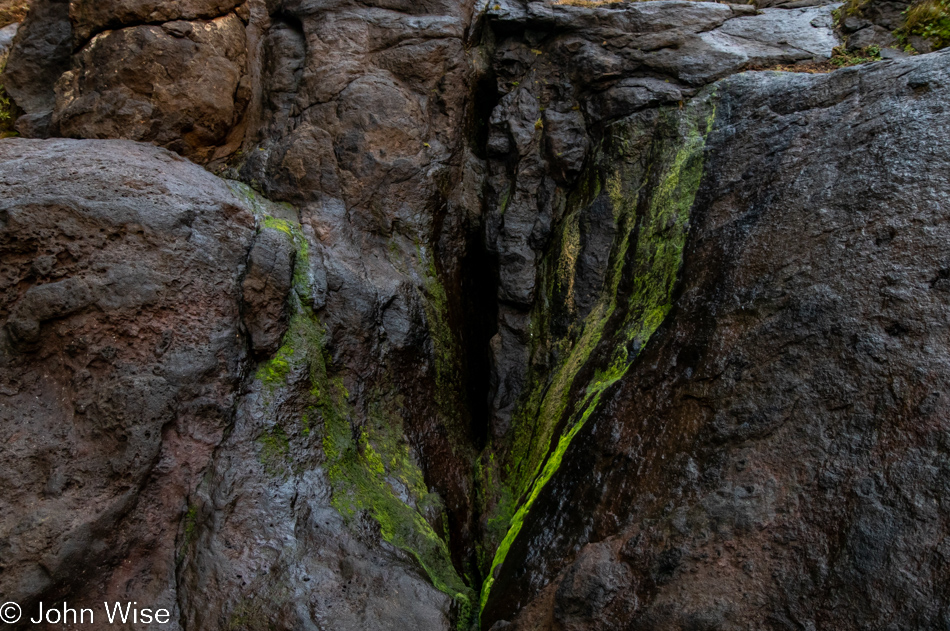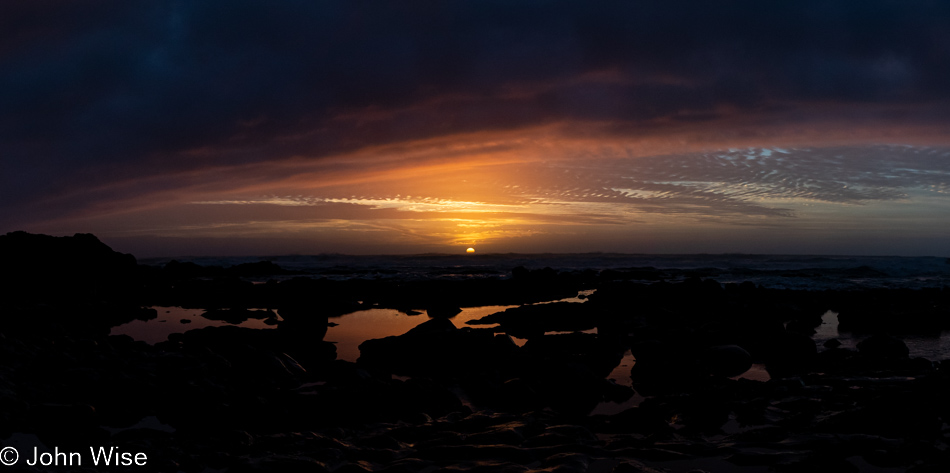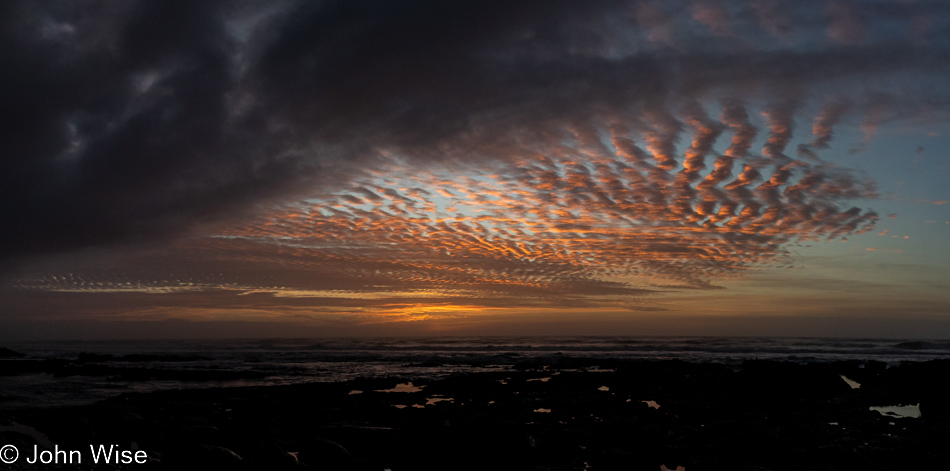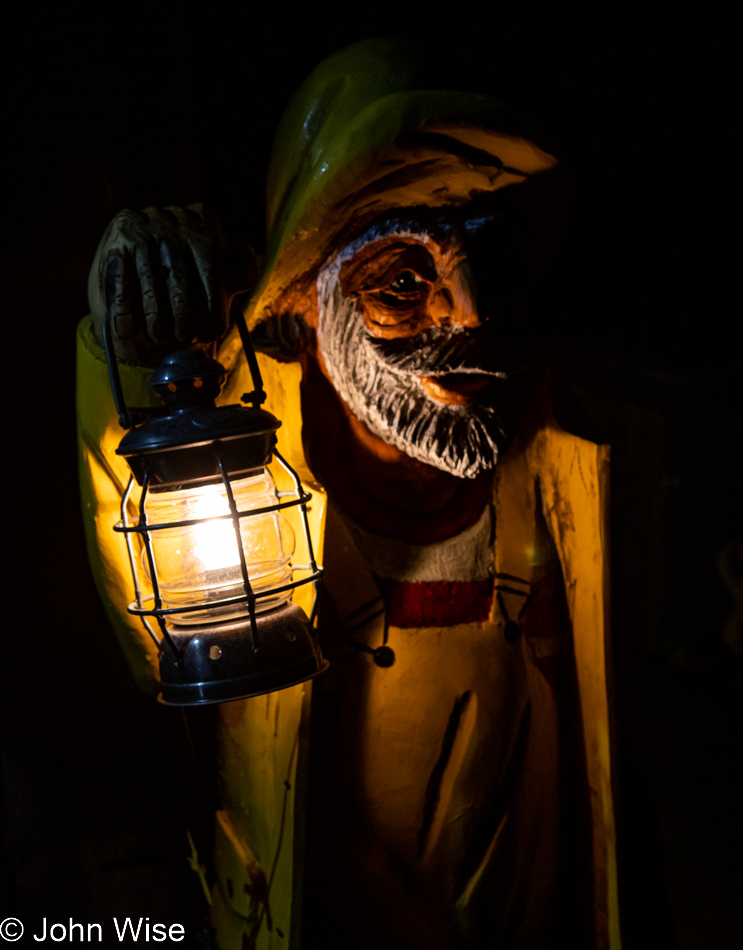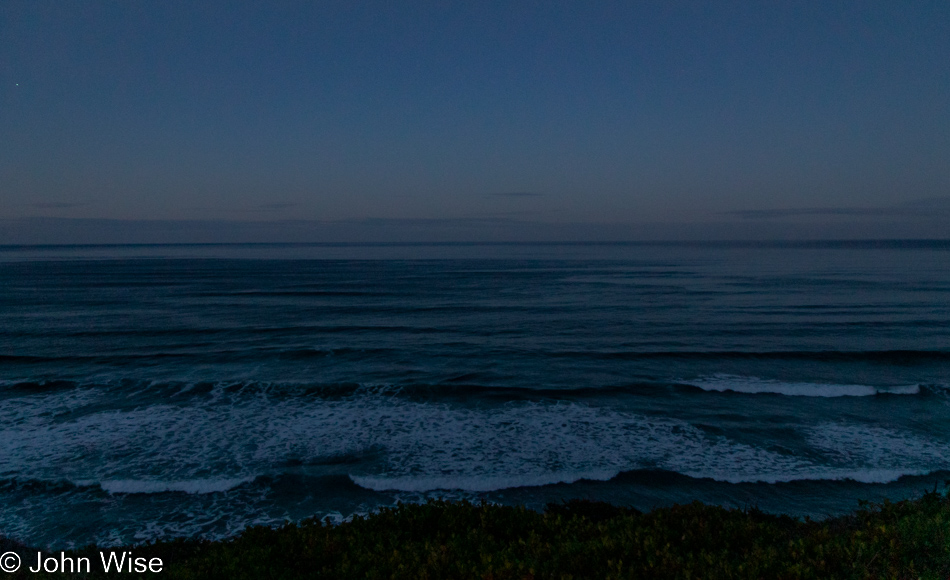
It’s still a murky gray out over the Pacific at 6:30 as I strain to see if our cliffside is still standing high over the ocean. The fishing boat I’d seen on the far horizon to the north a half-hour before deciding to leave bed is now gone, replaced for attention by an invisible barking seal somewhere below us.
Five to eight waves are lining up as they take aim for the land, while in the distance, a silvery blue belt looks calm. Between it and us, there’s a dark patch that offers an ambiguity I can’t read. A shadowy ocean at least appears mysterious, while a perfectly black sea at night is downright terrifying, though it is fascinating to see the reflection of stars on its surface.
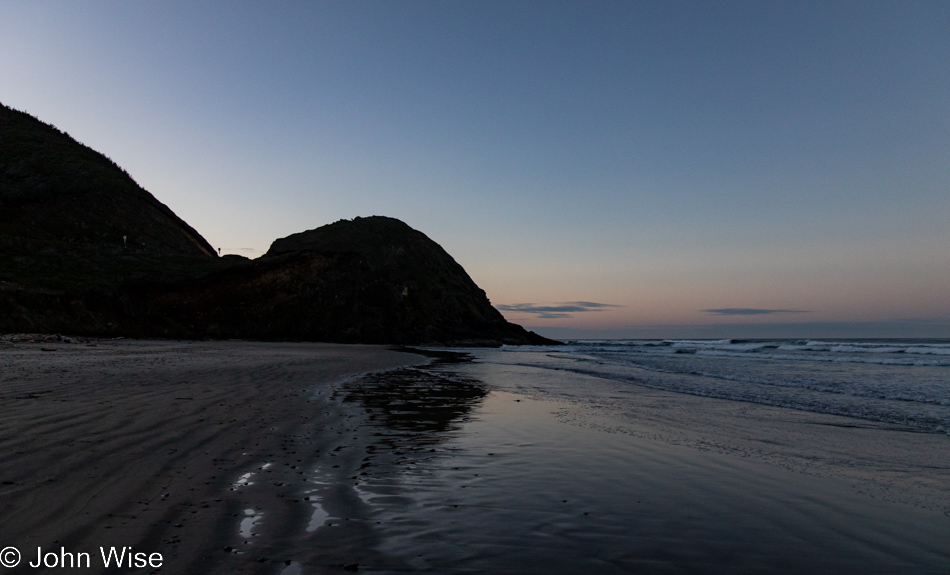
Sunrise is still 15 minutes away, just enough time for us to have made it to Tokatee Klootchman a quarter mile south of us, hoping for an easier trail down than the steep descent in front of our cabin, but in the shadowy light before dawn, it looks too precarious, and so we head further south to the uninspiredly (but maybe appropriately) named Ocean Beach.
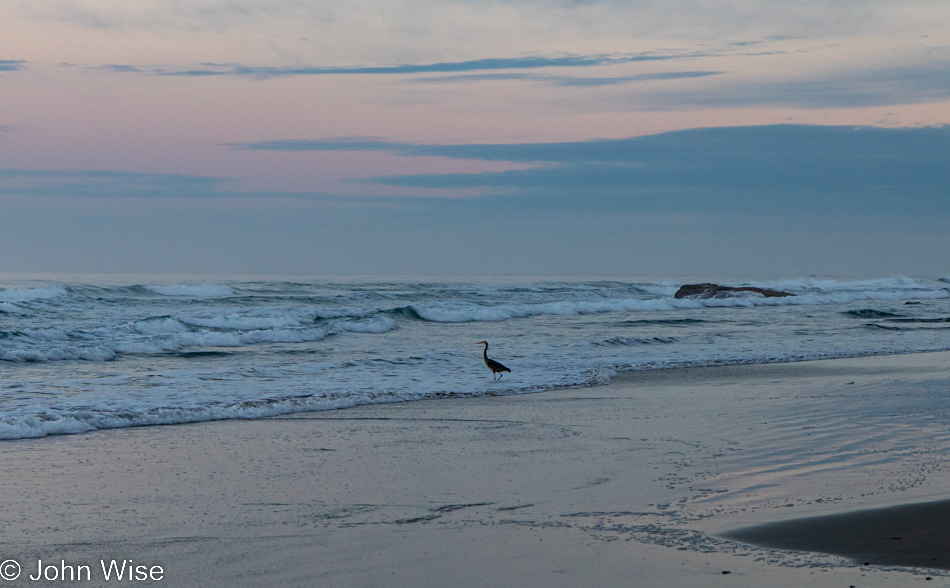
I won’t consider this egret to be looking for breakfast because I want to see it searching for the same thing we are, a glimpse of the approaching morning and arrival of sunrise. Like us, it just stands there listening and watching, its head doesn’t dip towards the foamy water swirling around its legs as if it were looking for morsels; it observes. Maybe it enjoys the music of the sea as we do and wants nothing more than a quiet meditation in the surf before the formalities of the day summon it back to its routine.
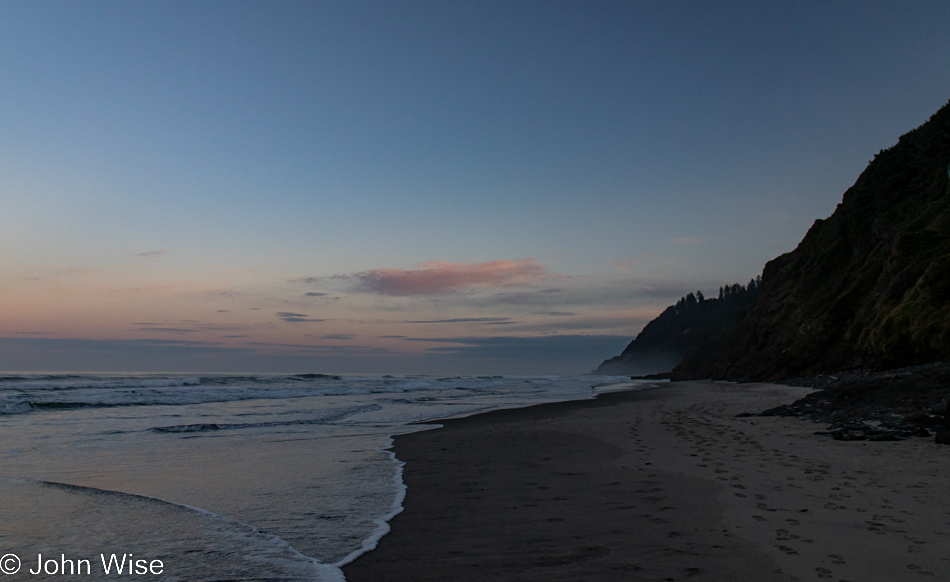
Time passes slowly, and morning comes in as we let it. The choice is there; we could have just as easily opted to remain in our perch on the cliffside, but the waking world beckoned us so that we might be witnesses for others who’ve forgotten that these things happen with or without them present. Are we then emissaries for cold dark mornings found on distant shores where few care to venture other than us and birds?
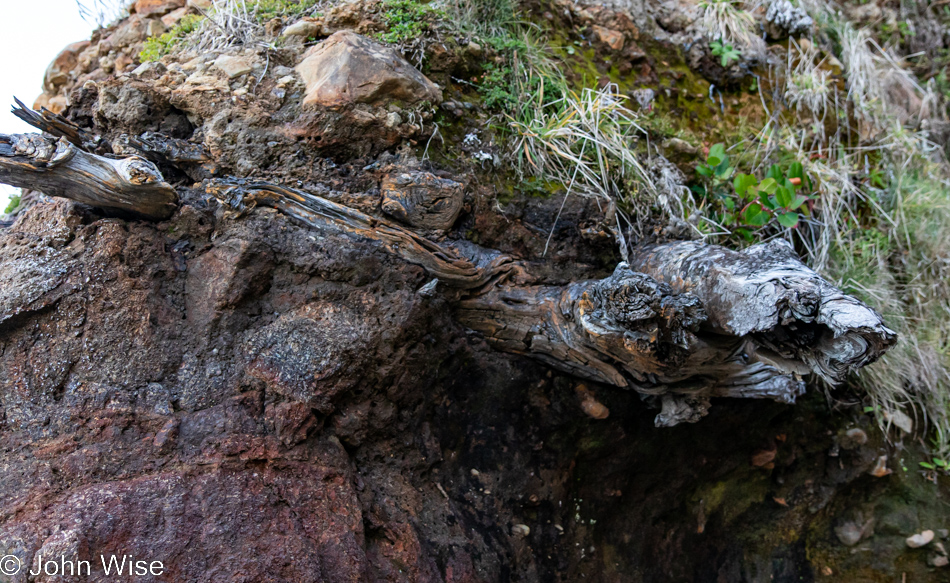
There are things that can stand out like a sore thumb once you’ve seen them, but until that time, they remain hidden in plain view. On how many other visits to the Oregon coast have we passed such sights and not recognized what we were looking at? At first glance, I understood I was looking at either a tree trunk or a large branch, but what I failed to comprehend was that this chunk of wood was emerging from between solid rock and a rough conglomerate above it. This can really only mean one thing: the tree was knocked down and carried along in what was likely a landslide. For centuries, it lay buried in an oxygen-poor sarcophagus and is now returning to light due to the effects of erosion. Was this from another episode of earthquake activity in the Cascadia Subduction Zone?
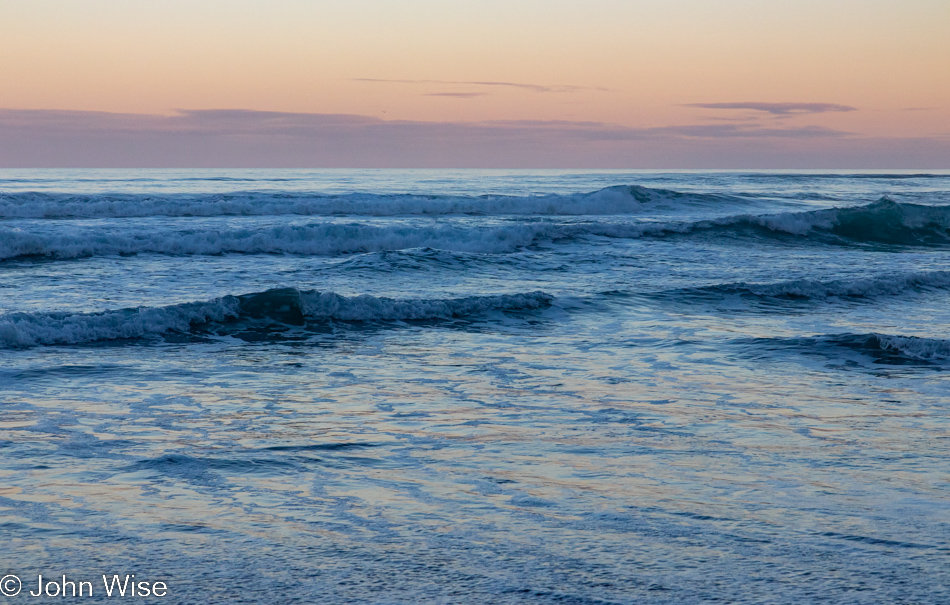
Bird and visitor alike look upon this scene, both interpreting a sight almost incomprehensible, aside from the possibility of both finding it appealing. While I stood before this tranquil image, astonished by the colors transitioning over surfaces, any sense of the magnitude and mechanics of nature were kept at bay by my shallow ability to see, hear, and think outside the grip of senses holding this fluid reality together as something to behold. It is only after bearing witness to such things that we start sorting what it was that challenged us to understand the appeal of what ultimately is infinite to our puny minds.
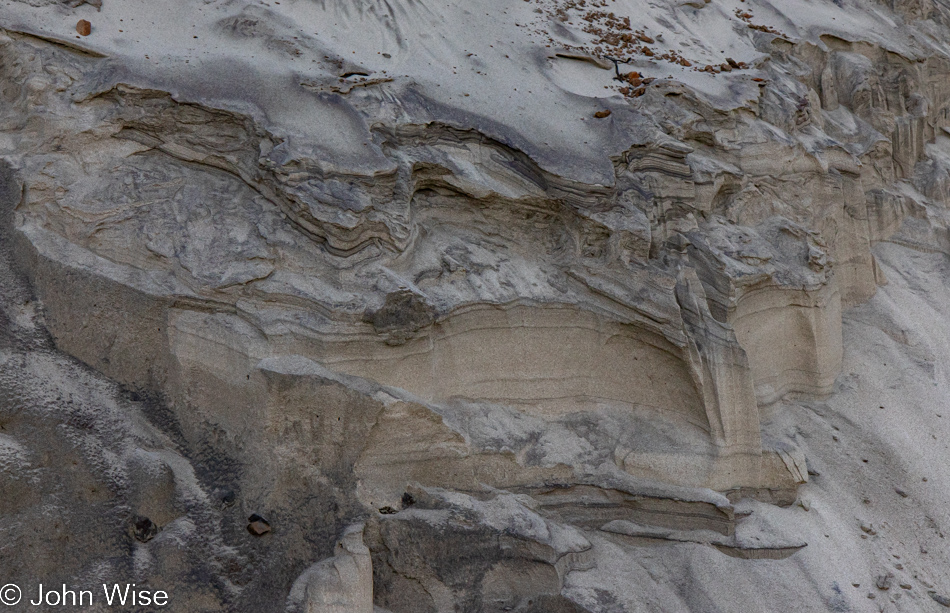
In each cubic foot of sand, there are approximately 1 billion grains of those fine particles. In another post, I mentioned the 86 billion neurons in your head; try this thought experiment at home: measure off a space of 4 feet long by 4 feet wide and 5 feet high. The cubic dimensions of that space carved out of your living room would be 80 cubic feet. Now fill it with sand, and you’d have close to 86 billion grains of sand in that cube or the number of neurons packed into your head. What patterns would you make out in the depths of your collection, not in the sand but in those cells that populate your brain? I’d wager most would find a symphony of junk culture streamed into their experience that reflects nothing about who they really are. At least the sand actually represents the mountains, rivers, rocks, sea shells, and other bits and bobs of where it all came from across time.
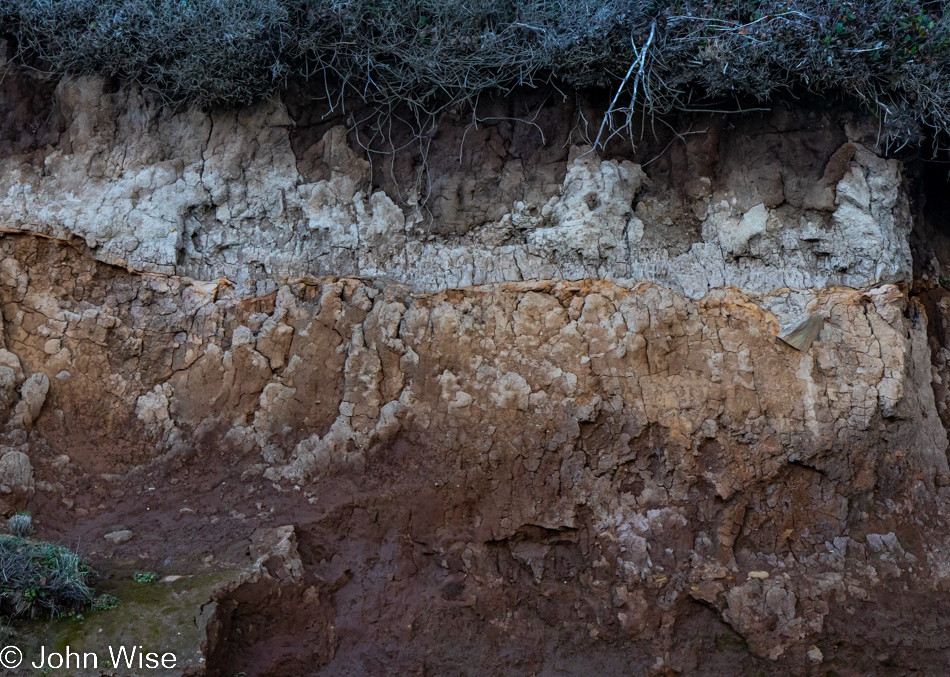
Accretions, the Oxford dictionary describes them as such; the process of growth or increase, typically by the gradual accumulation of additional layers or matter. Our foundation, if we are lucky, is built upon love and care. For the less fortunate, they might be a hodgepodge of neglect, violence, and hunger. Even for those with good beginnings, it is not uncommon for the wheels to come off the cart of emotional security as anger, bullying, betrayal, and lies start to accumulate upon good intentions. Now layer in the superficial nature of a consumer society that convinces one and all that one becomes complete through consumption. So you pile on the designer clothes and celebrity-sponsored shoes, you buy the car and home just slightly above your pay grade, you diligently watch the series and seasons of dramas and sports so you own the right language to be popular among your peers, or maybe you become sidetracked by conspiracy, religious fanaticism, hate, and intolerance. For a while, the layers accumulate of hard pretense or of spongy swamp-like mud as you are drawn into someone else’s scheme, their alternative reality.
You never realized that the deeper foundation was no longer able to support a healthy outlook from the toxic topsoil poisoning the surface of who you thought you were. The flowers and happiness that you thought you were cultivating turned out to be sour bitterness that obscures your vision and leaves you feeling that you must plow under everyone else who fails to see the world as you do. Once I learned some 40 years ago that the computer phrase GIGO (garbage in, garbage out) had real-world consequences for not only data but for humans too, I began trying to shift what the accretions of John might look like.
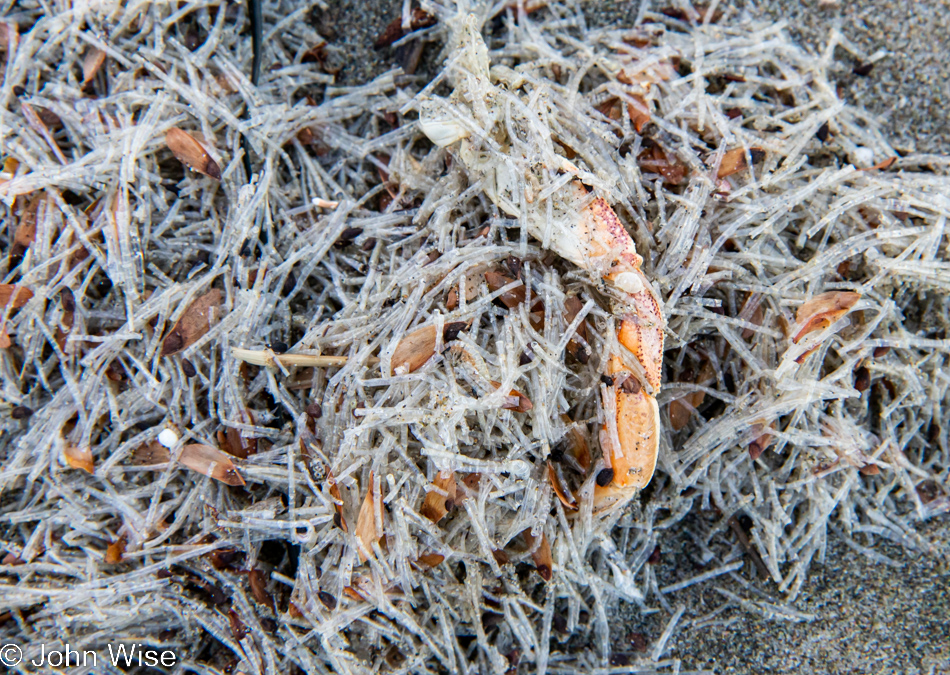
It was not easy to determine what these things are or what created them, but I finally learned that they are cellophane tube worm casings. Neither of us remembers ever seeing them before, and maybe for good reason: they typically live in the sand near the low tide line. My understanding was that negative tides weren’t due until Thanksgiving, but (and we’ll see more later in the day) maybe they arrived early. As for the molted shells of crabs, those seem to be unseasonably out of character, with females molting in spring and males during the summer, so why here, near the end of fall, did all these crab casings wash up along millions of worm filaments?
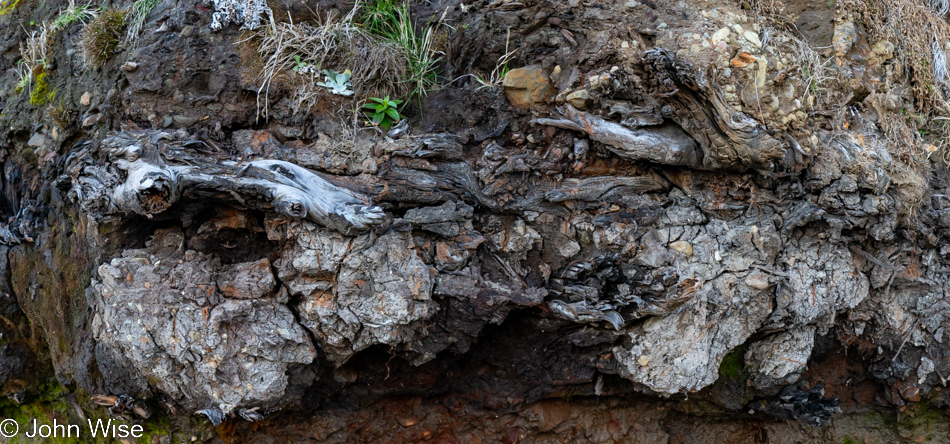
Maybe this is a tiny part of the earth’s brain. It holds the knowledge that what might appear permanent is potentially volatile and can reconfigure itself in the blink of an eye. With humans, on the other hand, the process of change can be glacially slow to the point of imperceptible. One big storm could hit this shore, and a wave could consume the evidence of this landslide, dragging all that is seen here into the sea. Those who never saw it with their own eyes will not understand the truth of what things looked like before their own arrival. In this sense, wave after wave of knowledge can crash into us humans, and yet we remain impervious to change and unable to understand the vast landscape before our arrival.
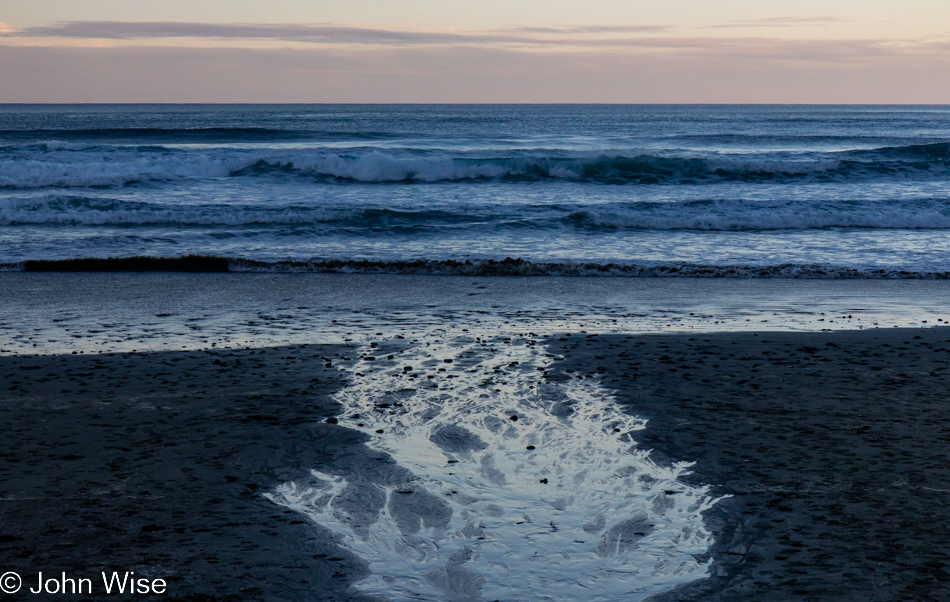
Water runs back into the sea, humans too often run into self-constructed walls made of their own short-sightedness.

Big Creek Bridge is as far south as we get before turning around, now satisfied we’ve felt the warming rays of the sun and functioning imaginations.
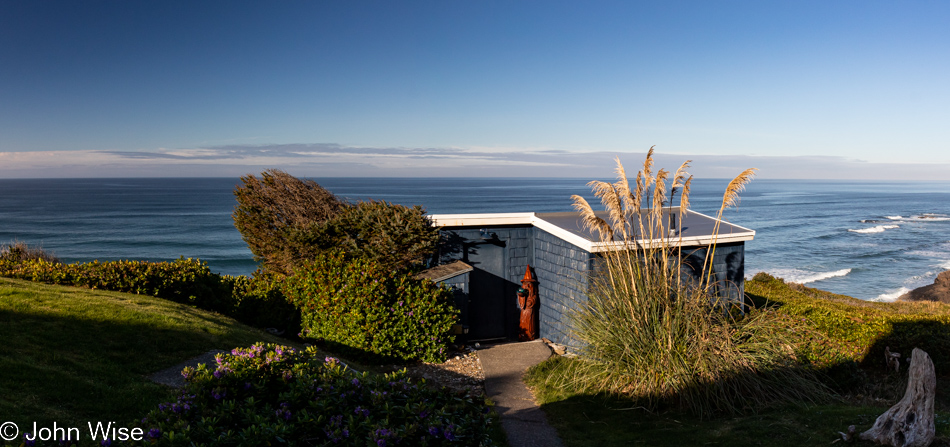
Back to the Nest for breakfast of unintended scrambled eggs, potatoes, and bacon. We ended up needing to render the bacon fat so we’d have some oil to cook the hashbrowns we’d picked up at the market in Yachats last night after dinner, but as soon as those potatoes hit the grease, it disappeared, leaving nothing for the eggs. With some quick thinking, I chopped the bacon and scrambled the eggs so I could toss it all together and hope for the best. The coffee percolated, and before we knew it, we were serving up a perfect breakfast, at least the part that wasn’t holding past to the frying pan that I’d be scrubbing for days. At least we didn’t have to go to town, and we had the best view ever.
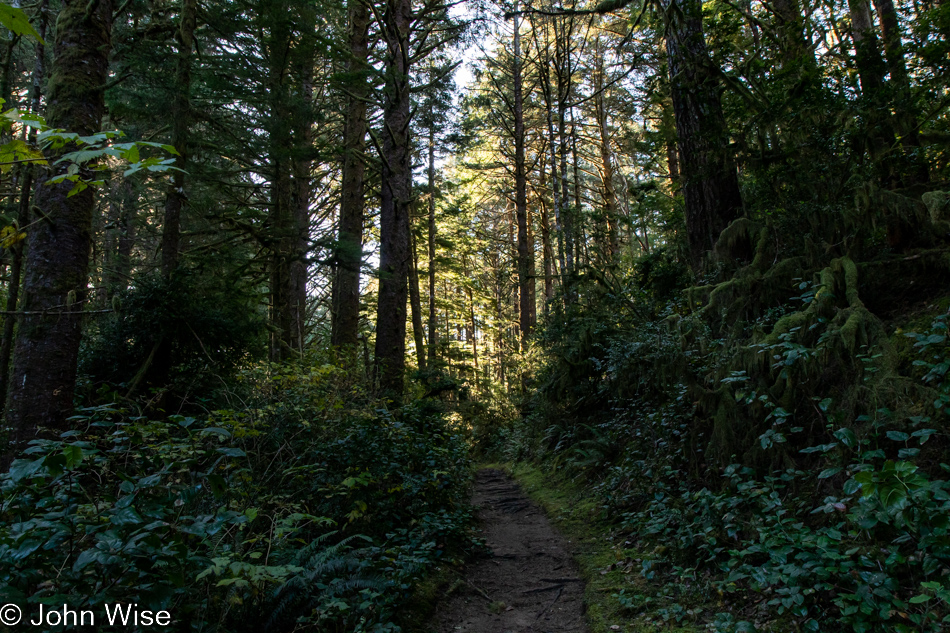
Incredibly, the weather is looking quite favorable this morning, so we’ve decided to gamble that it will hold long enough to take a walk down at Carl G. Washburne State Park and the old familiar China Creek Loop Trail. The sound of the surf across the way is everpresent while the trickle of China Creek lets us know it’s just below us in the ravine. The faint sounds of birds are near, but almost always they remain unseen. That held true while we were still on the Valley Trail but as we reached the small bridge where the loop trail turns off, there were a bunch of chickadees fluttering about. There will be no crossing the obviously broken crossing as the damage is too severe, plus the park service has blocked the passage with a notice posted that the trail is closed. But this is a loop trail, so we made it a bit further on over the Valley Trail and while the China Creek Loop was taped off, that was easy enough to bypass.
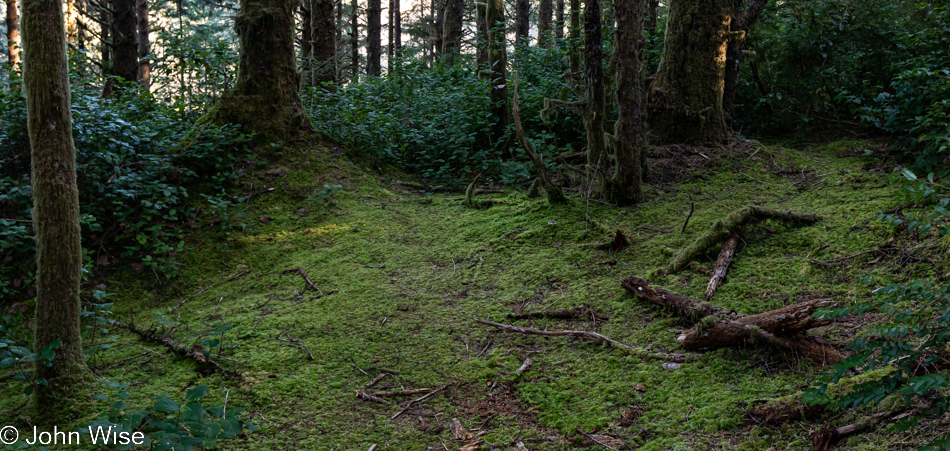
There’s a different kind of tranquility out here, knowing we are alone. On other occasions, people walking through can be loud, boisterous, and simply rude in our estimation. In the exceptional quiet we’re experiencing, we can hear more birds, smell more forest, and see more plants.
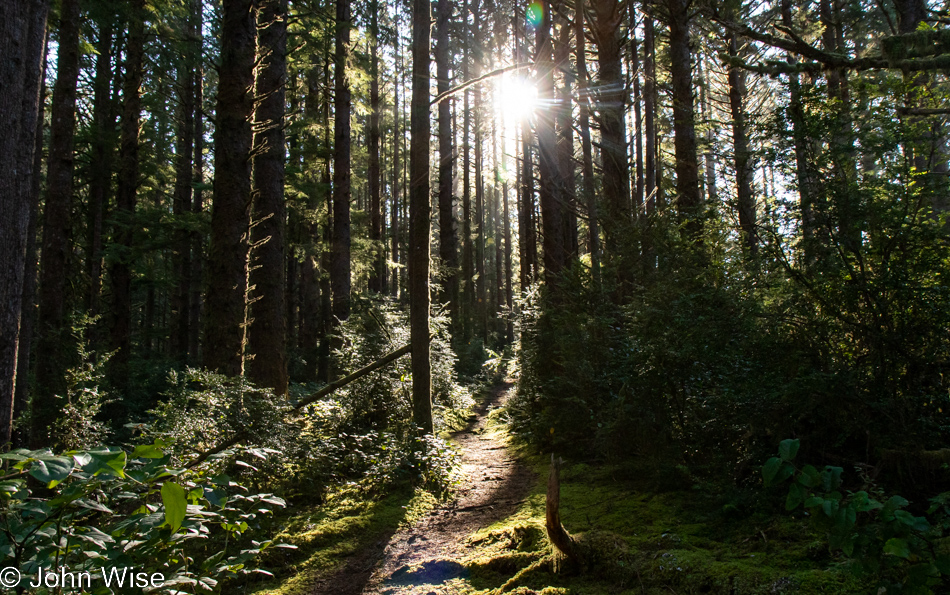
Similar to looking at a familiar place through a rearview mirror and seeing it differently, walking the loop trail in reverse changes our perspective. And then there’s the recognition that we’ll be taking all of this in twice since we must return from whence we came.
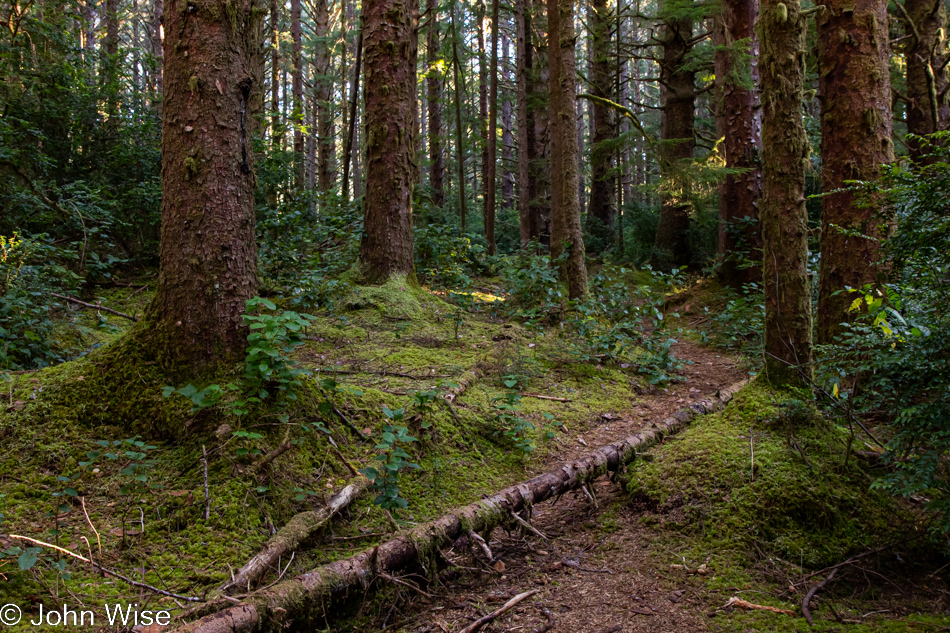
Trail upkeep has taken a hit because why clean the trail when it’s closed? It’s fascinating how quickly the forest encroaches upon the trail, starting to erase our presence.
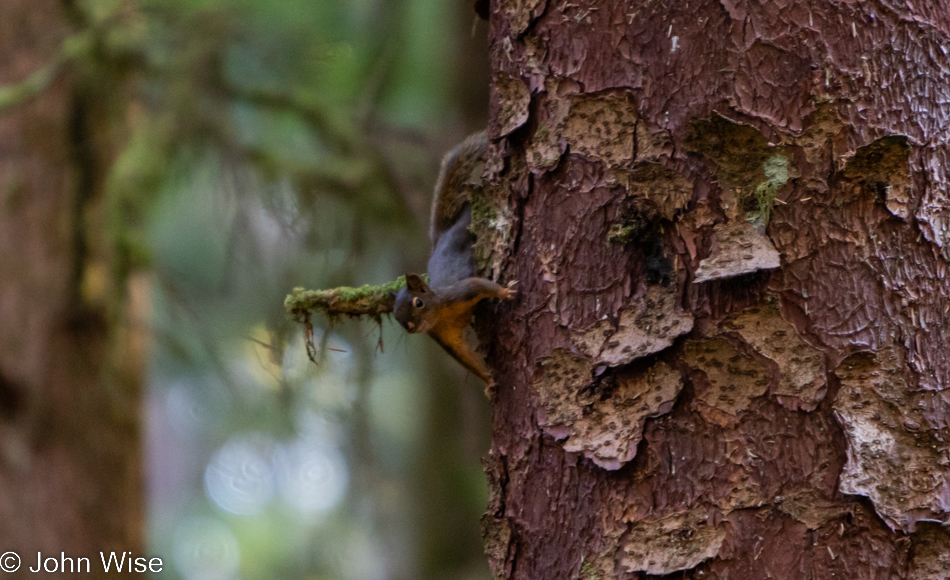
This was the first squirrel we spotted today, but it wouldn’t be the only one. Before one sees the squirrel in the rainforest, one hears the squirrel. Hearing the squirrel, though, is only one tiny part of the enjoyment as its tail appeared to be part of the apparatus that helped it offer a louder chirp because, with each new chirp, that tail behind it was hard at work pumping back and forth in time with its commanding voice.
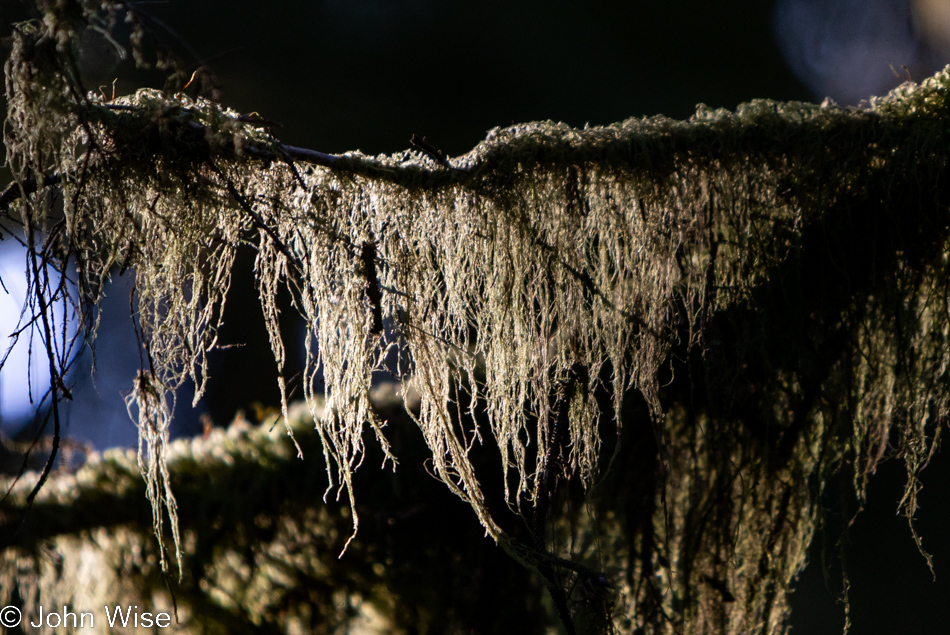
Have I ever known that this is beard lichen? Maybe I thought it was moss, but whatever it is, I do know that it adds to the lushness of the environment and helps exemplify the still atmosphere that glows in the radiant light of day wherever the sun spills into the forest.
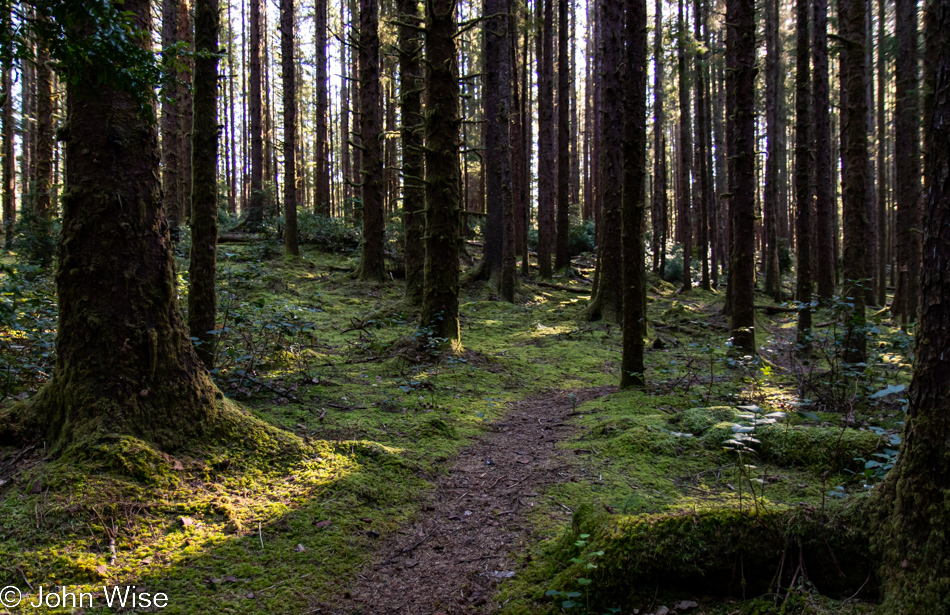
We walk with soft steps, not wanting to disturb the majestic awe that inhabits this place. Everything feels delicate requiring that we travel without disturbing the forest that only shows its true tenderness when we arrive with the kind of respect that desires to be here in a symbiotic coexistence.
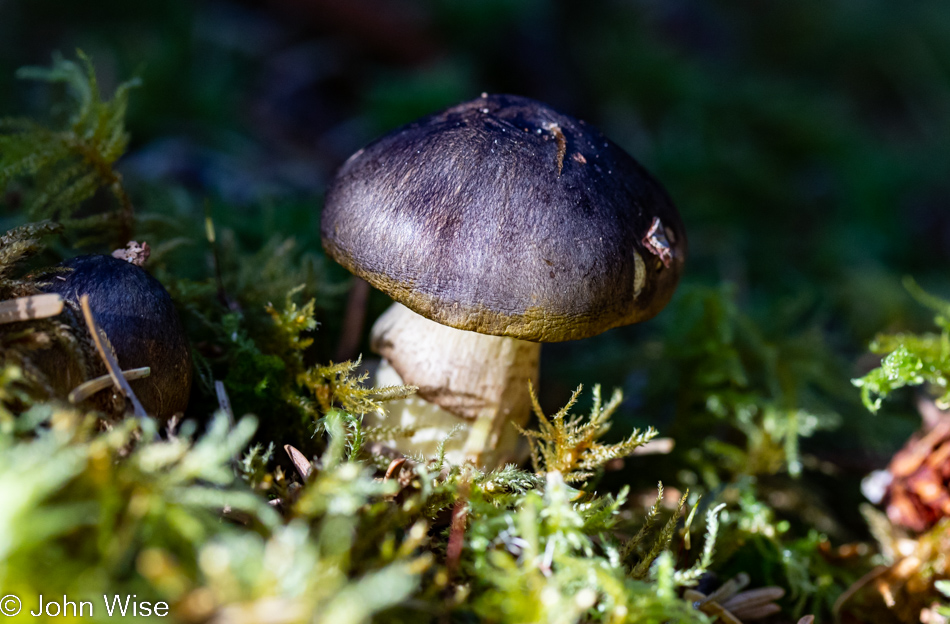
While I was down here on the ground, lying on the damp earth, looking to capture a moment from this mushroom, I could only see the fungi of my photographic desire. I had to breathe lightly lest I move the camera or disturb the fragility of the scene. What I hadn’t seen was the mushroom to the left just breaking out of the earth. What I cannot see no matter how close I dream of looking at this tiny world, is when the spore started becoming mycelium before its branches give rise to mushrooms or the microscopic addition of new cells in the branching mosses that are everywhere.
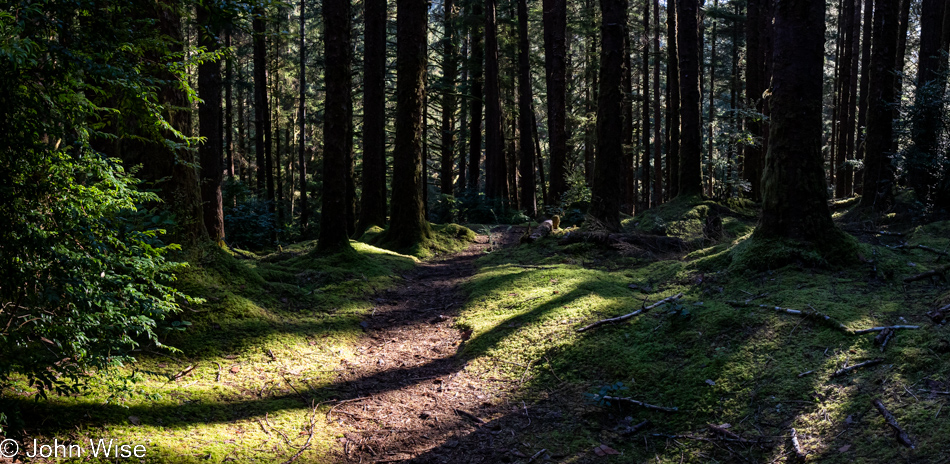
Why can’t we humans find a way to live in such harmony with our environment as the elements of sun, soil, plants, and creatures do? How is this so wild for our senses that we must denude it and then plant grass over the top of it in order to bring uniformity, sterility, and ultimately a sense of death to the places we inhabit?
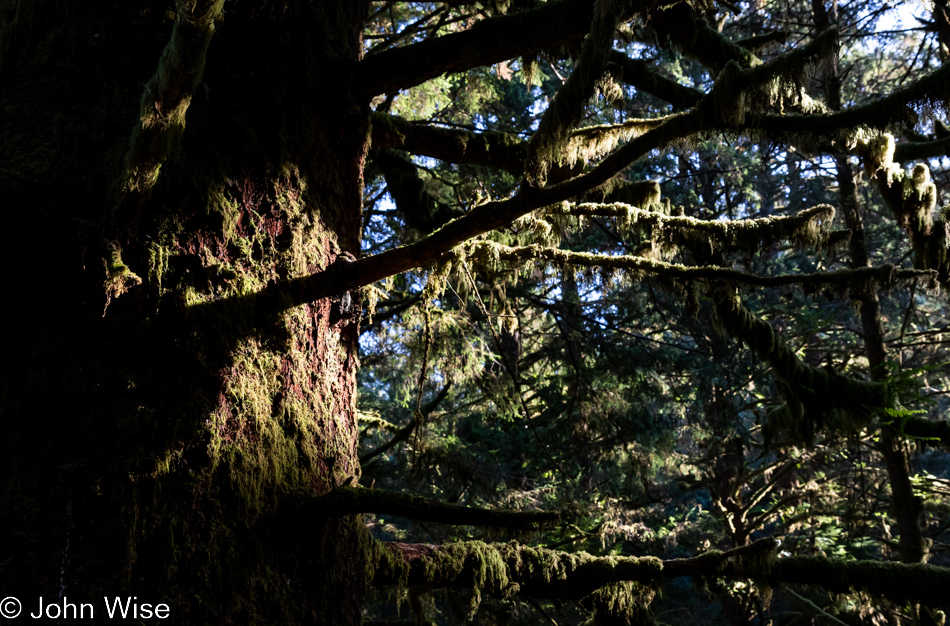
This visit to the China Creek Loop Trail has probably seen us more unprepared than any previous visit, for had we known just how deserted the forest would be, we would have been well advised to bring a blanket in order to lie here and take it all in for hours undisturbed by anything besides our own biological needs.
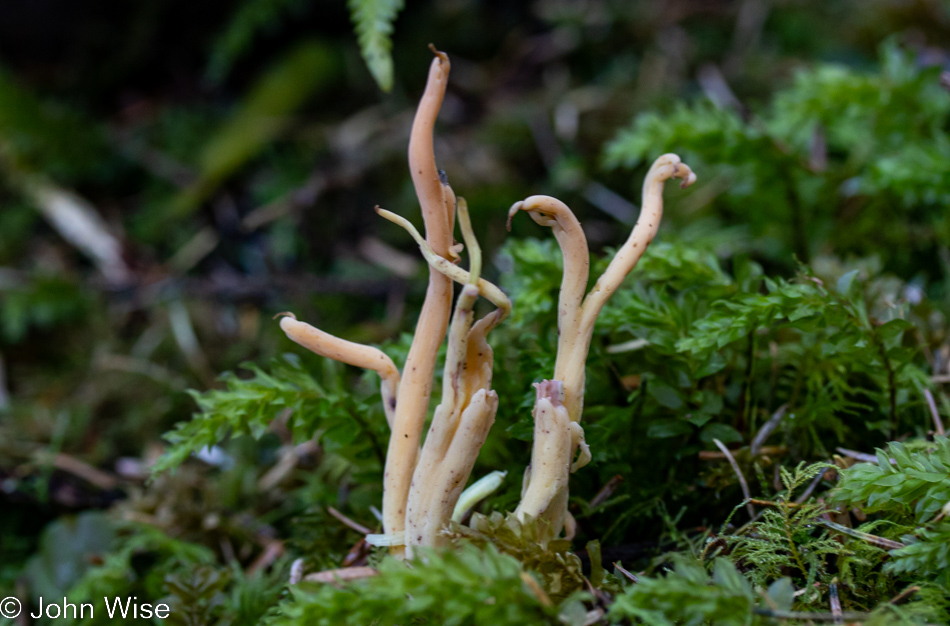
White Worm Coral Mushroom is not to be confused with Ken Russell’s film Lair of the White Worm.
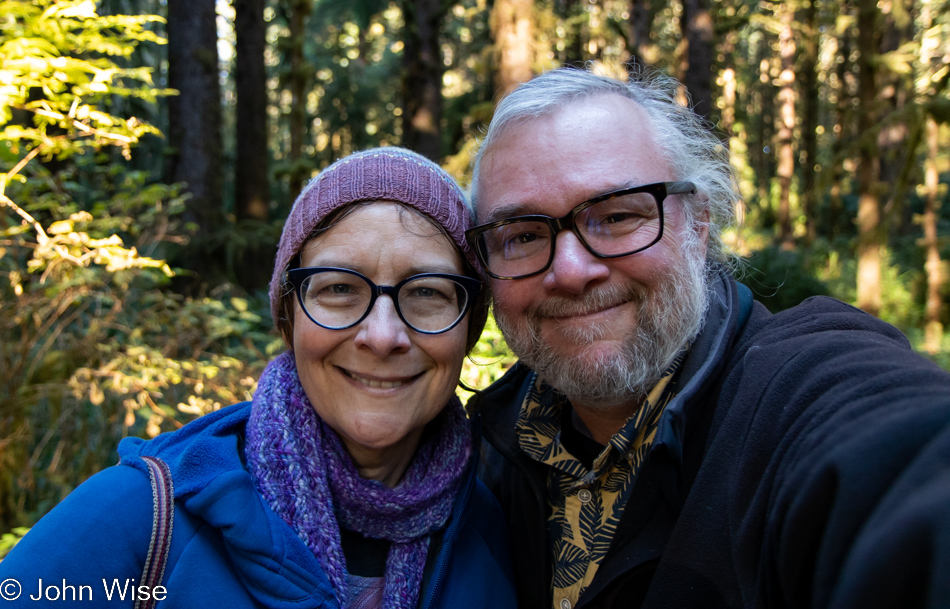
Two old friends find solemnity in a wonderful forest of grace and enchantment.
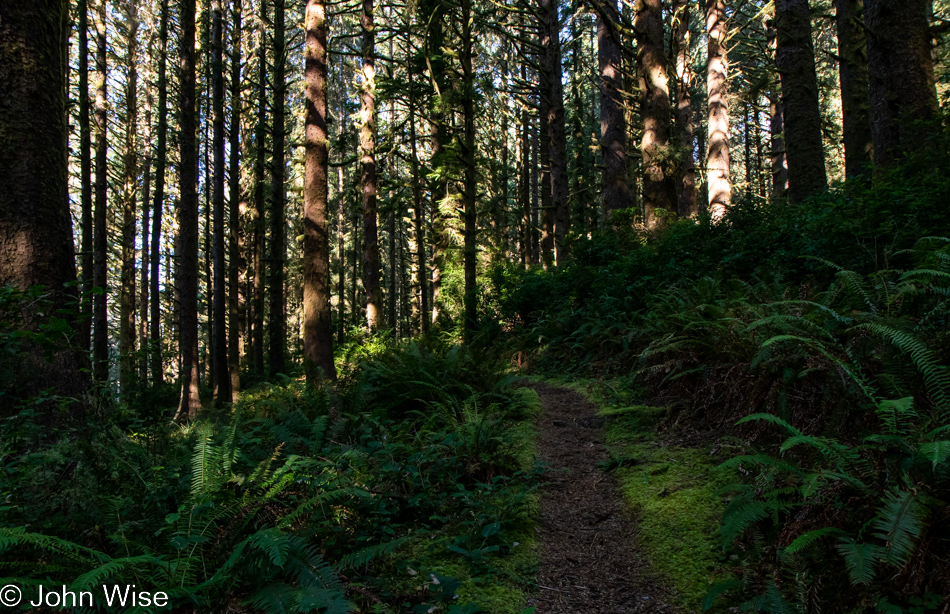
I know this curve and believe we are approaching the broken bridge. We’ll soon have to turn around for the indulgence of experiencing the trail a second time in just one day.
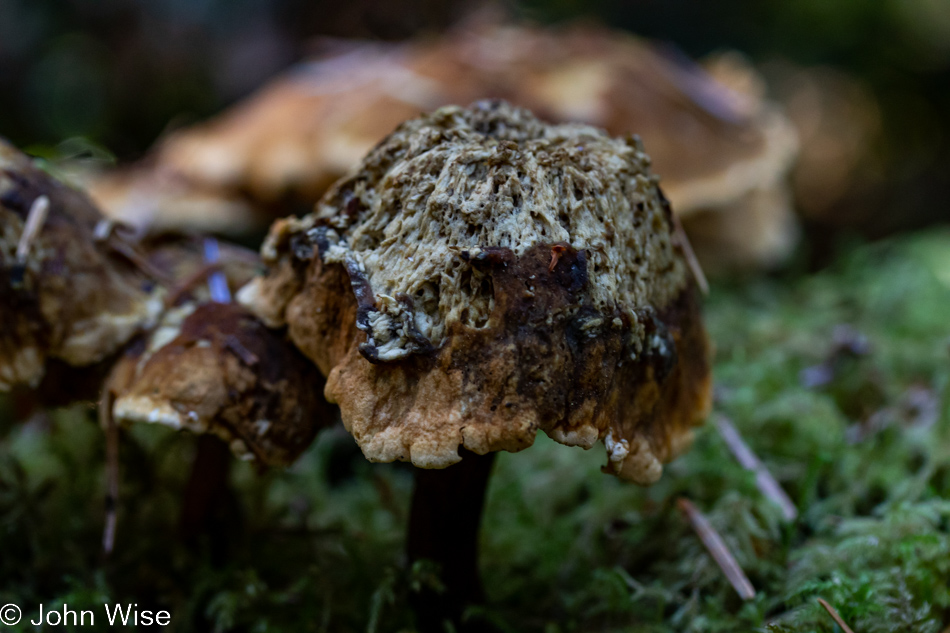
The pallor of corpse skin draped over this mushroom screams poisonous, but the eye of curiosity says stop and take a memory home with you.
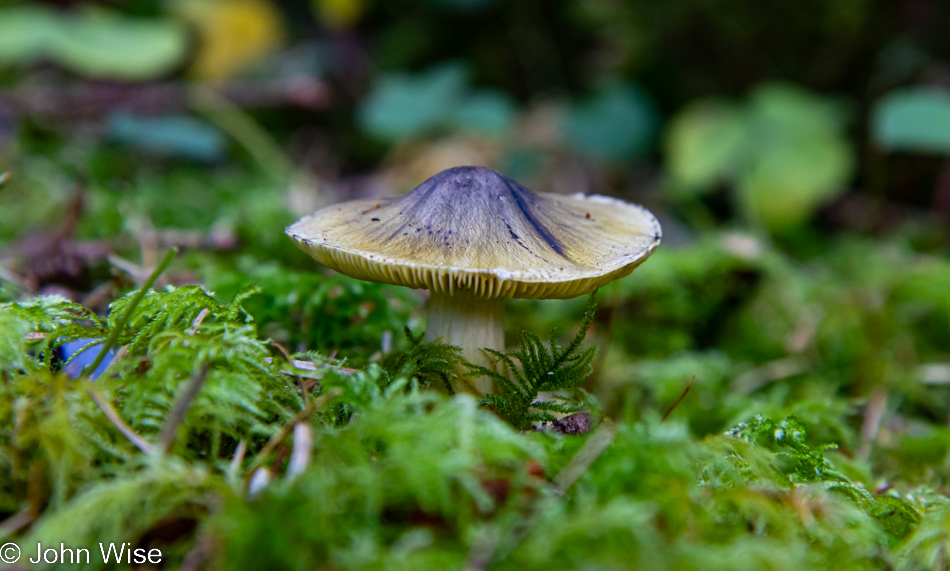
What you don’t know about these posts, especially one where there are more than 60 photos, is that I often struggle to write something fresh in the narrative, as it is my task to write at least a little something about each image I post. At this point, I’ve already written 15,000 words that are published in the previous days’ posts and in today’s post so far, while in my handwritten notes, I’d guess there are nearly 7,000 more words waiting to be transcribed. If I follow my pattern, this 11-day post will end up being approximately 35,000 words long. It’s easy to have doubts if I’m using my efforts to the best of the time I have available and if I share anything new at all, but then Caroline reminds me how I never tire of these photos featuring many of the themes we’ve seen countless times before. So, like photography, where I shoot 5,000 images to hopefully have 400 at the end of a trip that I’m in love with, I’ll just keep writing these verbal snapshots, and if from 35,000 words, I might pen I have 2,500 that are tremendous to me, then I’ve won, and this ends up being deeply meaningful.

At times, it seems that the mushroom cap is effectively the face of these fungi, at least as far as wild mushrooms are concerned.
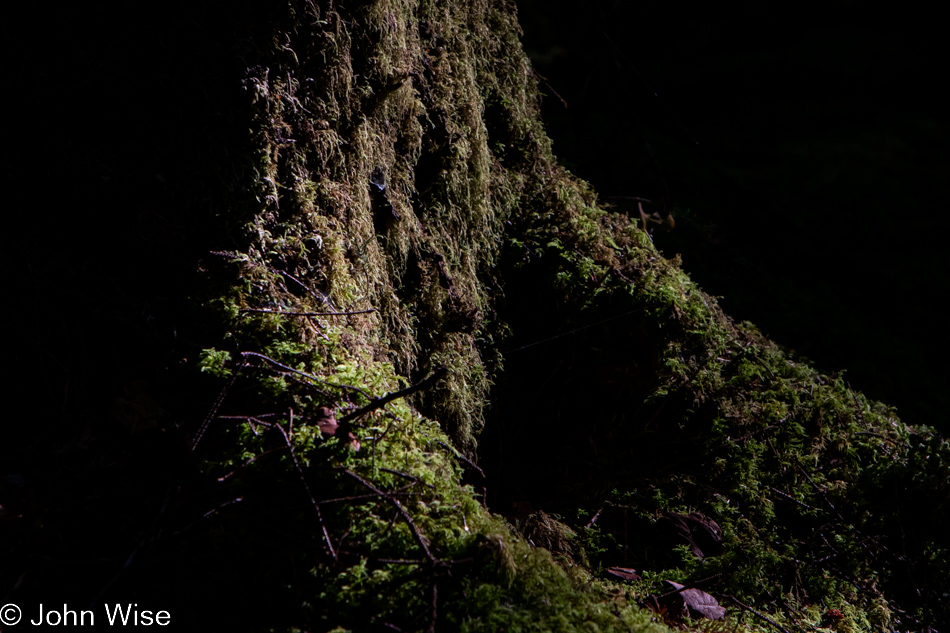
I’m well aware of what it means to be sentient, and I hope I remain rational enough not to want to imbue the inanimate with such qualities, but when it comes to trees, plants, and the earth’s creatures, there’s always this creeping sense that I cannot be fully certain that there isn’t something there at a level of os sentience I cannot fathom. Sure, it might just be the idea that I’m projecting myself into the position of thinking, “If I were this tree sitting in the forest, I’d….”
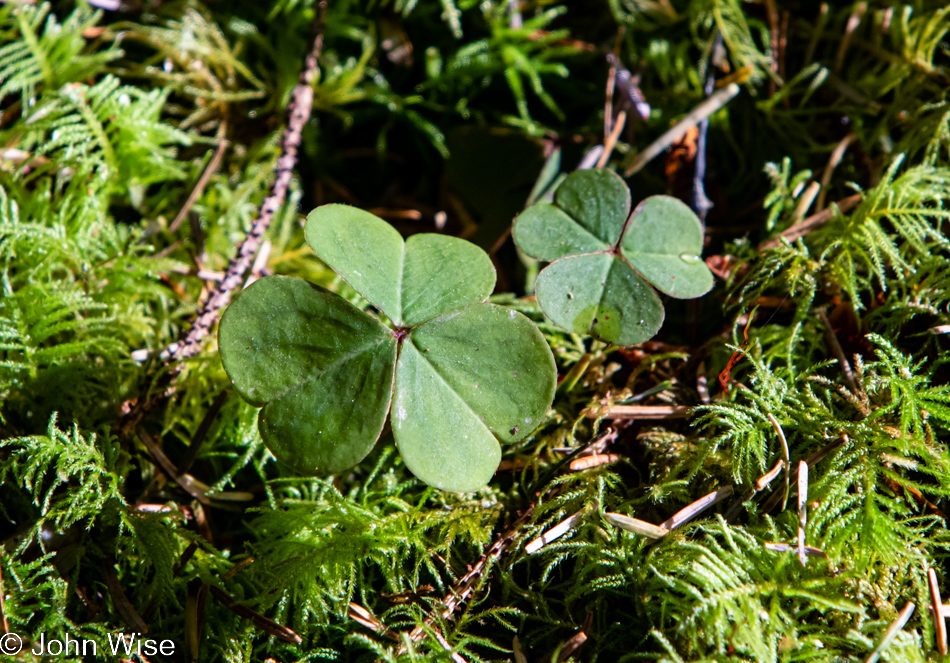
As our species has understood so little during our time on this planet, I can’t help but wonder how much more there is yet to know as we try to portray our knowledge as being full of absolutes.
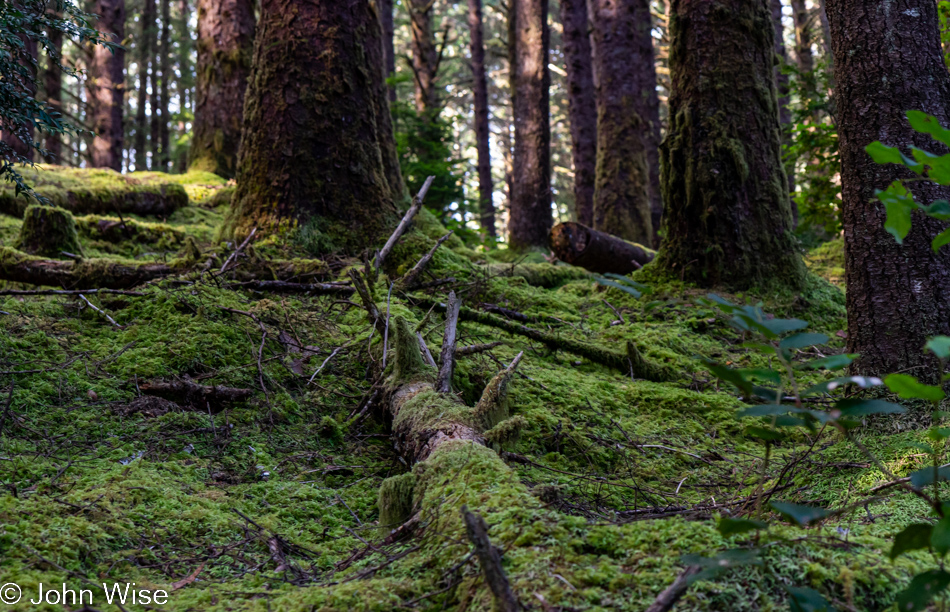
Everything that has preceded our arrival on earth was obviously instrumental in laying the foundation that would usher in humans, and yet each of those key pieces is at risk of extinction, in large part due to the heavy hand we wield without discretion when we feel we need something that improves our brief existence. While I cannot tell you what the exact utility is of a carpet of moss in a coastal rainforest environment, I do know that I find it aesthetically wonderful, and my senses would be crushed if one day I were to arrive for a return visit and this had all been clear cut or burned off the face of our planet. Come to think about it that is exactly what we are doing in countless places.
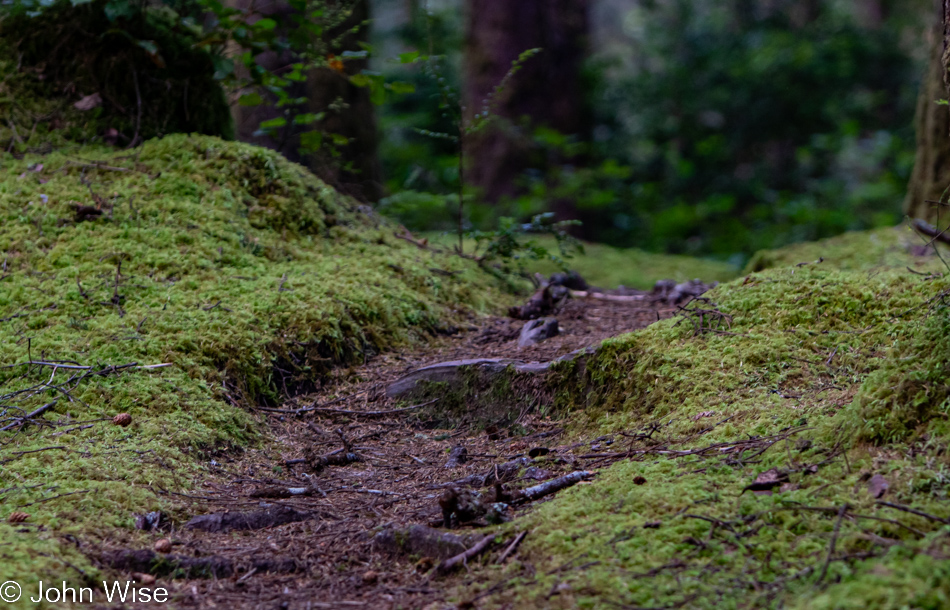
I understand the need to use lands to cultivate the products or mine the elements we need to sustain us, but we are not treating our planet as we would our home. If this were your toddler’s favorite place to play in your backyard, you’d want to forbid an entity from coming in to scrape all of these fragile details out of existence in order to make a company already worth billions an extra milkshake under the guise that even those poor souls in faraway land “XYZ” should have the opportunity to taste a milkshake too. Maybe we shouldn’t all have a milkshake at the exact moment we want it, and instead of giving in to instant gratification, we should help people understand that if we remove all that is beautiful because Joey doesn’t have a McMansion-size playground in his backyard, we’ll soon have none of the original things earth offered us that started the lessons of what was essential and beautiful.
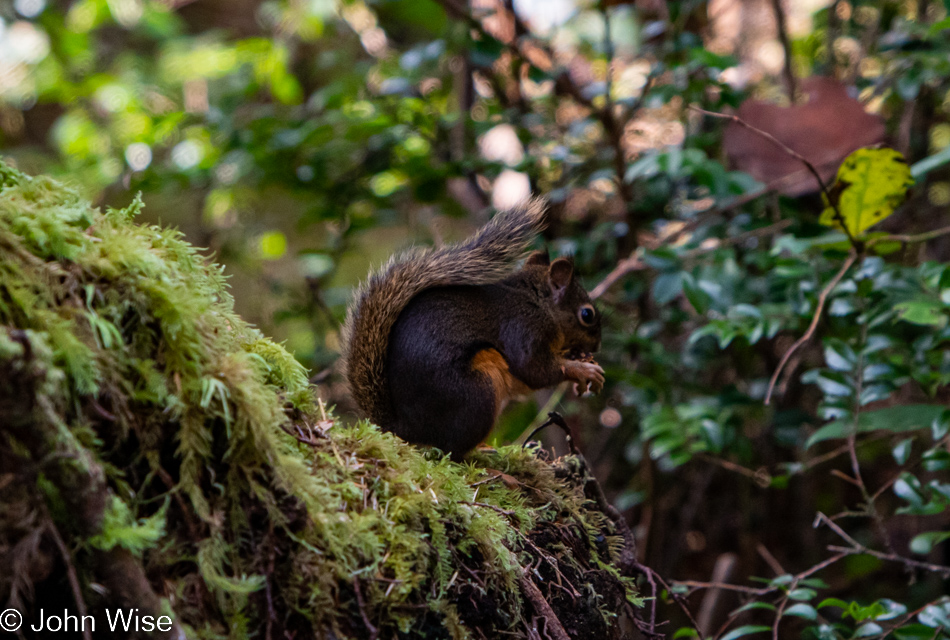
Mr. Squirrel would likely agree with me.
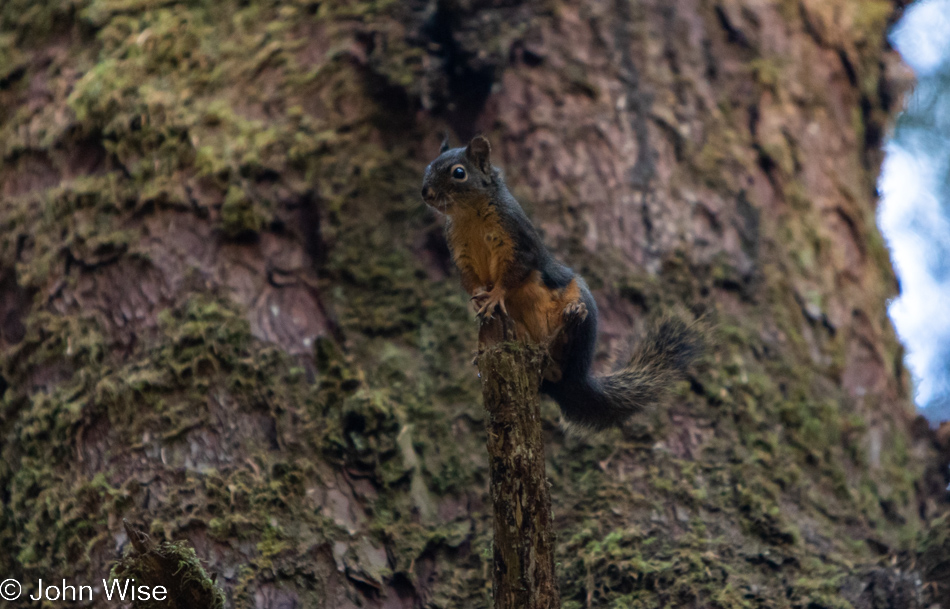
The bridge we would typically cross at the start of the China Creek Loop Trail turns out to have been impassable going on a year now, and it shows. We’ve never seen squirrels in this forest, nor could we hear as many birds, so the implication is that without us humans, wildlife is returning to the area. Regarding our observation that there were no newts out here at the ranger station, we learned that this was due to the dry weather, which would also explain the relative dearth of mushrooms in comparison to previous visits.
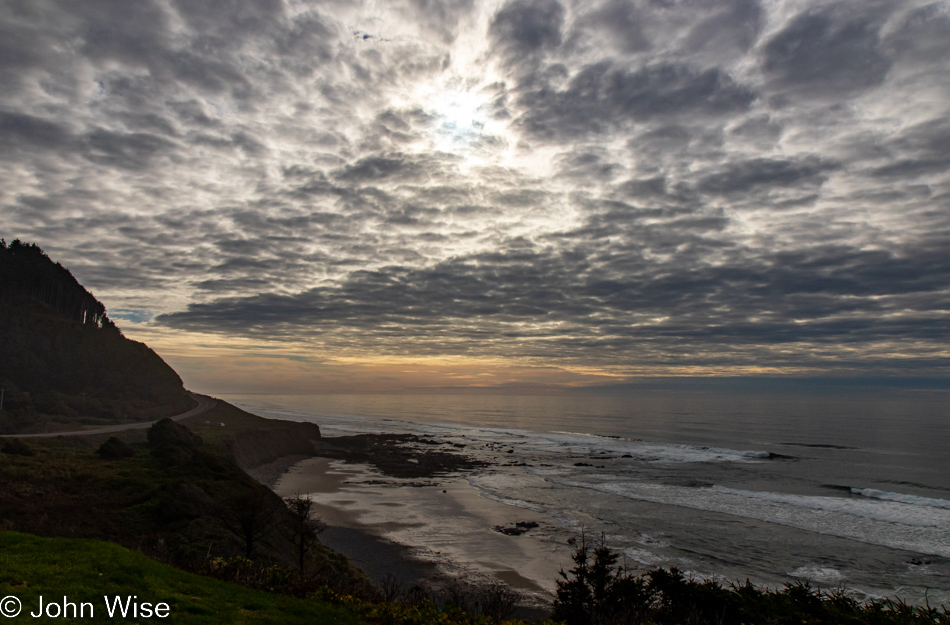
For the astute with a keen sense of spatial awareness, they will notice that we are obviously no longer in the rainforest. As a matter of fact, we have returned to the Shags Nest for some reason or other. As we left Washburne, the idea was that we’d visit the Devil’s Churn and then continue up the road to Luna Sea restaurant for lunch.
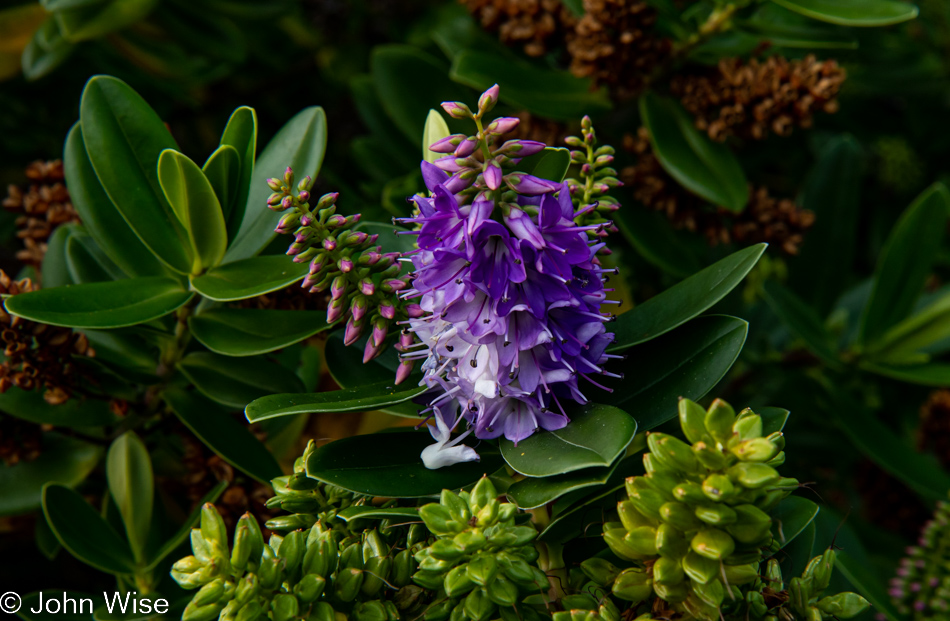
Those plans were fungible with other plans as no matter the direction, we’d still be at the ocean doing things we love, and so instead of a left turn heading north, we went to the right to pay a quick return visit to Tokatee Klootchman should the light of day make the short descent any easier.
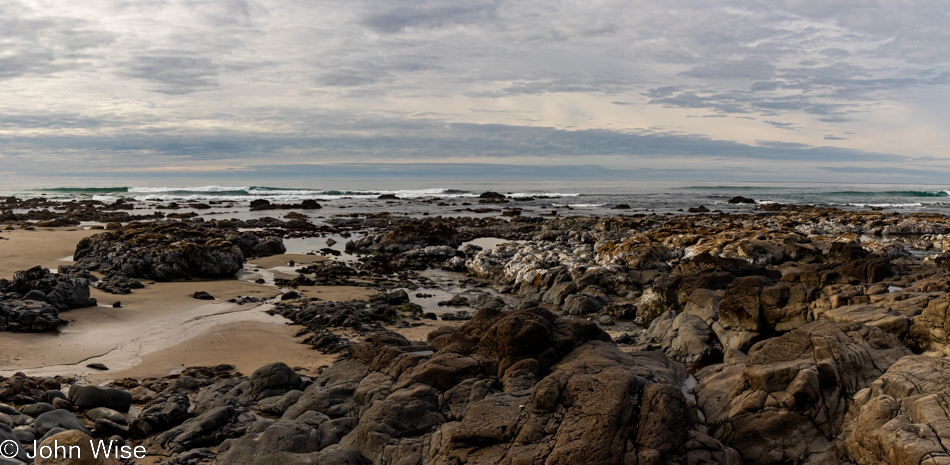
Our idea here at Tokatee Klootchman, oh how I love that name, was to negotiate the steep trail down and find a way to scramble over the rocks to get over on our side of the beach below Ocean Haven and try our luck at ascending the cliffside access trail back up to the Shags Nest followed by walking down the street back to where we left the car or with my fear then conquered, we could just return the way we came. Nope, couldn’t find a way over the rocky outcropping with the Tokatee Creek running right through it.
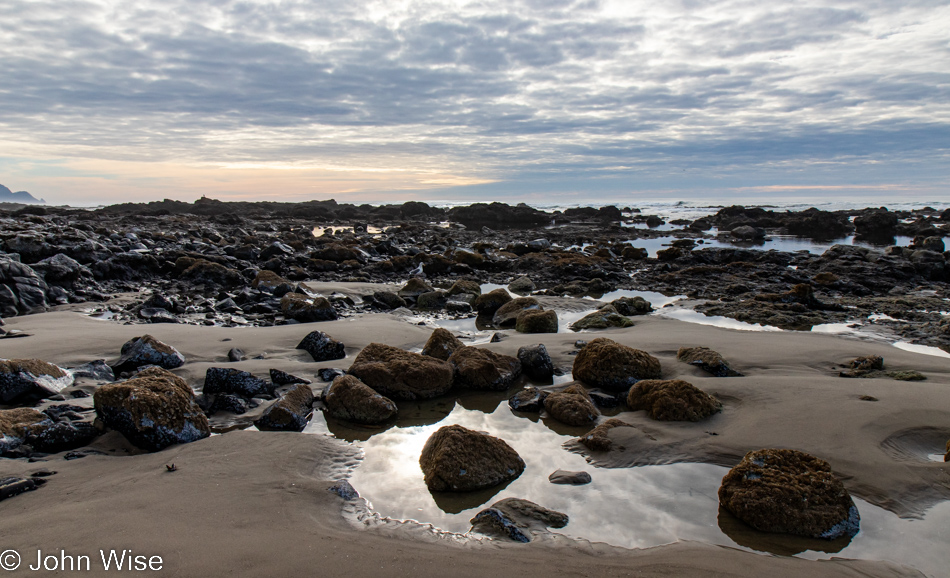
Might as well see what’s here.
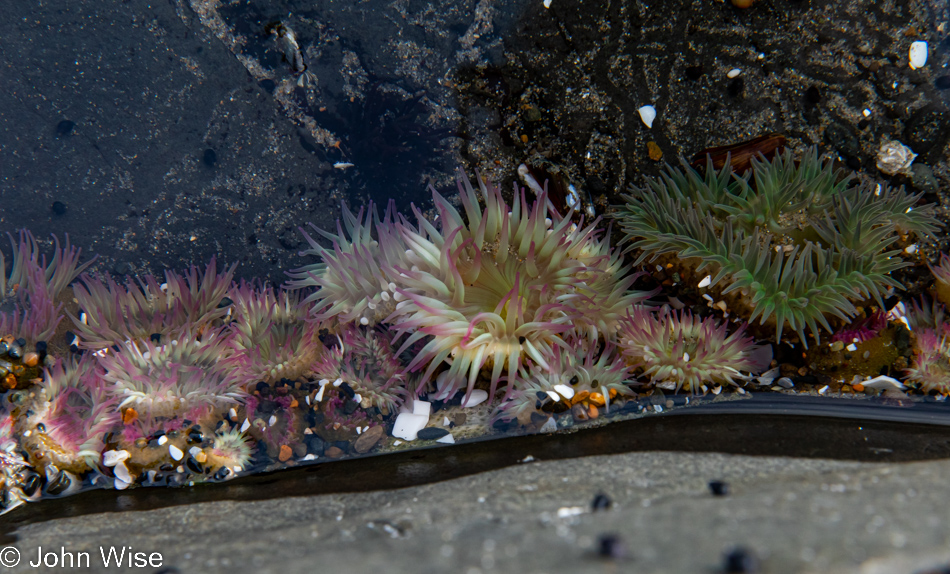
Oh, it’s a forest of anemones in an aquarium-like setting, except it’s the ocean.
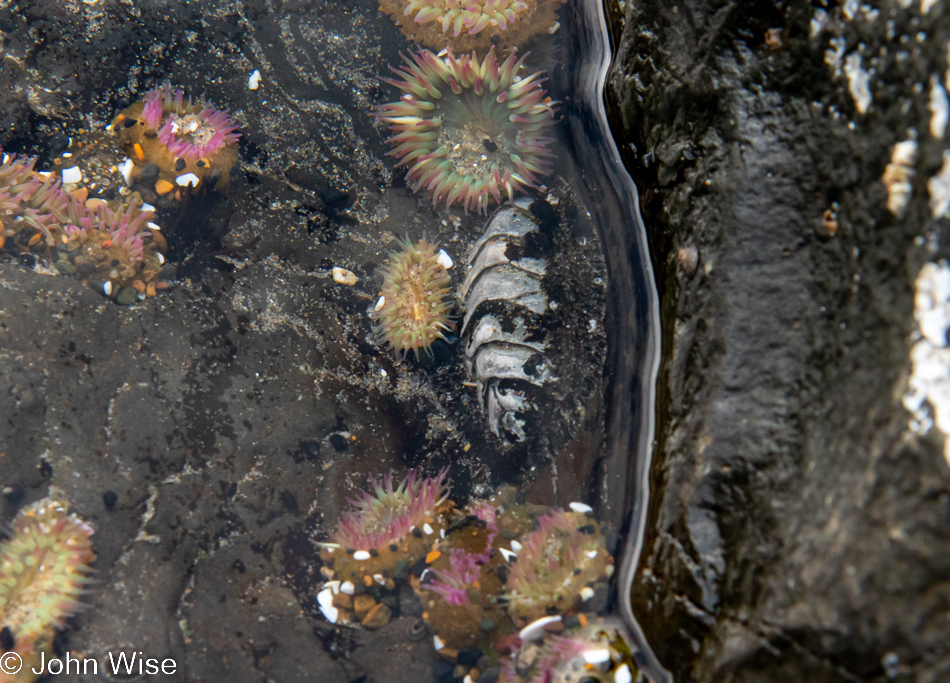
Sure, there are more anemones here, but the center of my focus is on the chiton, a.k.a. gumboot, a.k.a. Loricate, which, for some reason, has me thinking about the Lorax from Dr. Seuss.
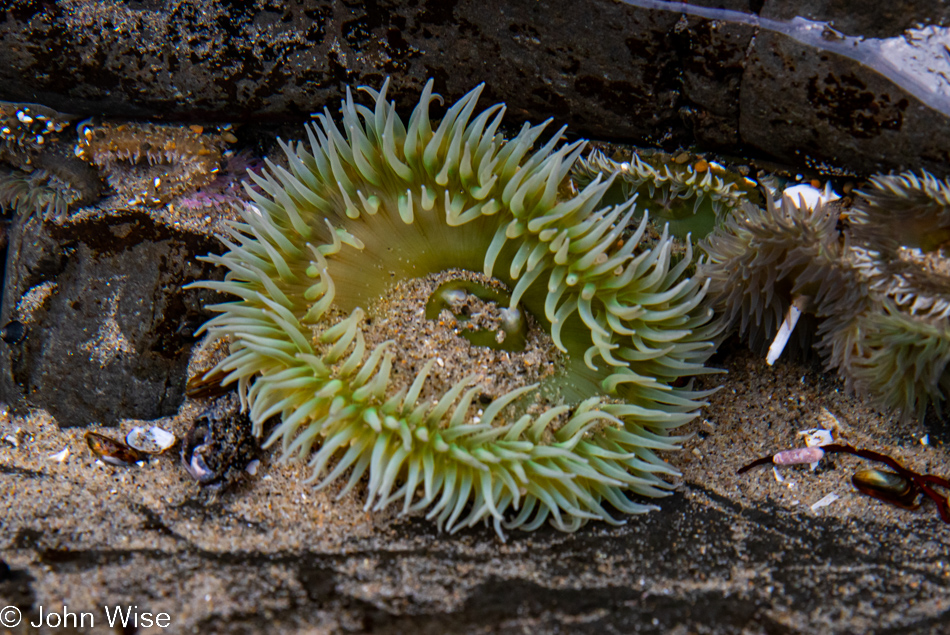
I could simply write that we’d seen an abundance of anemones on our walk through the rocky shore but when a picture speaks a thousand words, this sentence just got a lot longer with the inclusion of yet another image of an anemone.
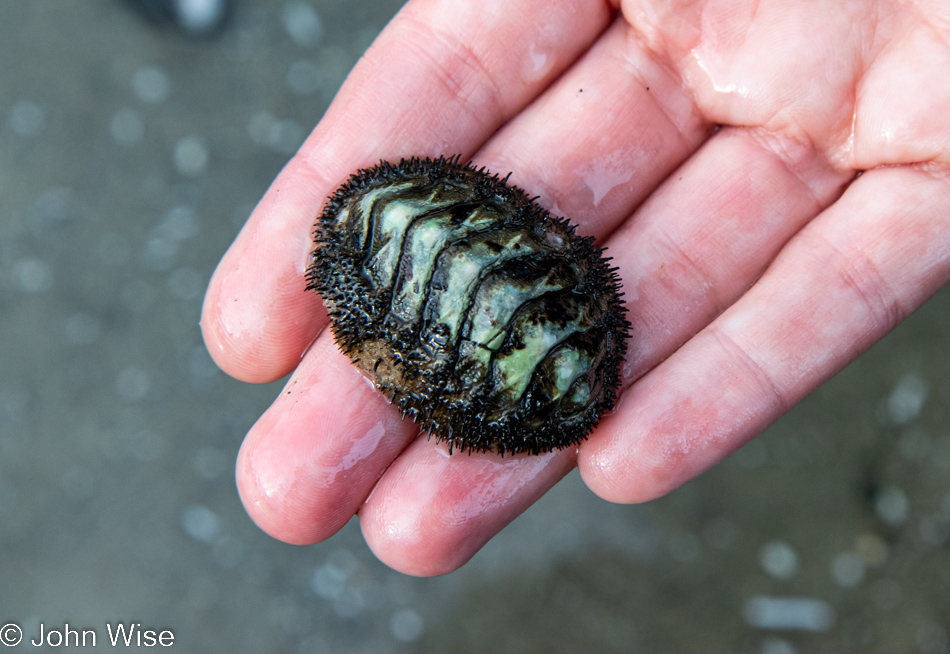
One of 940 different recognized types of chitons, how many will you hold in your lifetime?
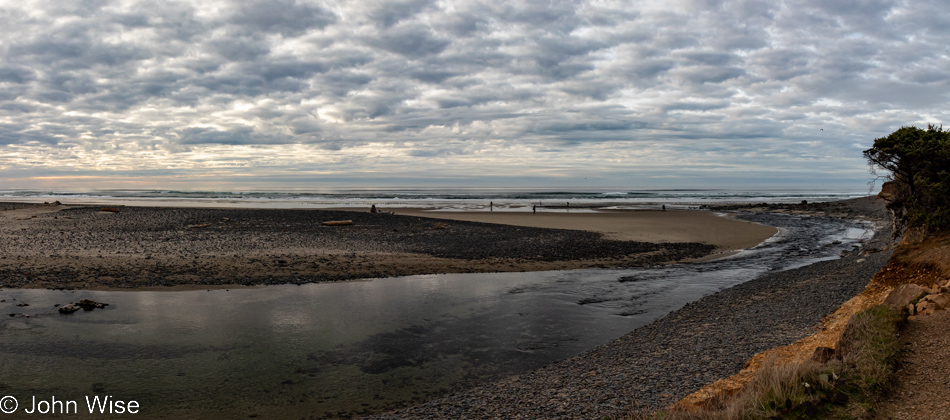
Leaving Tokatee, we were now ready for lunch, right up until we saw the sign for Ten Mile Creek and thought, we should make a quick stop here as we’d never visited this place before. With it right next to the ocean, we’ll only be a minute. Well, we were there less than a minute as we didn’t feel like crossing the creek and getting around to the right looked to be a hassle, so we went back to the car and off to Luna Sea for some fish. That was until we saw that Ten Mile Creek’s sign marker specifies this as location 85 while Tokatee Klootchman was number 87, so where is location 86?
Note to Caroline for future reference: we wouldn’t have needed to scramble down the rocks and cross the creek, there’s a small trail sliced through the trees that take visitors to what is the north side of Stonefield Beach.
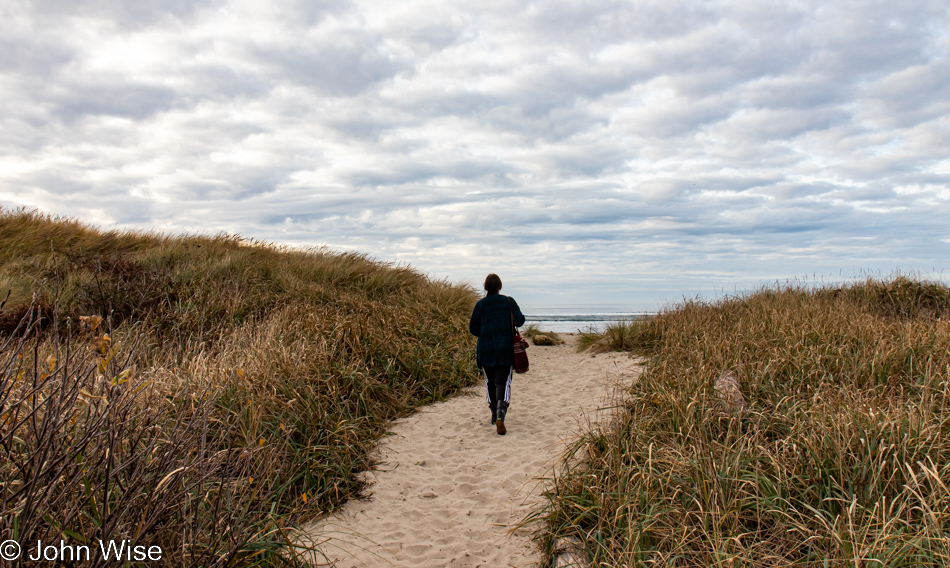
About 50 feet south is the small driveway to a parking area for maybe half a dozen cars serving location 86, known as Stonefield Beach.
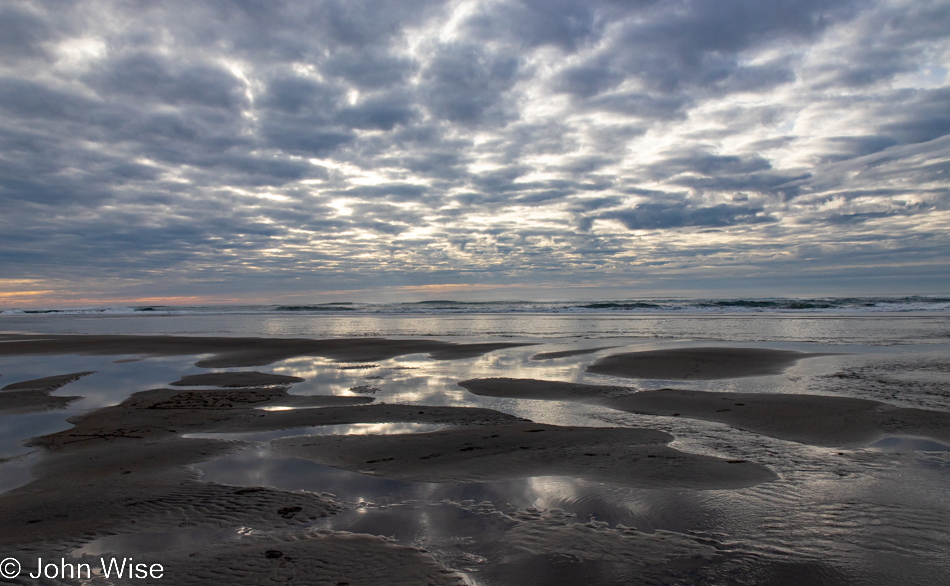
There were more than a few people down here, with most everyone congregating near Ten Mile Creek. Feeling they knew something, we joined them, and sure enough, the reflections in the shallow water on the beach were beautiful. While it was obvious that we were here at low tide, we didn’t fully understand just how low it was.
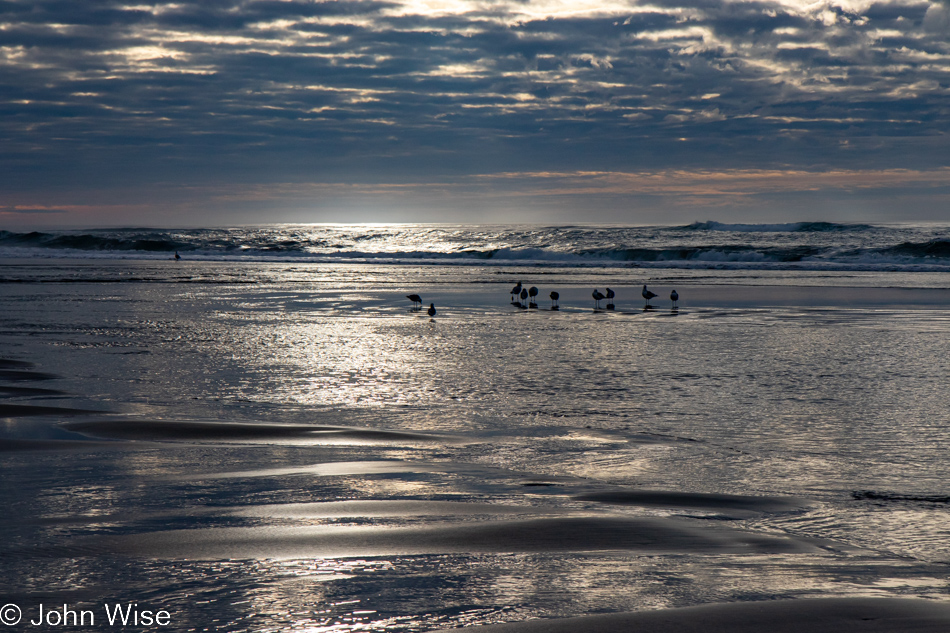
So we continued to walk along the shore, admiring the glistening water as we strolled to the south with no urgency to reach anything in particular.
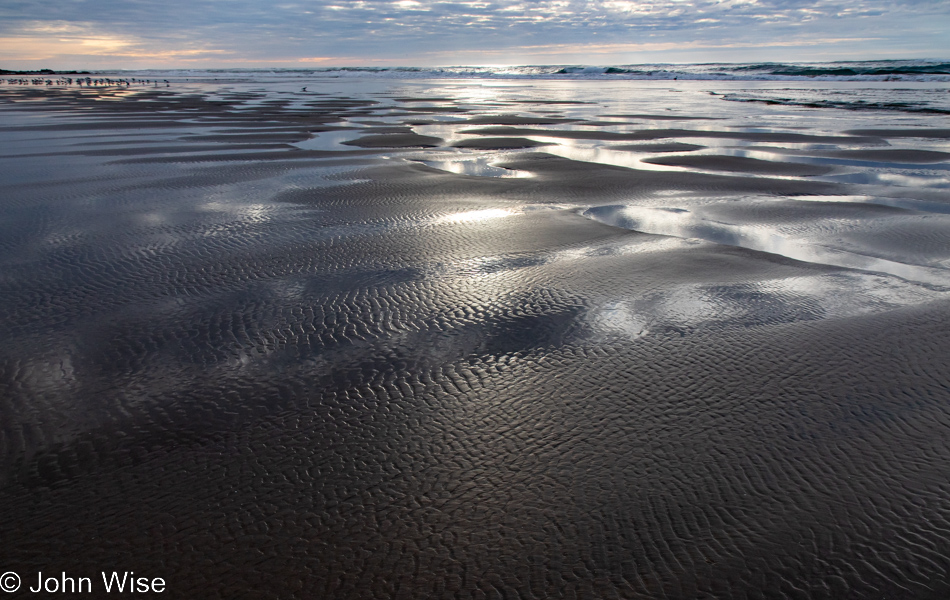
To the best of our recollection, we’ve never visited Stonefield Beach before, so our expectations are zero, and we simply take our time to enjoy our first encounter.
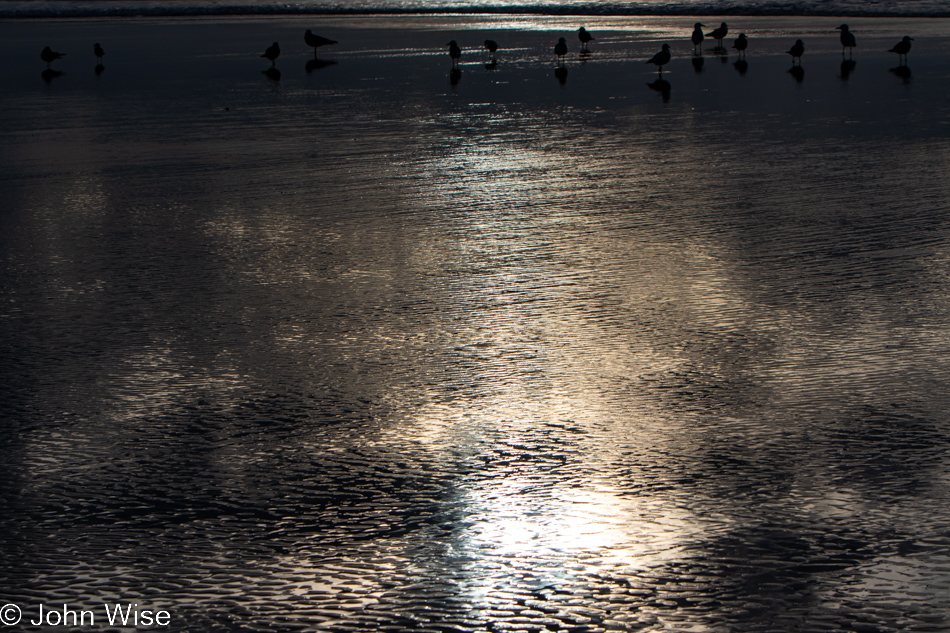
These wide, flat expanses, or somewhat textured as this one is, are certainly on our list of favorites because when they are wet and reflective, we love seeing the sky mirrored in the surface below.
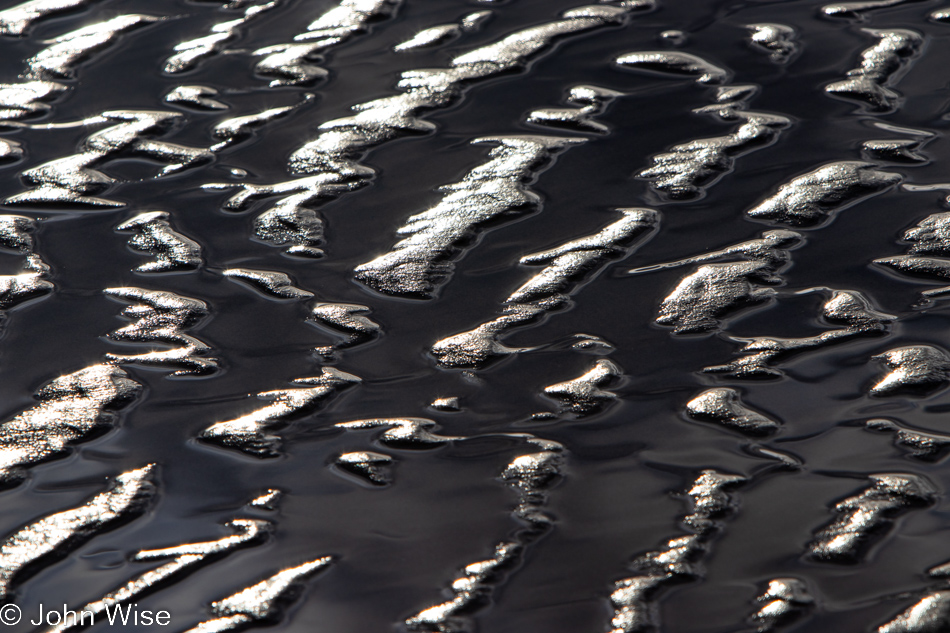
Keep changing your perspective; what you gaze upon becomes another essential part of how you’ll interpret reality, but if you only see things for how you think they are at first glance, you’ll miss the nuances that might alter your certainty that you’ve seen and understood all there is to be known.
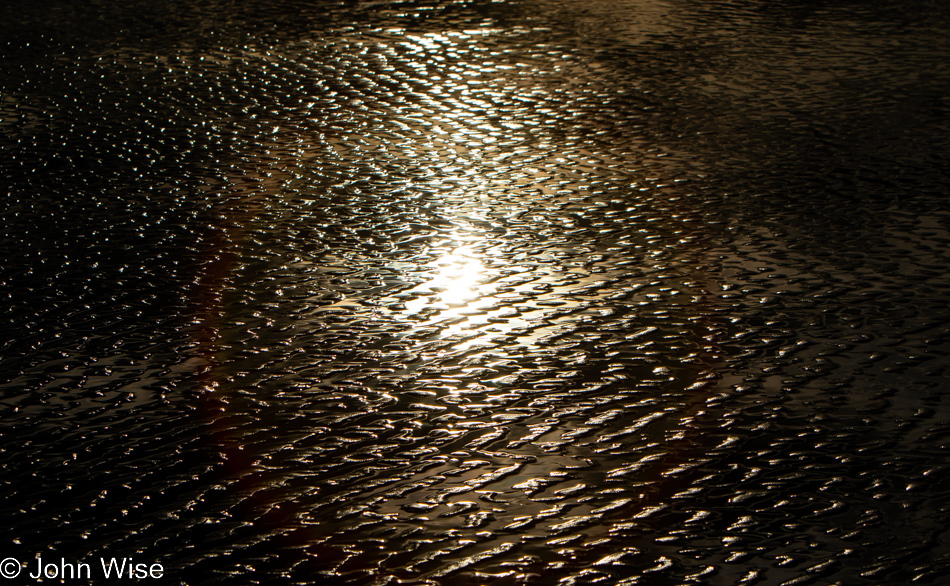
If I’m being redundant, it’s only because I want to bring everything home with us.
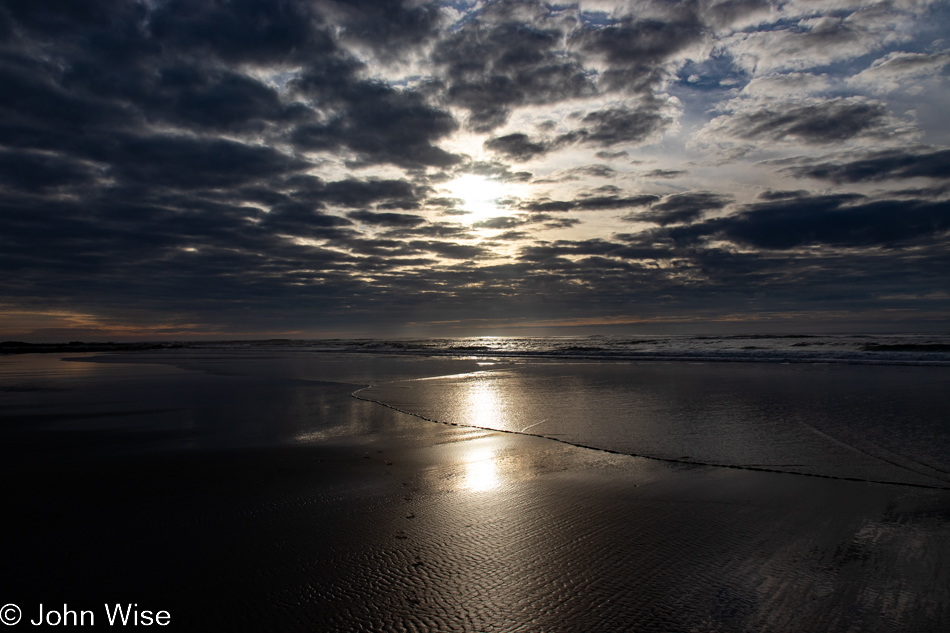
So here we are, approaching what might be a good turnaround point to head back to the car as it appears that the sun will soon disappear behind a thick cloud bank, dashing hopes for a spectacular sunset, but who cares? We’ve already had a tremendous day with unexpected great weather. But we’re close to the rocks that failed to attract anyone else’s attention, and Caroline wants to investigate.
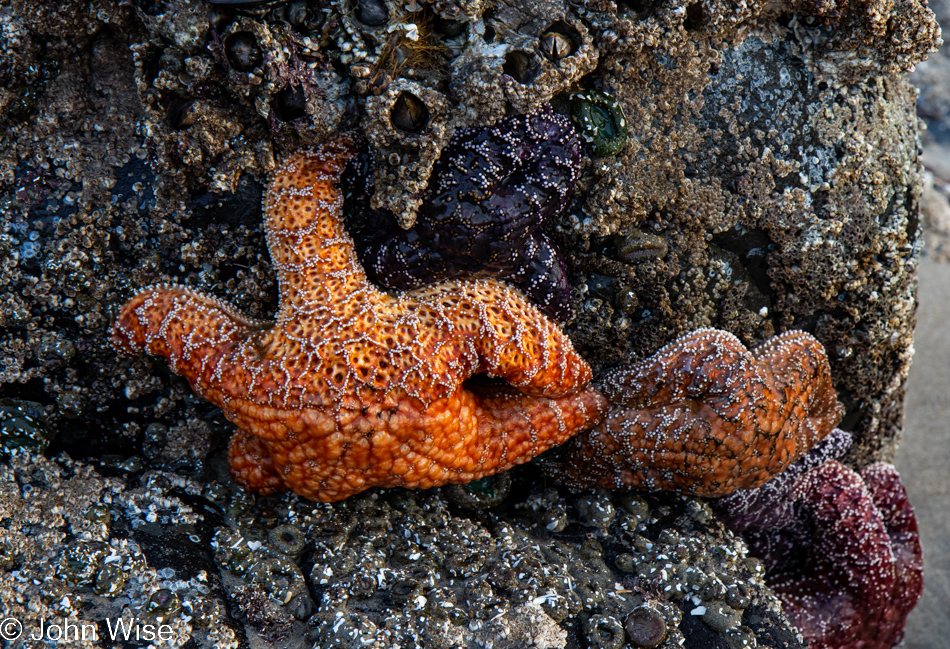
Whoa, the tide is so low that the entirety of life in the ocean is being exposed, all of it! Why oh why were those people near the creek, and nobody was down here? This is like the beginning of an entirely new day of experience.
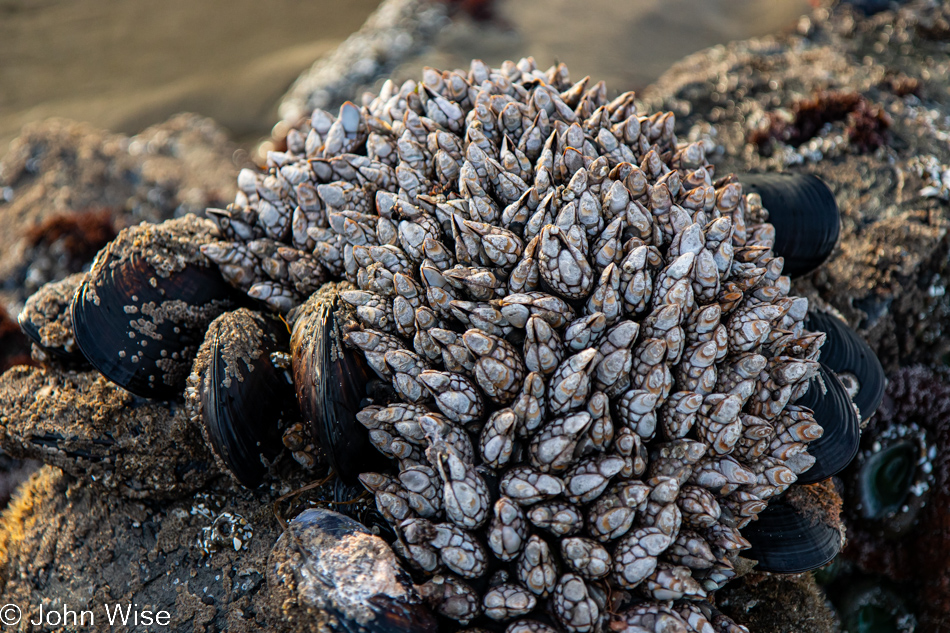
A negative tide has exposed a huge swath of ocean floor, and we’re down in the middle of it. Astonishing is a weak description of what we are ogling; nothing in our previous experiences of low tides comes close.
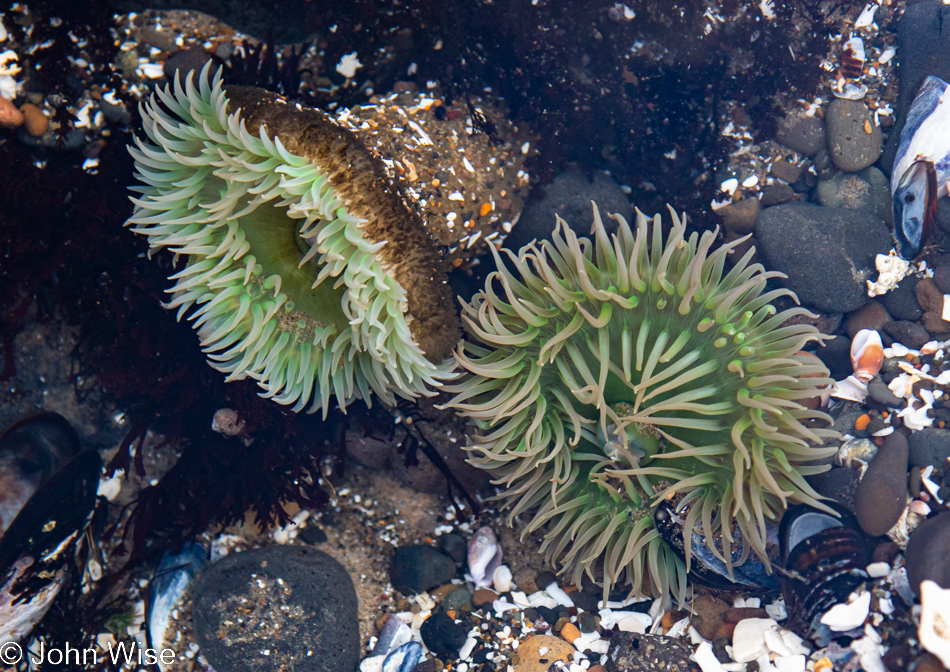
I’m going to make my life here easier, and instead of trying to find something profound to share about anemones, these two are husband and wife, and after having moved here back in the early 1950s, they are now in retirement, having spawned thousands of little anemones over the past 77 years. Now, in their sunset years, they just kick back, swaying in the waves, happy to have lived such wonderful lives on the Oregon shore where the waters were always cold, and people stepping on them were kept to a minimum.
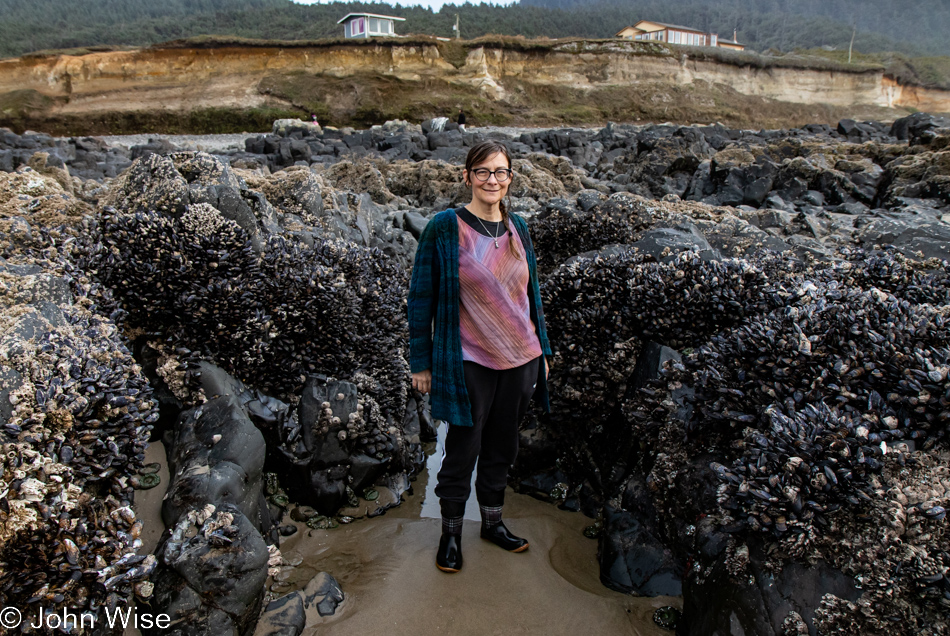
There’s no way of knowing how many gazillions of bivalves, anemones, barnacles, and sea stars we are seeing. Maybe we could have counted the sea stars, but we’d have ultimately been drowned by the return of the ocean to take back what belongs to it; this does not include my wife.
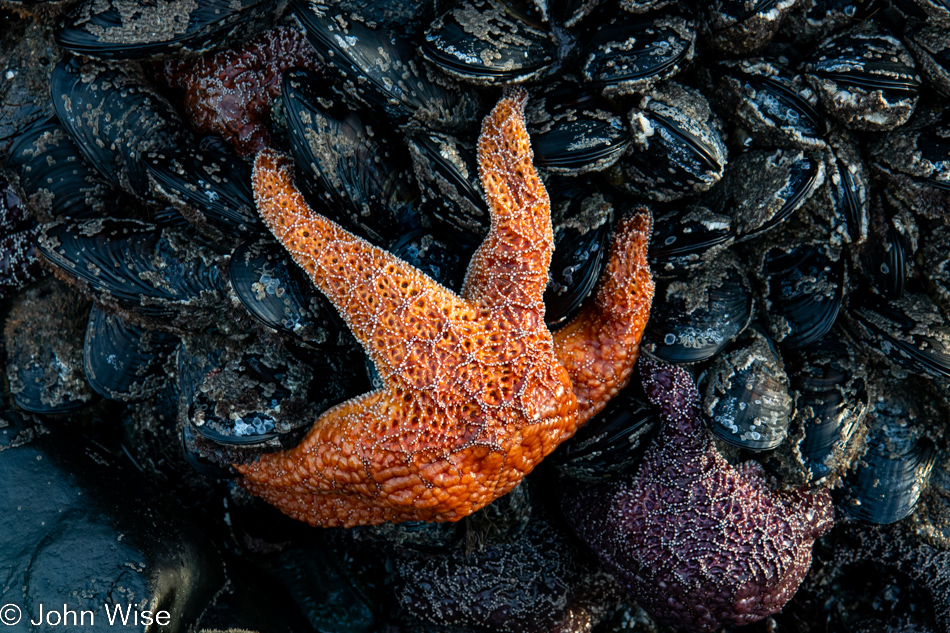
When we see sea stars, they are typically firmly attached to something, just like this giant orange star holding fast to the rock and mussels that are temporarily hanging out above the world they normally live in, that being the ocean. Returning to subjects captured in my photos time and again, I need to stretch in finding something worthwhile to say about what I feel compelled to share and so it is with this beautiful specimen. A simple search for interesting facts about sea stars taught me that not only can sea stars reproduce sexually, but they can also reproduce asexually. While a sea star can regenerate a lost limb (this I knew), that broken-off wayward limb, if detached close to the body, will have all of the essential organs to regenerate an entirely new sea star thus, the species is able to reproduce itself.
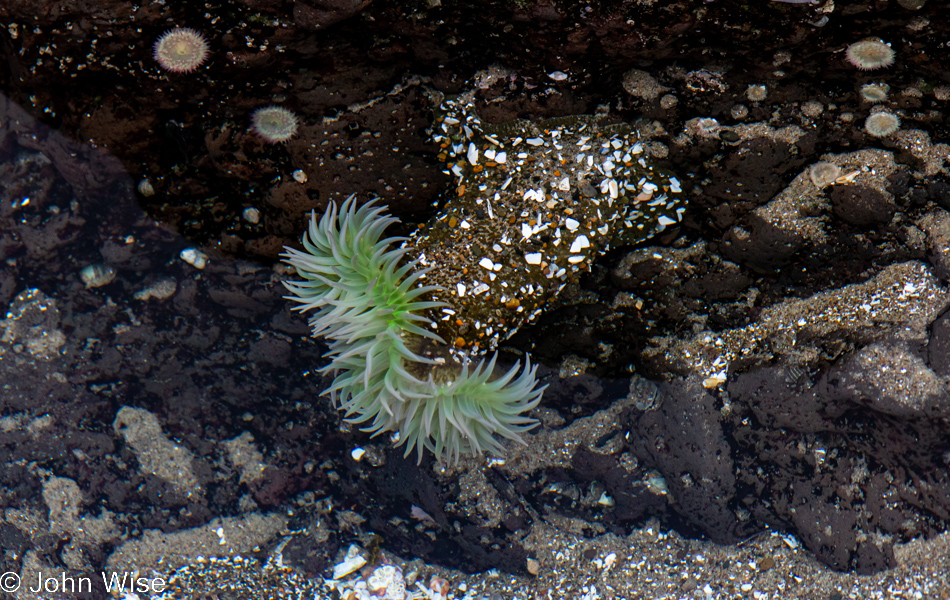
Just when I think I’ve taken too many photos of anemones, there’s that one photo that spurs me into asking questions about the anatomy of this sea creature, and it’s there that I learn that the main part of the body is called the column, but that’s not exactly what I was curious about. We’ve seen this before: the column appears to be covered with debris. This would make sense when the anemone is out of the ocean during low tide, and I’m left thinking that the receding waters distributed the shells and small stones on its body and will simply rinse away when the tide returns.
This anemone is in the water, and it was while looking at this that I finally realized that it was not the first time I had seen this kind of patterning. Sure enough, this type of anemone has sticky tubercles (a small rounded projection or protuberance) that it uses for intentionally attaching shells, sand, and other small debris. Reading the article I linked to also informed me that this anemone has fighting tentacles (usually retracted), but the truly mind-blowing lesson for the day is that in the phylum of cnidarian, there are two forms, polyps and medusae, with anemones being of the polyp type, and jellyfish belonging to the medusae type. The fact that jellies and anemones both belong to the same phylum isn’t a big deal as my knowledge of biology is nearly nil, but when the author pointed out that jellyfish are essentially untethered upside-down anemones, well, my eyes nearly popped out of their sockets. Hmm, imagine that eyes popping out of our skulls was the way humans reproduced.
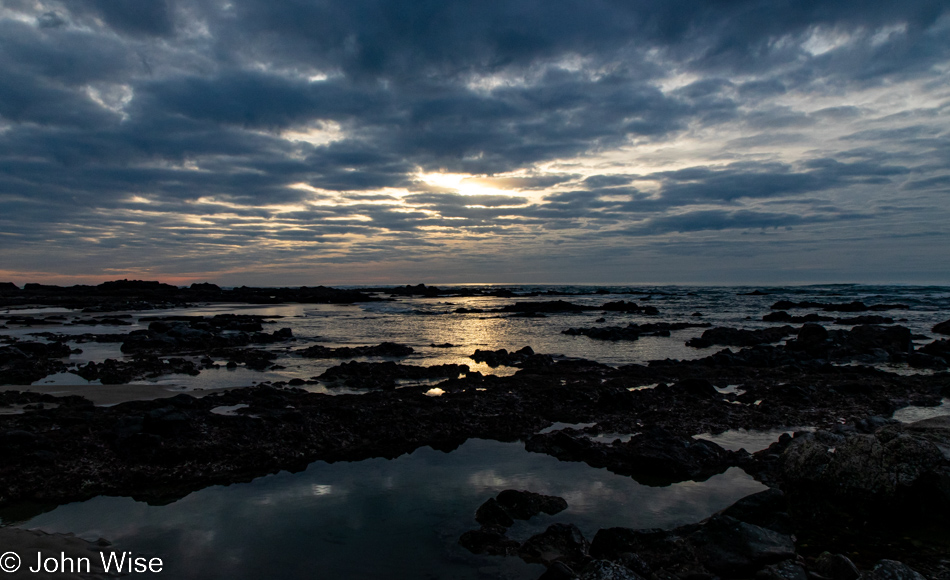
Do you see the sadness out on the horizon? That’s the face of nature wearing a wistful expression that this human who should have been able to do better has reached what is likely the final quarter of its life and only now finds the awareness that it took the creatures living near the seashore for granted. The backward idea that it was all just stuff that, while beautiful, was simply the things that were there.
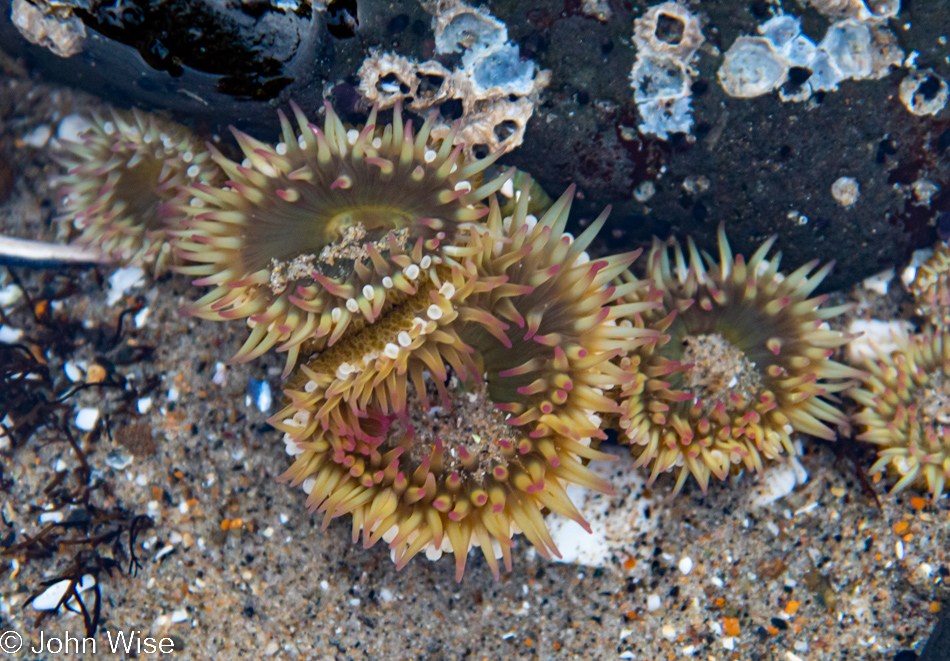
Then it strikes me: these anemones are essentially like the majority of people around me; they arrive in different colors, shapes, and ages, but for the most part, they lack intentionality, and so, while pleasant to look at, they are easy to take for granted. Their flourishes might be attractive and their forms seductive, but at the end of the day, they are attached to routines that allow them to exist, but they rarely affect outcomes. Among us humans, there’s a tiny fraction that attempts to harness deliberate consciousness to action, believing they can loosen the binds that tie them to doing things the way they were always done. Lucky us that anemones, jellyfish, and sea stars haven’t evolved intention. Then again, unlucky us that the same holds true for so many around us.
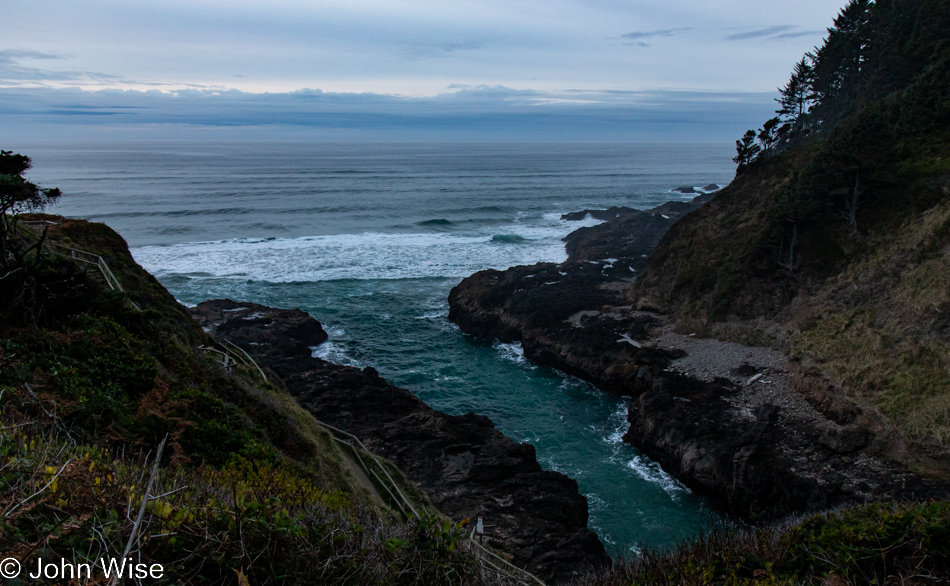
Finally made it to the Devil’s Churn, but as you can see in the waning light, the churn is calm, so we didn’t finish the walk down and instead opted to finally fetch a very late lunch / early dinner back at Ona Restaurant for our second visit. Yes, last night’s meal was extraordinary enough that we are returning for a repeat performance. Tonight’s menu must be mentioned as a reminder to Caroline and me to come back to Yachats and eat at Ona once again if we are so fortunate. Our first course was smoked local maitake mushroom pâté followed by clams in vermouth and then another beet salad, as we enjoyed the one last night so enthusiastically. For the main dish, Caroline opted for miso ramen while I took on the stuffed sole. What perfect punctuation for an exquisite day.

